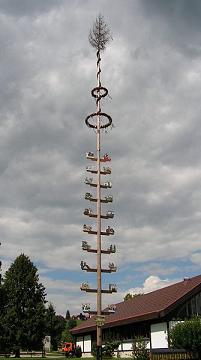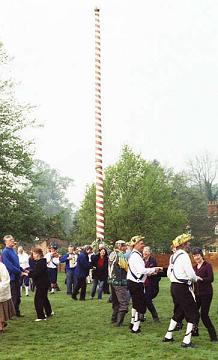|
THE WORD OF GOD
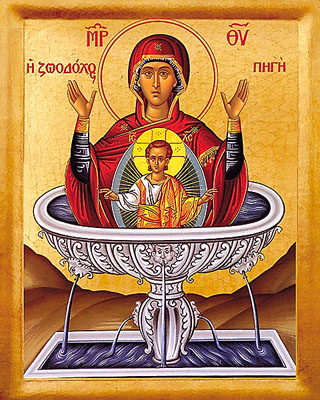
God, the fountain of living waters, (Jeremiah 2:13,
17:13).
Within the Indo-European culture exists a drink called Soma,
that is said to convey the experience of immortality, is a healer and gives absolution. Soma is also the name of two plants, one known, the other concealed, and
it
is the name of a god. The drink Soma as described in the Rig Veda, is the sacrament of the Aryans, and it is the prototype for all the great world religions use of a sacrament. It has been believed lost, but in reality it has been hid within plain sight and can be found by anyone who bothers to look for it. Thus these words.
Matthew 7:7-8.
7. Ask, and it shall be given you; seek, and ye shall find; knock, and it shall be opened unto you:
8. For every one that asketh receiveth; and he that seeketh findeth; and to him that knocketh it shall be opened.
Proverbs 8:17.
17. I love them that love me; and those that seek me early shall find me.
-The Bible.
Isis is said to have conjured the invincible God of Eternities, Ra, to tell her his secret and sacred name, which he did. This name is equivalent to the Lost Word of Masonry.
According to Christian mysticism, when the Lost Word is found it is discovered in a stable, surrounded by beasts and marked by a star.
-Manly P. Hall, The Secret Teachings of All Ages.
Jesus and Virgin Mary, marked by a star.
|
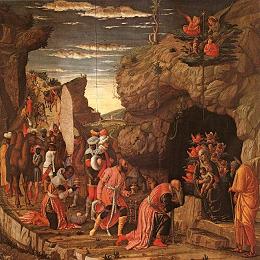
"Adoration of the magi," by Andrea Mantegna.
|
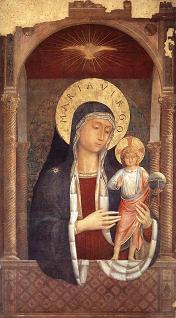
"Madonna and Child Giving Blessings," by Benozzo Gozzoli.
|
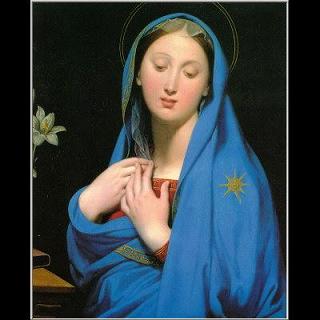
"Virgin of the Adoption," by Jean Auguste Dominique Ingres.
|
The True Word of a Mason is to be found in the concealed and profound meaning of the Ineffable Name of Deity, communicated by God to Moses; and which meaning was long lost by the very precautions taken to conceal it. The true pronunciation of that name was in truth a secret, in which, however, was involved the far more profound secret of its meaning. In that meaning is included all the truth that can be known by us, in regard to the nature of God.
-Albert Pike, Morals and Dogma.
Quoting from the Rig Veda, book 9, hymn 109.
4) Flow onward, Soma, as a mighty sea, as Father of the Gods to every form.
Book 9, hymn 80.
4) The men, the ten swift fingers, milk thee out for Gods, even thee most rich in meath, with thousand flowing streams. Soma who winnest thousands, driven by the men, expressed with stones, bring, as thou flowest, all the Gods .
-Ralph T. H. Griffith (translator), Rig-Veda.
The entheogen experience is of a magnitude that
can be compared to nothing else known to mankind and can be described as a
cosmic orgasm on behalf of God. Anything of such immensity is bound to leave a trace and this is what is followed in this little essay.
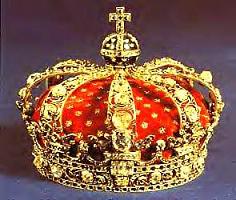
Crown from Sweden.
A part from the entheogen experience, being the King is considered the greatest thing that can happen to a human being. To become the King one must be anointed and equipped with the symbols of the coronation. The church is the institution with the authority to anoint and to coronate.
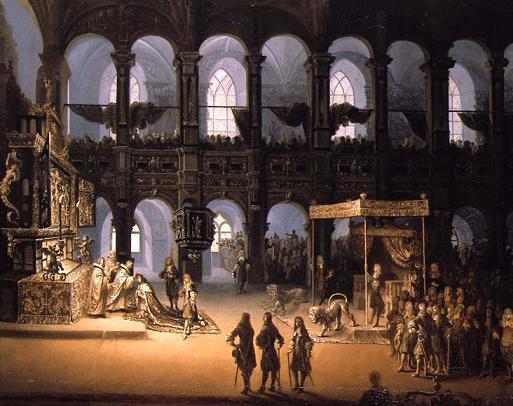
Sketch for an engraving, painted by Michael von Haven.
Here (above) we see Christian V's coronation in
the chapel of Frederiksborg Palace, Denmark, in 1671. Two lions are present in
front of the throne. The ceremony involved a third lion behind the throne, which
can't
be see on said picture. This placed the King in a triangle of 3 lions, as God, the All Seeing Eye of Horus, the Holy Trinity.
.
"Charles II in Coronation Robes," by J.M. Wright. "Virgin and Child," by Hans Leinberger.
"Portrait of Louis XIV," by Hyacinthe Rigaud.
Above, the first and the last picture are classical pictures of a king in all his pomp and glamour.
There is a lion and a unicorn on the first picture, one at each sides of the crown. The green lion, the unicorn, the sceptre, the lily, and Virgin Mary, are all symbols of Cannabis sativa
(Cannabis sativa, Cannabis indica and Cannabis ruderalis is
henceforth only named as Cannabis sativa). The red lion, the stag, the globus cruciger, the rose and Jesus, are all symbols of Amanita muscaria. On the first picture the kings dress symbolizes the male part of the sacrament and on the last the dress symbolizes the female part of the sacrament.
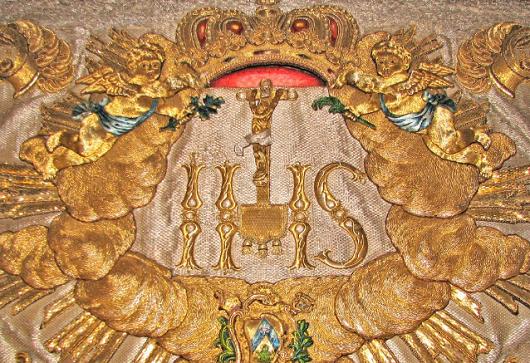
The Holy Name of Jesus Christ.
A humeral veil used by the 17th century Dominican, Cardinal Thomas
Howard, now belonging to the Dominican Priory in Oxford.
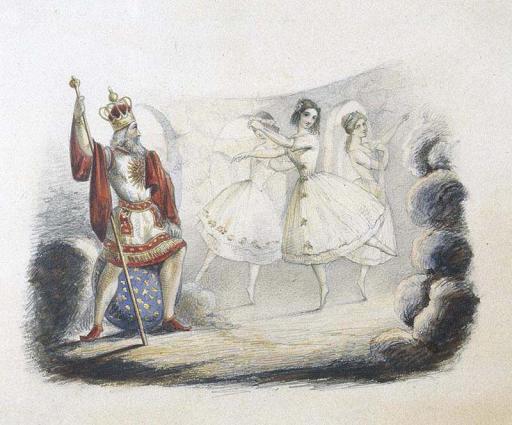
Picture by H.C. Ley, from the first performance on
Casino Theater (1849), showing the Spirit King, in the play "Meer end
Perler og Guld" (More than Pearls and Gold), by Hans Christian
Andersen.
|
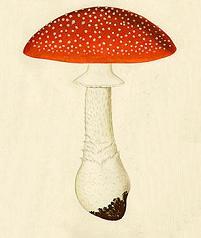
Amanita muscaria. |
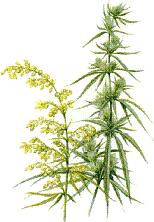
Cannabis sativa. |
As has been shown by several authors after the publishing of Soma: Divine Mushroom of Immortality, by R. Gordon Wasson and The Sacred Mushroom and the Cross,
by John M. Allegro, the Amanita muscaria is at the centre of religious reverence
among the Aryans. Their culture, a patriarchy, only honours the male part of the
sacrament as a god, this being so especially within
Christian Protestantism.
"Sforza Triptych," by Rogier van der Weyden.
"Crucifixion," by Sanzio Raffaello.
The sacrament, the Soma sacrifice, consist of two parts, male and female, the sun and the moon. The marriage between these two elements is happening within the human body, after consuming the blood of the crucified saviour, the sacrament.
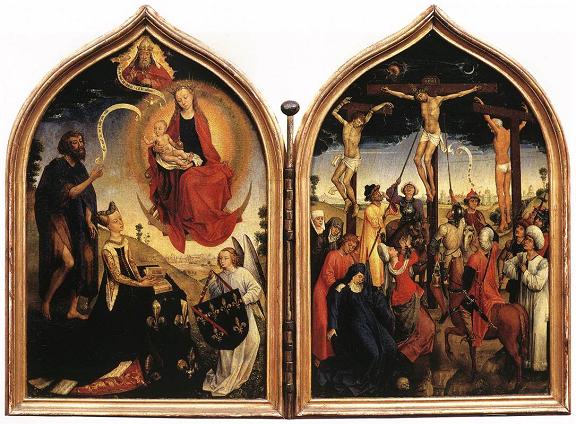
"Diptych of Jeanne of France," by Rogier van der Weyden.
Jesus is, among other things, the
anthropomorphization of the sun and Amanita muscaria, and Virgin Mary is,
among other things, the anthropomorphization of the moon and Cannabis sativa.
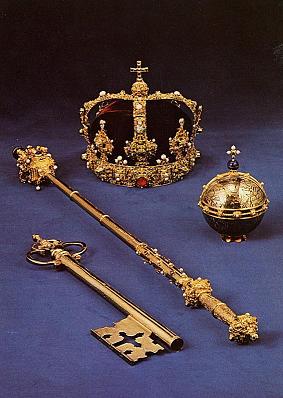
The regalia used for the coronation of King Erik XIV of Sweden.
The regal symbols are the sceptre, the globus cruciger
and the crown. The symbol of the ability to anoint, are the
two keys which St. Peter holds.
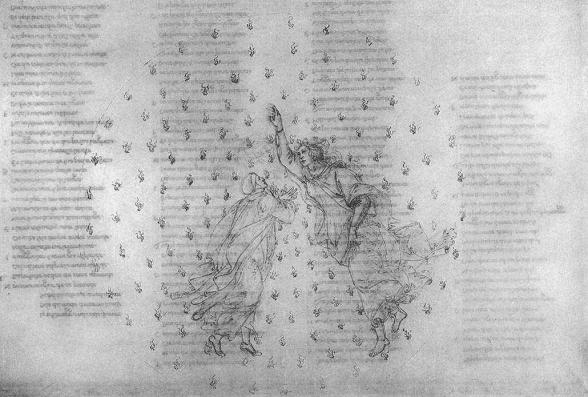
Paradise, Canto VI, Dante's Divine Comedy, picture by Sandro
Botticelli. The round form made of flames symbolize the Amanita muscaria with
all its dots. The flames symbolizes the flames of the Holy Spirit, Cannabis
sativa. Furthermore, the drawing is a symbol of the stars spinning around
the poles.
And on the upper step, God's angel - seated
upon the threshold, which appeared to me
to be of adamant
- kept his feet planted.
And from beneath that robe he drew two keys; the one
was made of gold, the other was of silver;
first with the white, then with the yellow key,
he plied the gate so as to satisfy me.
"Whenever one of these keys fails, not turning
appropriately in the lock," he said
to us, "this gate of entry does not open.
One is more precious, but the other needs
much art and skill before it will unlock -
that is the key that must undo the knot."
-Dante Alighieri, The Divine Comedy, Purgatorio, Canto IX.
One is more precious, but the other needs much art and skill before it will unlock. Before the age of oil, Cannabis sativa was
one of the most important plants used by man, thus more precious, and Amanita muscaria is very difficult to use.
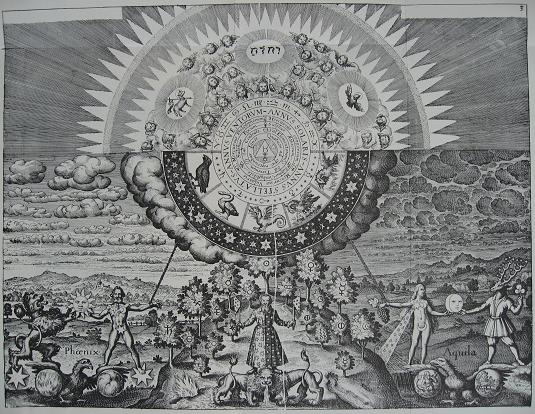
Engraving made by Matthaus
Merian for Opus Medico-Chymicum.
The picture above tells the story of the Holy Trinity
and is an illustration of the saying "As above, so below." Above, the Trinity is the Father, the Son and the Holy Spirit (the word "Spirit" commonly translates the Greek New Testament word pneuma). Below,
the Trinity is man, Amanita muscaria (solar hero), and Cannabis sativa (moon goddess). Aquila, sometimes called Sophia, is the bird in the bottom right corner that brings the young cupbearer to Zeus. Phoenix is the bird in the other corner. These are
equivalent with the two birds (Khyung and Khading) who became the bird Garouda in the myths of the Himalayas and are identified with the Aryan Soma. (Shamanism and Tantra in the Himalayas by Surendra Bahadur Shahi, Christian Ratsch and Claudia Muller-Ebeling).
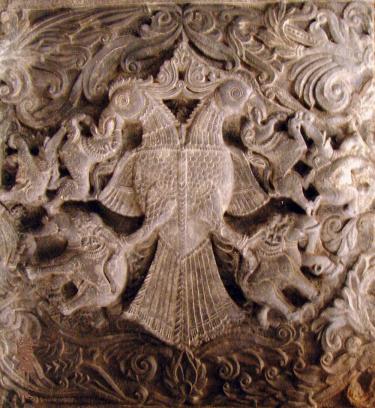
A
Gandaberunda sculpture (also known as the Berunda) is found on the
roof of the Rameshwara temple, in the temple town of Keladi, Shivamogga district, India.
The Gandaberunda is a two headed mythological
bird of Hindu mythology thought to possess magical strength. It is used as the
official emblem by the Karnataka government and it is seen as an intricately
sculptured motif in Hindu temples. The origin of the double headed bird goes far
back in time. As far back as 2000 BC to 1300 BC the double-headed
eagles are present in archaeological remains of the Hittite culture.
From the Christian myth cycle we know that the Holy Spirit is a pseudonym of the Goddess. Heracleon and Ptolemy tell us that the dove symbolizes
"Sophia, the Mother above". The dove was a widespread symbol of the goddess in the ancient world and was adopted by the Christians as symbol of Mary. Christians of the Ophite school teach that at his baptism
"Christ and Sophia, the one enfolding the other, descended upon Jesus and he became Jesus Christ."
- Timothy Freke & Peter Gandy, Jesus and the lost Goddess.
|
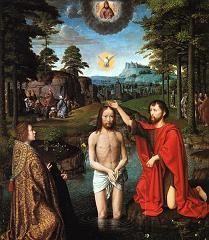
The baptism, by Gerald David.
|
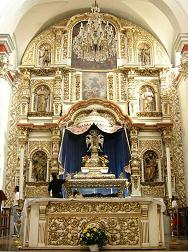
The Church of San Francisco, Puebla, Mexico. |
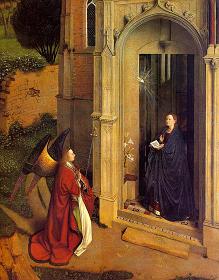
"The annunciation," by Jan van Eyck.
|
|
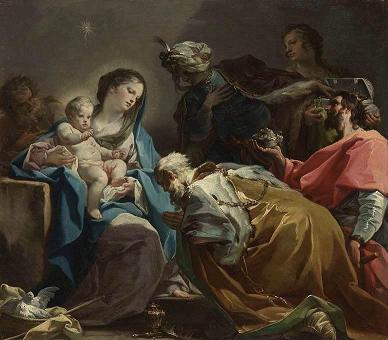
"Adoration of the Magi," by Corrado Giaquinto. |
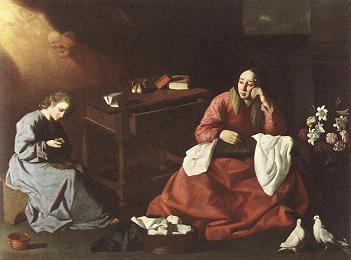
"The house of the nazareth," Francisco de Zurbaran. |
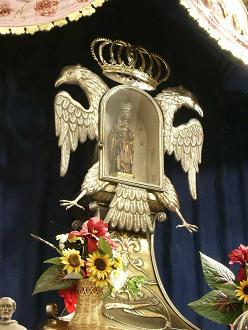
The Church of San Francisco, Puebla, Mexico.
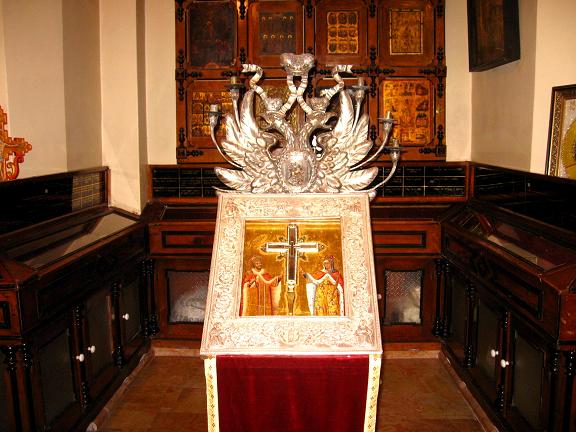
Reliquary of the True
Cross at the Church of the Holy Sepulchre, Jerusalem.
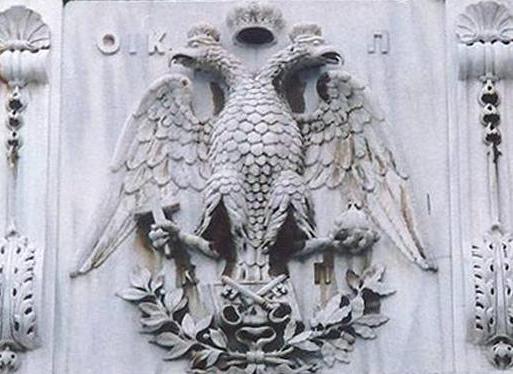
Double-headed
eagle emblem of the Ecumenical Patriarchate of Constantinople
(Istanbul), with cross and globus cruciger
in the claws.
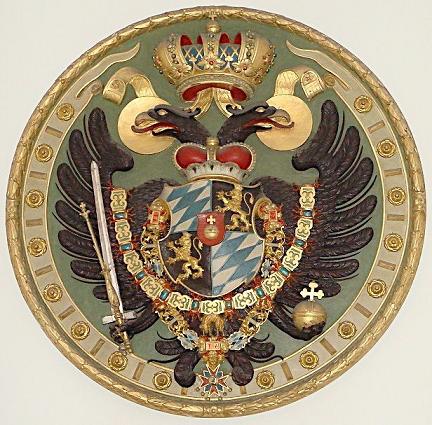
From the crypt, Theatinerkirche,
Munich.
|
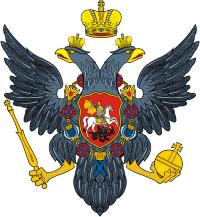
Russian imperial eagle.
|
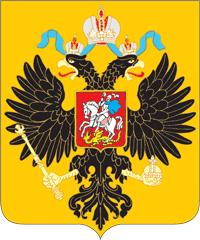
Russian imperial eagle.
|
Jesus and Mary, St. George and the dragon, and the double-headed eagle all represent the same, namely Amanita muscaria and Cannabis sativa.
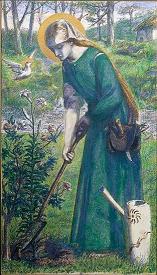
"Mary Nazarene," by Dante Gabriel Rossetti. Mary is seen planting a lily and a rose bush beside a stream.
Among the Christians, Jesus is the rose of Sharon and Mary is the lily of the valleys.
Song of Solomon 2:1.
I am the rose of Sharon, and the lily of the valleys.
-The Bible.
According to "Daturas for the Virgin," by Jose
Alfredo Gonzalez Celdran and Carl A. P. Ruck, published in Entheos, no.
2, the lily, like the unicorn, is a purifier of poisons.
In view of the fact that
the white lily was considered an antidote for poisons and mushrooms, the
concurrence of lilies and mushrooms in the same pictorial and sacred
space would not have been without special significance to the faithful
who contemplated the frescoes.
-Entheos, no. 2.
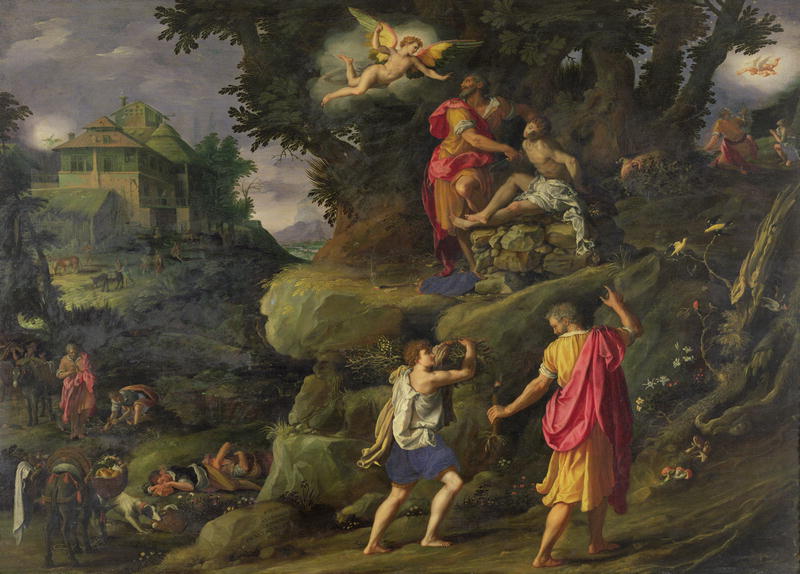
"Sacrifice
of Isaac," by Alessandro Allori.
Notice the lilies and mushrooms in
bottom right corner.
Origines identified the
Biblical "lilies of the field" with the Word, that is to say, with the
Wisdom that comes from God; he would seem to have known the occult
tradition that the lily was the fruit flower of the Tree-Bush of
Knowledge in the Garden of Eden.
-Entheos, no. 2.
|
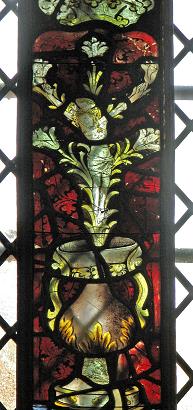
Early 15th-century glass of Christ from the Lady chapel of
St Michael's church in Oxford, England.
|
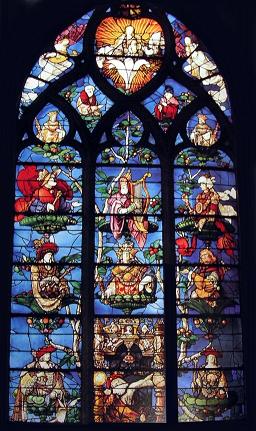
Tree of
Jesse at Saint-Etienne church in Beauvais, France, by Engrand Le
Prince, 1522-1524.
|
... for Origines the lily is
the paramount flower of the mystic.
-Entheos, no. 2.
|
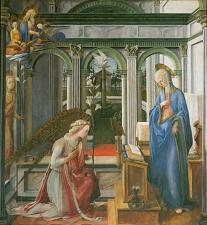
"Annunciation," by Fra Filippo Lippi.
|
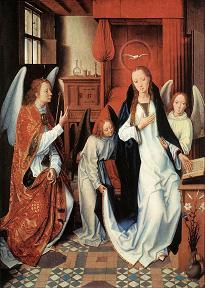
"Annunciation," by Petrus Christus.
|
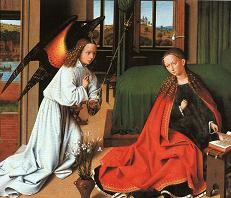
"Annunciation," by Petrus Christus.
|
In the European arts the annunciation is usually portrayed by an angel announcing the pregnancy of Mary holding a sceptre or a lily in her hand.
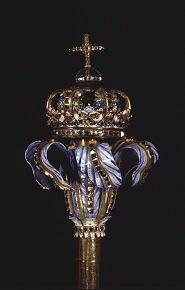
The Danish sceptre, gold with enamel and table-cut diamonds. Made for the coronation of Frederik III in 1648 by an unknown goldsmith in Copenhagen. Used at anointings during the period of Absolutism until
1840. The sceptre has a blue lily with crown and globus cruciger
on top.
On the first picture above, from the ceiling in
Queen Sophie Amalie's bedchamber on Rosenborg Castle, Copenhagen, Denmark, painted by Abraham Wuchters, Hera, Queen of the Heavens and wife of Zeus, is holding the sceptre in
her right hand. Zeus is holding the thunderbolt (Amanita muscaria) in his left
hand , while both are sitting on the same eagle. On the second picture called "The
Last Judgment" by Jacob van Campen, it is Jesus who is holding the
thunderbolt.
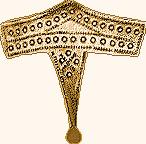
Mjoelner, the Nordic thunderbolt.
The reader must keep in mind that there are two trees in paradise
(Genesis 3:22). Adam and Eve only ate of the tree that gives knowledge of good and evil (Cannabis sativa), and not of the tree that gives eternal life (Amanita muscaria). Concerning the tree from of which they ate,
consider the following.
This is the same tree that was the original of
the Garden of Eden, for which reason Adam and Eve had its leaves ready at hand
to cover their nakedness, hence the curious custom of covering the embarrassing
nudeness of classical sculpture with an affixed fig leaf. The Hebrew folkloric
collection known as the Haggadah specifically identifies the fruit of the Tree
of Knowledge as the fig. The woman's name became Anglicized as Eve, Hava in Latin, which means
"the mother of all" (mater sanctorum biennium, Genesis 3. 4-5), from the Hebrew Havvah, or
"Life, the Living One," in Greek Zoe, which was the Canaanite epithet of Asherah, the great Mother Goddess, consort of the high god El, who was syncretized with Yahweh, until the reforms of the late seventh century abolished her cult. Her emblem were the Tree, the Cosmic Axis, and the Serpent. And her cult was orgiastic, an ecstatic shamanism, affording direct and easy access to the divine.
The visionary nature of the fig tree is preserved in the curious episode in the gospel of Luke about the tax collector Zacchaeus who wanted to see Jesus, but being too short, he climbed a sycamore fig to catch a glimpse of the deity. Thus also was Amos a tender of sycamore figs, when the Lord spoke to him, commanding him to be a prophet unto the people of Israel. The Buddha was said to have received enlightenment under a fig tree. The ambivalence of the Judo-Christian tradition to this Tree of Knowledge and its in-dwelling goddess can be sensed in the prohibition against eating its figs that make man the equal of god, with the Knowledge of good and evil, reinterpreting its fruits as the
"bad" (mahan)
"apple" (mahan), homophonous in Latin, the latter designating any fruit that, unlike a nut, is fleshy on the outside, including pomegranates and figs: the fruit is not named in Genesis, although it was recognized as the fig still in medieval times, but the force of the pun became irresistible, probably reinforced by pagan traditions of an apple-like magical fruit.
His heart was very, very saddened, and he was alone. After a long time, Hathor, the Lady of the Southern Sycamore, came, stayed with her father, the Lord of the Universe, and uncovered her nudeness before him. Then the great god burst into laughter because of her, then got up and (went to) take his seat with the Great Ennead. -Chester Beatty Papyrus c.1550 BCE.
. . .the Egyptian goddess Hathor also exposed herself obscenely to cheer her farther Ra. The gods were in Tribunal, disagreeing about the successor to the dead Osiris, either his son Horus or his brother Seth. Ra sickened and retired to his private quarters for an entire day, and his daughter displayed her vulva and restored him.
In Egyptian traditions, Hathor empowered the
pharaoh, feeding him with the elixir of her celestial milk, flowing from her
sycamore fig tree. Romulus and Remus, the founders of Rome, were suckled by a
she-wolf beneath such a tree. Demeter was similarly associated with the fig
tree; and the relationship of the mother and the empowered child passed on into
Christian traditions: in the Apocryphal Gospels, there was a sycamore called the
Pharaoh's Fig in the Egyptian town of Mathave that opened to hide within it the
Virgin Mary and the Christ as they fled from Herod's wrath. The Egyptian tree often grew on the edge of the desert, indicating a source of subterranean water, which made it a fitting marker for the entrance to the otherworld.
But in addition, although obviously not psychoactive, the fig has connotations, not only as a plant of divine empowerment, but of visionary wisdom. Figs were known for inducing both lust and knowledge; thus the fauns and pagan gods of Gaul were called ficarii or
"fig-men."
He also suspected that the wise and lascivious forest creatures of pagan Europe who went by the name of
"fig-men" existed upon a diet of mushrooms. Graves, unfortunately, was seen as a renegade. . .
The Greek word for fig (sykon, cognate with Latin ficus) was a metaphor for the vagina, preserved in the Italian fica for
"vulva."
-Carl A. P. Ruck, Sacred Mushrooms of the Goddess.
It is normally the female sex organs
from
the Cannabis plant that one wants
(the
dried flowers), when one uses Cannabis sativa in a spiritual or healing context,
though other parts of the plant is somtimes used too.
The botanical classification of Cannabis has long been uncertain.
Botanists have agreed on the family to which cannabis belongs: early
investigators put it in the Nettle family (Urticaceae); later it was
accommodated in the Fig family (Moraceae); the general trend today is to
assign it to a special family, Cannabaceae, in which only Cannabis and
Humulus, the genus of Hops, are members.
-Schultes, Hofmann & Ratsch,
Plants of the Gods.
Mark 11:12-14.
12. The next day as they were leaving Bethany, Jesus was hungry.
13. Seeing in the distance a fig tree in leaf, he went to find out if it had any fruit. When he reached it, he found nothing but leaves, because it was not the season for figs.
14. Then he said to the tree, "May no one ever eat fruit from you again." And his disciples heard him say it.
Matthew 21:19.
And when he saw a fig tree in the way, he came to it, and found nothing thereon, but leaves only, and said unto it, Let no fruit grow on thee henceforward for ever. And presently the fig tree withered away.
-The Bible.
What's being said here is that the fig tree that has no fruits (the male Cannabis sativa plant) must be taken away, when it is not the season for figs, thereby avoiding impregnating the female Cannabis sativa plant.
2 Kings 20:7
And Isaiah said, Take a lump of figs. And they took and laid it on the boil, and he recovered.
Isaiah 38:21
For Isaiah had said, Let them take a lump of figs, and lay it for a plaister upon the boil, and he shall recover.
Just as certain parts of the fig tree, in this
case the fruits, are having heeling properties in the Old Testament, so it is in
real life with parts of Cannabis sativa, usually the female flowers.
For more than six thousand years hemp
has been used as a medicine everywhere it grows in the vicinity of
humans. During my ethnomedicinal study (Marijuana Medicine) it
came to light that the medical use of hemp is even more multifaceted
than the possible uses of the entire plant. Over the course of history
different cultures and various healing systems have used hemp to treat
far more than a hundred indications. In other words, hemp is one of the
most versatile medicinal plants of all!
-C. Muller, C. Ratsch, and W.
Storl, Witchcraft Medicine.
1 Kings 4:25
And Judah and Israel dwelt safely, every man under his vine and under his fig tree, from Dan even to Beersheba, all the days of Solomon.
Micah 4:4
But they shall sit every man under his vine and under his fig tree; and none shall make them afraid: for the mouth of the LORD of hosts hath spoken it.
The wine is Jesus (Amanita muscaria) and the fig tree is Virgin Mary (Cannabis sativa).
Still in the plains of Eleusis, where the fig tree marks the spot where the Goddess Persephone had descended into Hades, . . .
-Carl A. P. Ruck & Danny Staples,The World of Classical Myth.
The cosmic tree in its upright and inverted forms is found on Indus Valley seals as well as in the Rg Veda, and some of the seal impressions indicate that the religious beliefs of the Indus Valley culture are similar to those of the soma ceremony. The cosmic tree in both traditions was the fig tree.
-David L. Spess, Soma : The Divine Hallucinogen.
The ficus religiosa is Siva's (or Rudra's) tree.
-Peter Lamborn Wilson, Ploughing the clouds. The search for Irish Soma.
In ancient Egyptian mythology, the gods sat upon a sycamore fig, Ficus sycomorus, whose fruits were held to feed the blessed. According to the Egyptian Book of the Dead, twin sycamore figs stood at the eastern gate of heaven from which the sun god, Ra, emerged each morning. This tree was also regarded as a manifestation of the goddesses Nut, Isis and especially Hathor, the
"Lady of the Sycamore". Ficus sycomorus was often planted near tombs, and being buried in a coffin made of the wood from this tree was believed to return the deceased to the womb of the mother tree goddess.
-Judith Crews, "Forest and tree symbolism in folklore."
"Guarantee that my soul sets down in
the trees which I have planted, so that I may refresh myself under my
sycamores," says the Egyptian death prayer carved into a casket lid. The
sycamore, a type of fig tree (Ficus sycamores), is the World Tree
of the Egyptians and the residence of Hathor, goddess of the heavens,
who dispenses the water of life. The Egyptian Copts still believe that
the Virgin Mary has sat in every sycamore tree.
To the eternal eye the tree in which
the dead souls seek refuge is just one of the many mighty fig trees that
grow in every location in India. But to the inner eye this tree reveals
itself as the World Tree. It is the shamanic tree, the latter to the
heavens, the cosmic spinal column that connects the highest heavens and
the depths of the underworld. It is the path on which the witch sits and
listens and sometimes laughs her "cosmic laugh."
-C. Muller, C. Ratsch, and W. Storl, Witchcraft Medicine.
The cross is made with wood from this tree, the tree with the knowledge of good and evil, from off which Adam cut a branch for a staff which he brought with him when he and Eve was thrown out of paradise.
(Interestingly, Cannabis sativa can be propagated either by seeds or by cuttings.) This staff, the staff of Moses, the staff of St. Christopher and the staff Jesus is often portrayed with, is the tree of Jesse. In fact Jesus is crucified on this very tree (picture below).
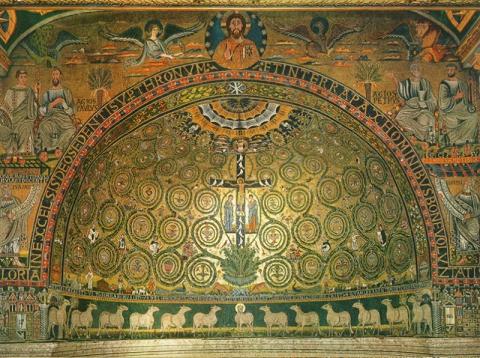
Tree of Jesse design in the Apse of San Clemente, in the valley of the Forum in Rome.
They say that when Adam and Eve were driven out of Paradise, Adam cut off a branch for a staff from the tree of good and evil; and it remained with him, and was handed down from generation to generation unto Moses and even to the Crucifixion of our Lord; and if the Lord will, we will relate its history in its proper place.
-Earnest A. Wallis Budge, M.A. (editor and translator), The Book of the Bee.
Cannabis sativa is a virgin, like Virgin Mary, when grown to maximise the
psychoactive elements in the plant. The female Cannabis sativa plant,
even experiences the immaculate conception, just like Virgin Mary. When kept
away from male plants it miraculous carries a few seeds (it turns into a
hermaphrodite). And like the pelican in the myths, Cannabis sativa feeds its
young with its own blood, when it grows seeds instead of the marijuana.
Seeds. Their presence indicates that this
isn't the most potentially resinous of plants, but rather a seeded female - which still can be very strong. There are various estimates indicating that about 40 to 50 percent of the
"vital energy" in the female will go into seed production rather than resin
production if fertilized. The weight one gets to smoke, of course, doesn't include the weight of seeds.
-Peter Stafford, Psychedelics Encyclopedia.
|
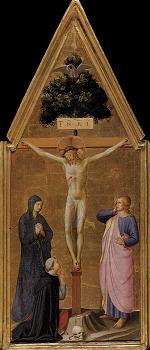
"Crucifixion," by Fra Angelico.
|
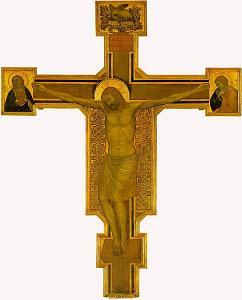
"Crucifix with the Virgin, St. John the Evangelist, and the Pelican at its Extremities," by Studio of Giotto.
|
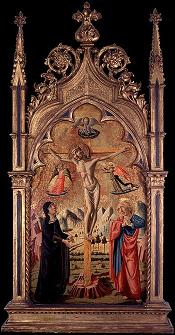
"The Crucifixion," by Niccolo da Foligno.
|
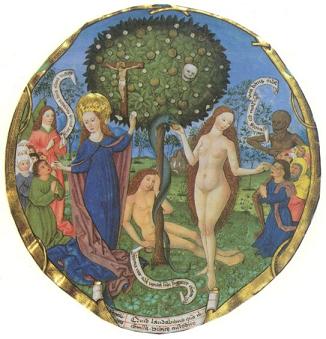
Tree of Life and Death, a medieval manuscript illumination by Berthold Furtmeyer, from Archbishop of Salzburg's missal, 1481 AD.
There are legends of the tree of knowledge of good and evil in abundance. Some of these tales tell of Jesus being crucified on wood from this very tree. Many images of Jesus show him working miracles with a wand, much like the rod of Moses. This rod is a symbolic representation, as is the sceptre, of Cannabis sativa.
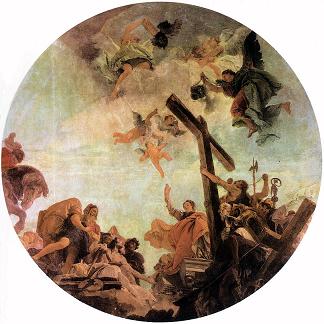
"Discovery of the True Cross," by Giovanni Battista Tiepolo. In art Virgin Mary is often associated with smoke, a lot of times coming
from an incense burner, also called a thurible.
And Saint Mary Coptic Orthodox Church in Atlanta, USA, has it that the name Mary means
"Royal Incense."
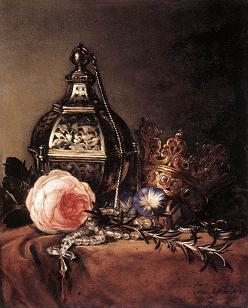
"Still-Life with Symbols of the Virgin Mary," by Dirck de Bray.
Mary is in fact, the golden thurible (Rev. 8,3) through which we must offer to God in order to please him, not only the incense of our prayers, but also of all our good works. She is also the gate to heaven;...
-Ippolito Marracci, Leonis Mariale, 1651, No 8. In Purificationem, pp. 154-157.
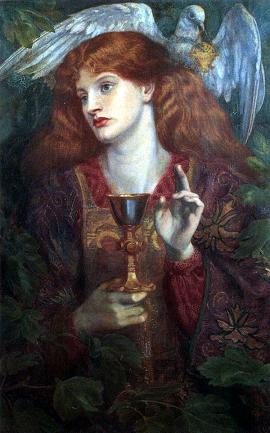
"The Damsel of the
Sanct Grael," by Dante Gabriel Rossetti.
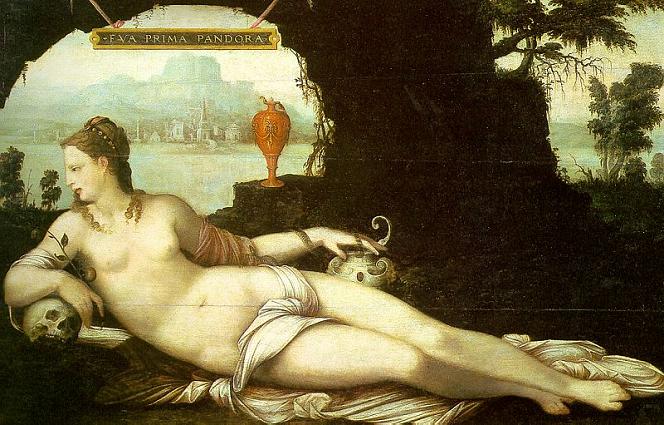
"Eva
Prima Pandora,"
by
Jean Cousin the Elder.
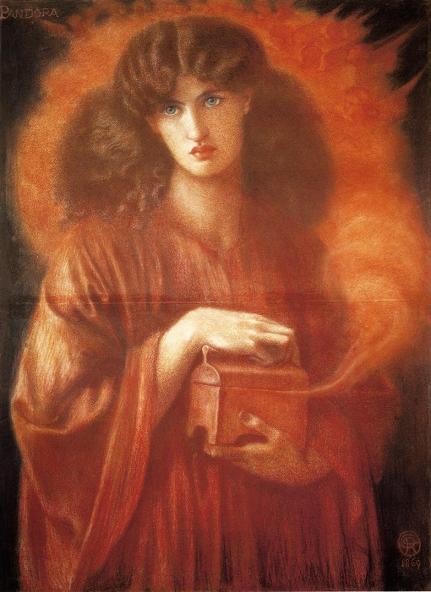
"Pandora" (1869), by Dante Gabriel Rossetti.
She is also the gate to heaven;... Thus the cross on graves. In the film
"Little Buddha" by Bernardo Bertolucci, Lama Dorje (Lama Thunderbolt) has been reincarnated into the trinity Raju (Krishna), Gita (Bhagavad-Gita) and Jesse (Tree of Jesse).
Jesse wears a green cap with an A on it (see
third picture below), and in the end of the film
Jesse performs a funeral from a ship named Mary Jane, which is slang for Cannabis sativa.
But above all, hemp (Cannabis
sativa) is the sacred herb of death ceremonies. In the Pen T'sao
of Shen Nung, the most ancient herbal with roots dating to the Chinese
Neolithic period, hemp is said to make the body light and enable the
human to speak with ghosts. The Scythians, a mounted nomadic people of
the West Asian steppes, reportedly placed their dead in a tent with
dried hemp burning on glowing stones. The inhalation of the smoke
relaxes the soul enough from the physical construct of the body, making
it possible to accompany the deceased part of the way into the regions
beyond. In India hemp is considered the herb of Harshanas, the god of
the death ceremony (shraddha). Those who are left smoke ganja at
the funeral pyre or eat it spiced with pepper as a delicacy. Those in
mourning cut their hair and sacrifice it, as is done for a birth or
other important ritual of transformation. With the help of hemp they
meditate on the dissolution of the five physical shells of the body (Pancha
Kroshi). They watch as Shiva, swinging the trident, frees the
deceased from his material chains in the wild dance of the flames. They
see the demons and the elemental beings who dance with Shiva, and they
take delight in the flow of life energy.
In Neolithic China it was the custom for participants of the festival of
the dead to wrap themselves in hemp garments. The Codex Leviticus
of the ancient Hebrews stipulates that the last clothes of the dead be
made from hemp fibres. The idea could have come from Egypt, as the
bandages of the mummies contain many hemp fibres, and in the mouths of
the mummies archaeologists have found hemplike resin mixtures (Behr,
1995: 33). Undoubtedly the hemp seeds that have been found in Germanic
graves were thought of as food of the dead. Hemp was, as were all other
fibrous plants, sacred to the goddess of fate, the
"spinner"
Freya or
Frau Holle. Hemp seed are still food for the dead among the Slavs and
the Balts of eastern Europe: A hemp soup is cooked and eaten at
Christmas or the Epiphany, when the dead visit their families.
The Germanic goddess of love, Freya, flew through the worlds with her
cat-drawn chariot. Her sacred animals were cats and rabbits; the plants
dedicated to her were hemp and flax or linen. Just as the goddess was
transformed into a "witch,"
her sacred hemp was made into a
"devil's
herb."
-C. Muller, C. Ratsch, and W. Storl, Witchcraft Medicine.
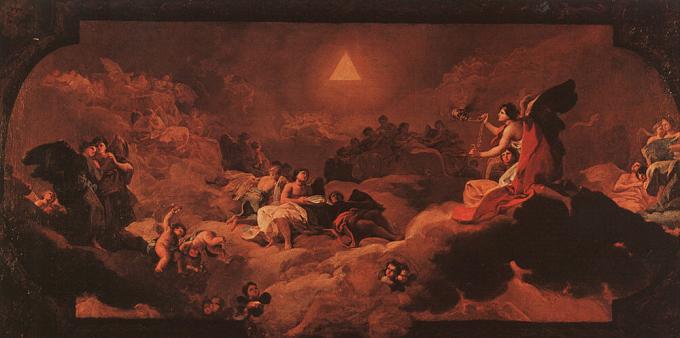
"The Adoration of the name of the Lord," by Francisco Goya. Within the Eastern Orthodox Church and Eastern Catholic Churches, incense is understood as symbolizing the sanctifying grace of the Holy Spirit.
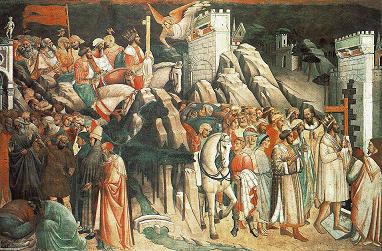
Call it Eve, Virgin Mary, the cross, or Cannabis sativa. It's all different names for the same thing. It's one of the two keys to heaven. The other is Amanita muscaria. The picture above is a detail from a picture called
"The Triumph of the Cross," by Agnolo Gaddi.
On the fare right the cross is going into a keyhole.
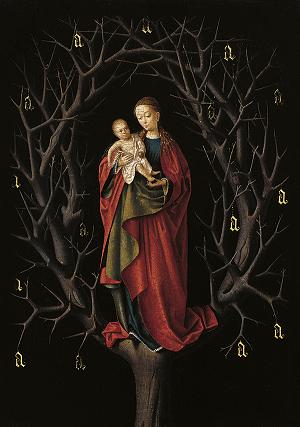
The picture above, by Petrus Christus, is called
"Our
Lady of the Dry Tree." The
golden A letter's hanging from the tree, symbolizes
Alpha, part of the Spiritual Gold,
and the beginning of the
Great Work, God being both Alpha (Cannabis sativa), and Omega (Amanita muscaria). From the Bible:
Revelation 21:6
And he said unto me, It is done. I am Alpha and Omega, the beginning and the end. I will give unto him that is athirst of the fountain of the water of life freely.
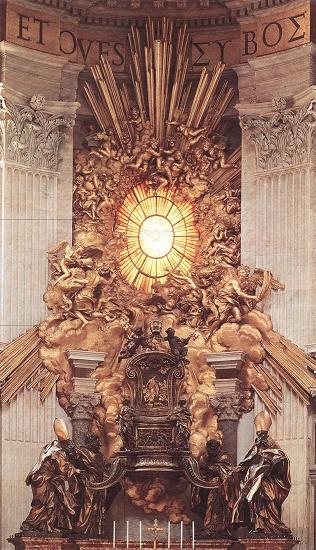
The Throne of Saint
Peter.
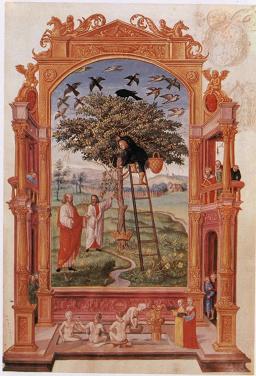
"Splendor Solis" (plate 6), by Salomon Trismosin.
On the picture above, a branch is taken from the
tree of knowledge of good and evil, and given to two men dressed in the colors
of the
Amanita muscaria mushroom, both men standing besides the River of Life. Notice the many birds.
Birds love Cannabis seeds.
When tea is made from the dried Amanita muscaria
and ingested on its own, the first results are nausea and vomiting. When
ingested together with Cannabis sativa, this sickening part of the experience
can be avoided, that is, you fight the nausea with Cannabis. This is what the
myths of St. George, also called Green George, is about. The slaying or taming
of the dragon, while a virgin and a pot of gold is liberated. Or as in the
fully developed Western version of the myth, a dragon makes its nest at the
spring that provides water for the city. St. George faces the dragon, slays it
thus freeing the waters and rescuing a princess. The slaying is in fact an act
of purification. Cannabis sativa purifying Amanita muscaria, thus the epithet
Pavamana (Self-purifying) in relation to Soma in the Rig Veda.
The Aryan prototype for all this is
in the Vedic encounter of Indra with the great serpent Ahi -
alternatively known as Vritra,
"Drought," or Namuci,
"Holdfast" - who
has confiscated the waters, which are only to be released when Indra
dismembers the Titan with his thunderbolt. The corresponding Persian
myth concerns the overthrowing of Ahriman by Mithra; there is also the
Iranian hero Thraetona who slew Dahak, a three-headed dragon. For
European counterparts, we have the Teutonic myth of Siegfried, who
overcomes a mighty dragon and despoils him of the Rheingold belonging to
the river nymphs, and which finds its Scandinavian parallel in the story
of Sigurd. The Anglo-Saxon Beowulf is likewise a dragon-slayer.
-Mateus Soares de Azevedo (editor),
Ye Shall Know the Truth.
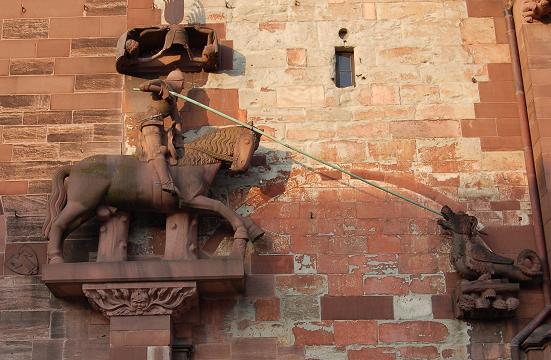
The basis of St. George is the green man.
From Basel Cathedral.
.
Two pictures from
Stockholm Cathedral. St. George's horse has the horn of a unicorn, and above the
horn, the fleur-de-lis (literally translated from
French as "flower of the lily") is also
presented in a deep disguise in the "Three Feathers" reminiscent of the
"Prince of Wales
feathers." Both the unicorn and the lily are expellers of poison.
Scholar Sula Benet made the following comments on a tale that closely resembles that of Saint George :
"In the Ukraine there is a legend of a dragon who lived in Kiev, oppressing the people and demanding tribute. The dragon was killed and the city liberated by a man wearing a hemp shirt." (Sula Benet, Early Diffusion and Folk Uses of Hemp.)
The early records of the Order of the Garter are lost. Its patron saint was St. George, who is equated in Syria, where his cult originates, with the mysterious Khidr-figure of the Sufis. It was in fact called the Order of St. George, which would translate direct into Sufi phraseology as Tarika-i-Hadrat-i-Khidr (the Order of St. Khidr). It became known as the Order of the Garter. The word "garter" in Arabic is the same as the word for the Sufi mystical tie or bond.
-Chris Bennett, Lynn Osburn and Judy Osburn, Green Gold the Tree of Life: Marijuana in Magic & Religion.
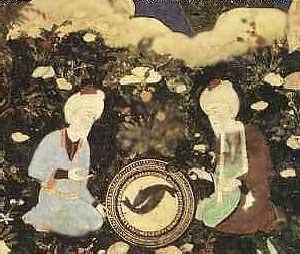
The episode of St. George and the Dragon is
Eastern in origin, brought back with the Crusaders. In Islamic cultures, the
Prophet or Saint al-Khadr or al-Khidr (according to the Quran a companion of
the prophet Moses), is associated with Mar Girgis (St. George), who is also
venerated under that name by Christians among mainly Muslim people, especially
Palestinian people, and mainly around Jerusalem, where according to tradition he
lived and often prayed near the Temple Mount, and is venerated as a protector in
times of crisis. His main monument is the elongated mosque Qubbat al-Khadr ("The
Dome of al-Khadr") which stands isolated from any close neighbours on the
northwest corner of
"The Dome of the Rock" terrace in Jerusalem.
The capacity of St.
George to cross religious boundaries is seen in an Eastern Orthodox shrine for
St. George at Beith Jala, which Moslems use in the belief it is the home of the
legendary Saint of fertility known as Khidr, Arabic for green, as well as Jews
attending the site in the belief that the prophet Elijah was buried there.
In the Islamic tradition, Khidr is the Green
Prophet and Islam's Patron Saint of Cannabis. And Khidr, together with Alexander
the Great, finds the Fountain of Life, by placing two fish in some
water. After drinking of it Khidr is the only one to attain immortality.
From the first and the last then, Corbin tells a tale of human life in which the place of language and the Word is central, and in which the quest for the lost language of God and the angels is the fundamental problem. It is the question that underlies the unity of the three branches of the Abrahamic tradition.
In his masterful treatment of the prophetic
tradition, Norman O. Brown too relies on Corbin's work for insights into the history of these interconnected and tragically divided religions. Islam is the last in the sequence of the great Revelations, and so sees itself as the end of the prophetic tradition. Following Louis Massignon, Brown takes Sura XVIII as the central book of the Quran,
and the central episode of this Sura is the meeting between Moses and Khidr.
Khidr is a mysterious figure, who acts as Moses' Guide and initiator into the secret meanings of the Law and of the world. He is the archetypal hermeneut whose speech is the lost poetry of Creation. In the Islamic tradition he is identified with the Old Testament figure of Elija. Khidr is the personal Guide, and Corbin says, equivalent to the Paraclete and the Hidden Imam, to the Christ of the Cross of Light; he is the Verus Propheta, the inner guide of each person, the celestial Anthropos and Angel of Humanity whose appearance to every person is each time unique.
Brown writes that the question posed by Islam,
at the end of the prophetic tradition, after Moses, Jesus, and Muhammad, is,
What comes after the Prophets? In Brown's words,
"The question is, Who is Khidr? And, What does it mean to be a disciple of Khidr? . . . Pursuing that question, Ibn Arabi said that he had plunged into an ocean on whose shore the Prophet remained behind standing."
This question is equivalent to asking how we may recover the Lost Speech.
-Tom Cheetham, Green Man, Earth Angel.
A number of Sufis can be tied to both hashish use and the alchemical language, most notably the Arabian Alchemist Avicenna (known in Arabic as Ibn Sina), Mansur el-Hallaj, and Farduddin Attar, the Chemist. . . .
Attar and other Sufis are reported to have used el-Khidr (Khizr), the green man, as a hidden reference to hashish and bhang. In 1894 J.M. Campbell commented that to the Moslem worshipper
"the holy spirit in bhang is not the spirit of the Almighty, it is the spirit of the great prophet Khizr, or Elijiah."
In what can be considered more than a mere coincidence, we find this same figure playing a highly regarded role in medieval alchemy. Alchemists like Paracelsus and Eirenaeus Philalethes mention the name Elias, which in the authorized version of the Bible is the same as Elijah, the powerful magician-prophet of Tishpeh, whom the Sufis equated with Khidr, the green man and patron saint of cannabis.
The real significance of the mysterious Elias is
given in an almost throw away phrase by A.E. Waite in The Brotherhood of the
Rosy Cross. He says: "I infer that enthusiasts (i.e. those who looked forward to
the coming of Elias) regarded it as a corporate Elias." In other words, Elias
was the symbolic figurehead of the new school of alchemy whose adepts were now
proving its reality among mankind.
-Kenneth Rayner Johnson, "The Fulcanelli Phenomenon."
My book is the precursor of Elias, designed to
prepare the Royal way of the Master. . .
-Eirenaeus Philalethes,
"An Open Entrance to the Closed Palace of the King."
Nothing is concealed that shall not be revealed.
There are many more secrets concerning the transmutation, though they are little
known, for if they are revealed to someone their fame is not immediately common.
With this art, the Lord bestows the wisdom to keep it secret until the advent of
Elias Artista. Then shall be revealed what has been concealed.
-Paracelsus,
"Book Concerning the Tincture of Philosophers."
-Chris Bennett, Lynn Osburn and Judy Osburn, Green Gold the Tree of Life: Marijuana in Magic & Religion.
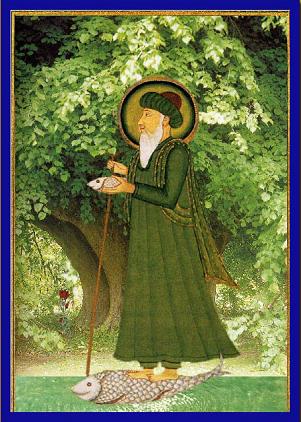
Here Khidr is seen standing on a fish crossing the river of life. More about this
very interesting character can be found in the link below.
http://khidr.org/cannabis.htm
The banner of St. George.
In Latin, canna, as in Cannabis, can mean a small
ship. On the picture below, the sailors on the ship seems to try to get our
attention. Look at the flag flown from the top of the mast on the ship. It is
the shape of the banner of St. George and together with the ship, it is a symbol
of Cannabis sativa. And, as with the myth of Khidr, two fish (Age of Pisces/Jesus) are in the water,
symbolising Amanita muscaria.
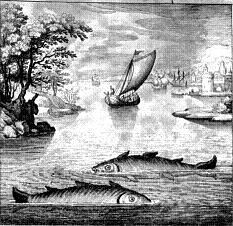
BE WARNED AND UNDERSTAND TRULY THAT TWO FISHES ARE SWIMMING IN OUR SEA.
The Sea is the Body, the two Fishes are Soul and Spirit.
The Sages will tell you
That two fishes are in our sea
Without any flesh or bones.
Let them be cooked in their own water;
Then they also will become a vast sea,
The vastness of which no man can describe.
Moreover, the Sages say
That the two fishes are only one, not two;
They are two, and nevertheless they are one,
Body, Spirit, and Soul.
Now, I tell you most truly,
Cook these three together,
That there may be a very large sea.
Cook the sulphur well with the sulphur,
And hold your tongue about it:
Conceal your knowledge to your own advantage,
And you shall be free from poverty.
Only let your discovery remain a close secret.
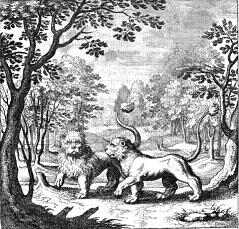
HERE YOU BEHOLD A GREAT MARVEL - TWO LIONS ARE JOINED INTO ONE.
The Spirit and Soul must be united in their Body.
The Sages do faithfully teach us
That two strong lions, to wit, male and female,
Lurk in a dark and rugged valley.
These the Master must catch,
Though they are swift and fierce,
And of terrible and savage aspect.
He who, by wisdom and cunning,
Can snare and bind them,
And lead them into the same forest,
Of him it may be said with justice and truth
That he has merited the meed of praise before all others,
And that his wisdom transcends that of the worldly wise.
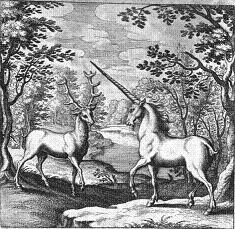
HEAR WITHOUT TERROR THAT IN THE FOREST ARE HIDDEN A DEER AND AN UNICORN.
In the Body there is Soul and Spirit.
The Sages say truly
That two animals are in this forest:
One glorious, beautiful, and swift,
A great and strong deer;
The other an unicorn.
They are concealed in the forest,
But happy shall that man be called
Who shall snare and capture them.
The Masters shew you here clearly
That in all places
These two animals wander about in forests
(But know that the forest is but one).
If we apply the parable to our Art,
We shall call the forest the Body.
That will be rightly and truly said.
The unicorn will be the Spirit at all times.
The deer desires no other name
But that of the Soul; which name no man shall take away from it.
He that knows how to tame and master them by Art,
To couple them together,
And to lead them in and out of the forest,
May justly be called a Master.
For we rightly judge
That he has attained the golden flesh,
And may triumph everywhere;
Nay, he may bear rule over great Augustus.
-The Book of Lambspring ,
A Noble Ancient Philosopher, Concerning the Philosophical Stone.
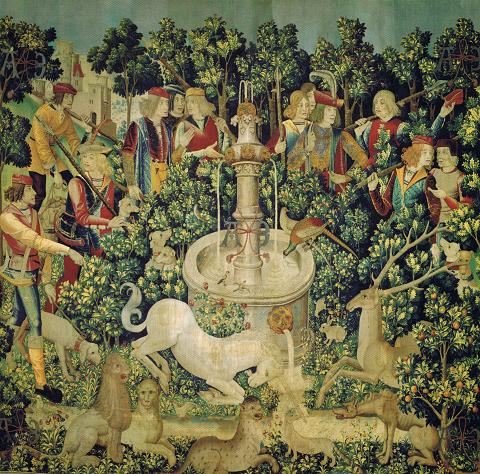
"Hunt of the Unicorn, the Unicorn at the Fountain,"
anonymous artist, ca.1500, tapestry, French, New York City,
Metropolitan Museum.
The unicorn is a mythical animal that has changed in appearance over the many years of it first being recorded. In the Middle Ages it was thought of as being a strong and fierce animal associated with chastity and virginity and also with Christ's love of mankind (and
it could only be captured by a virgin). When a unicorn dips its horn in water it purifies the water from what ever poison might be in it.
Great virtues are attributed to it, in expelling of poison and curing of several diseases.................. J. P. Lundy believes that the horn of the unicorn symbolizes the horn of salvation mentioned by St. Luke which, pricking the hearts of men, turns them to a consideration of salvation through Christ. Medieval Christian mystics employed the unicorn as an emblem of Christ, and this creature must therefore signify the spiritual life in man.
-Manly P. Hall, The Secret Teachings of All Ages.
The Arian sacrament consists of two elements, as does the philosopher's stone within alchemy. It is the union within the human body, of these two opposites, that is the goal of the spiritual seeker.
To get the elixirs of the white and red roses,
what is required above all is the right source material. The rose wears a green
dress, says Maier. The wise man plucks it without being pricked, while thieves
"have nothing but pain from it."
"Make of man and woman a circle; when you add the head to the tail, you have the
whole tincture." (Hermetic saying)
-Alexander Roob, Alchemy and Mysticism.
The wise man plucks it without being pricked,
while thieves "have nothing but pain from it." When you ingest Amanita muscaria without being initiated into the proper use of the mushroom, you will become very sick.
Make of man and woman a circle; when you add the head to the tail, you have the
whole tincture. In Latin the word penis originally meant tail,
so this is an other way of saying, that after ingesting Amanita muscaria and Cannabis sativa, then drink your urine. Thus the Ouroboros.
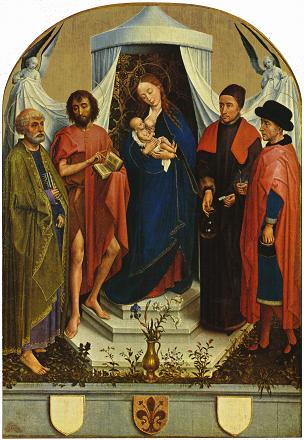
"Medici Madonna," by Rogier van der Weyden.
Saints Cosmas and Damian, the Dioscuri (more
about the Dioscuri later), are standing to the left of
Mary and Jesus, and Peter and John are standing to the right, as if
all participating in a sacred conversation. Interestingly, Medical History, July 1968, brought an article entitled "SS.
Cosmas and Damian - Patron Saints of Medicine and Pharmacy Their Cult in
England," by Leslie G. Matthews. In it, he names two instances of sacred
art that depicts one of the twins holding a urine flask.
From about the seventh century,
Cosmas and Damian have been the tutelary saints associated with
medicine. St. Cosmas is usually represented as the physician
holding a urine flask, while his brother martyr is variously depicted,
either carrying a portable medicine chest, an ointment jar or spatula,
so may be rightly appropriated to the apothecary.
-C. J. S. Thompson, Mystery and
Art of the Apothecary.
We may here recall a statement which
was made on a previous page to the effect that one of the titles by
which the Dioscuri (and the saints who displaced them) were known was
that of "boni medici," or good physicians.
-J. Rendel Harris, The Cult of the Heavenly Twins.
John 7:37-38.
In the last day, that great day of the feast, Jesus stood and cried, saying, If any man thirst, let him come unto me, and drink. He that believeth on me, as the scripture hath said, out of his belly shall flow rivers of living water.
-The Bible.
Attitudes of the time towards Cannabis are well reflected in that great favourite of Eastern and
Western literary tradition, the Arabian epic A Thousand and One
Nights. In a story told by Scheherazade on the 798th night, a Sultan in disguise has the misfortune of being deliberately
urinated upon in the house of a cadi, or a lowly magistrate, by
another guest, a fisherman. The fisherman believed himself to be Sultan,
for he had swallowed enough hashish "to destroy a hundred year old
elephant." In the morning cadi and fisherman were called to the palace,
where the Sultan revealed himself as the hapless guest of the night
before. The cadi fell to his knees to beg for mercy, while the
fisherman, to the Sultan's delight, replied, "What of it? You are in
your palace this morning, we were in our palace last night." To the
Sultan this truth was the "sweetest noise in all our kingdom," and he
said to the fisherman, "We are both Sultans of this city." The
implication, of course, is that the consumption of hashish was at least
accepted, if not encouraged. This is supported also by the fact that at
the beginning of the tale Scheherazade says, "Allah had willed that the cadi should also be given to the use of hashish." If hashish consumption
had been beneath contempt, as al-Hasan's detractors claimed, tales of
this period would hardly implicate Allah himself in the practice.
-William A. Emboden, Jr.
-Peter T. Furst (editor), Flesh of the Gods.
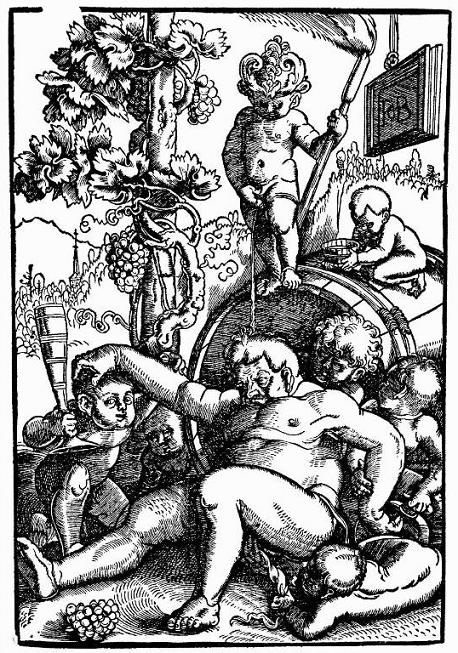
"Der trunkene Bacchus mit
spielenden Putten," by Hans Baldung Grien.
The Golden Flower is the light. What
colour is the light? One uses the Golden Flower as a symbol. It is the
true energy of the transcendent great One. The phrase "The lead of the
water-region has but one taste" refers to it.
The work on the circulation of the
light depends entirely on the backward-flowing movement, so that the
thoughts are gathered together. The heavenly heart lies between sun and
moon.
-Richard Wilhelm (translator),
The Secret of the Golden Flower.
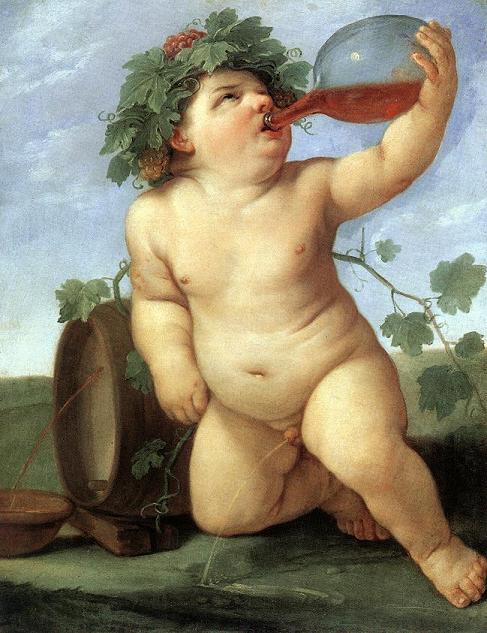
"Drinking Bacchus,"
by Guido Reni.
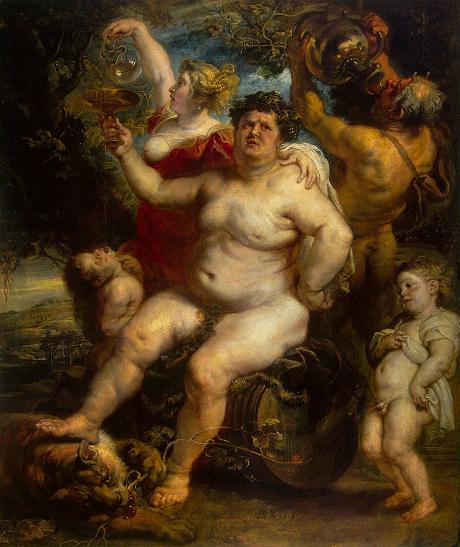
"Bacchus," by
Peter Paul Rubens.
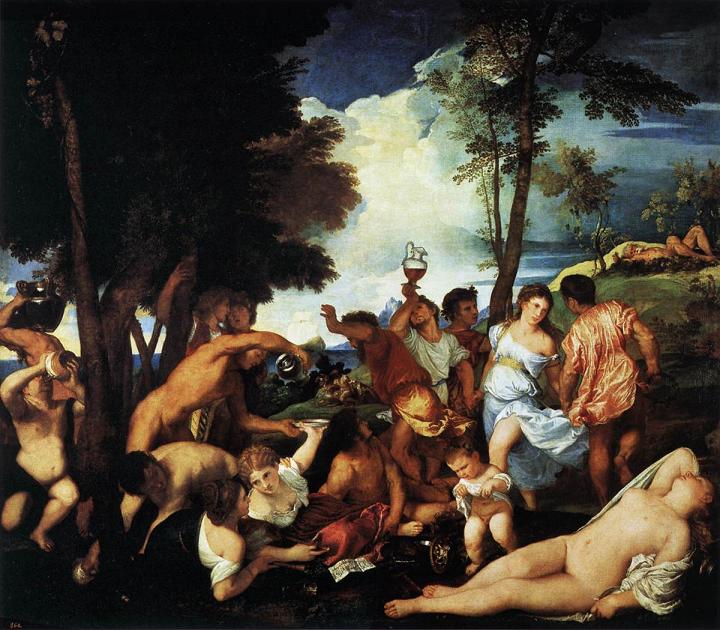
"Bacchanal of the Andrians," by Vecellio Tiziano.
The alchemical motif of the pissing boy appears in Titian's
Bacchanal of the Andrians..... In the foreground a young Dionysian
figure lifts his gown and urinates into the stream of "wine" that is
flowing by. A man downstream, fully aware of what is happening, fills
his jug with the mixture. Everyone is in varying states of ecstasy or
torpor. A note in the foreground reads "He who drinks and does not drink
again, does not know what drinking is."
-Clark Heinricksen, Magic Mushrooms in Religion and Alchemy.
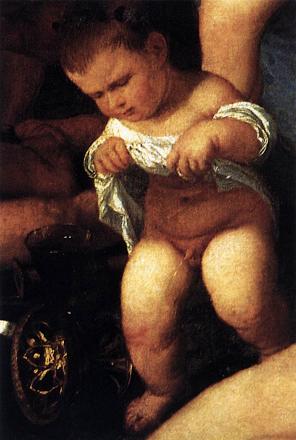
"Bacchanal of the
Andrians," (detail), by Vecellio Tiziano.
Dionysus or Bacchus is thought of as
being Greek, but he is a remake of the Egyptian god Osiris, whose cult
extended throughout a large part of the ancient world for thousands of
years. Dionysus's religion was well-developed in Thrace, northeast of
Greece, and Phrygia, which became Galatia, where Attis also later
reigned. Although a Dionysus is best remembered for the rowdy
celebrations in his name, which was Latinized as Bacchus, he had many
other functions and contributed several aspects to the Jesus character:
--Dionysus was born of a virgin on December 25 and, as the Holy Child,
was placed in a manger.
--He was a traveling teacher who performed miracles.
--He "rode
in a triumphal procession on an ass."
--He was a sacred king killed and eaten in an eucharistic ritual for
fecundity and purification.
--Dionysus rose from the dead on March 25.
--He was the God of the Vine, and turned water into wine.
--He was called "King of Kings" and
"God
of Gods."
--He was considered the "Only
Begotten Son," Savior,"
"Redeemer,"
"Sin
Bearer,"
"Anointed One," and the
"Alpha
and Omega."
--He was identified with the Ram or Lamb.
--His sacrificial title of "Dendrites" or
"Young Man of the Tree"
intimates he was hung on a tree or crucified.
As Walker says, Dionysus was
"a prototype of Christ with a cult center
at Jerusalem," where during the 1st century BCE he was worshiped by Jews
. . . Dionysus/Bacchus's symbol was
"IHS"
or "IES," which became
"Iesus"
or "Jesus." The
"IHS" is used to this day in Catholic liturgy and
iconography.
- Acharya S, The Christ Conspiracy.
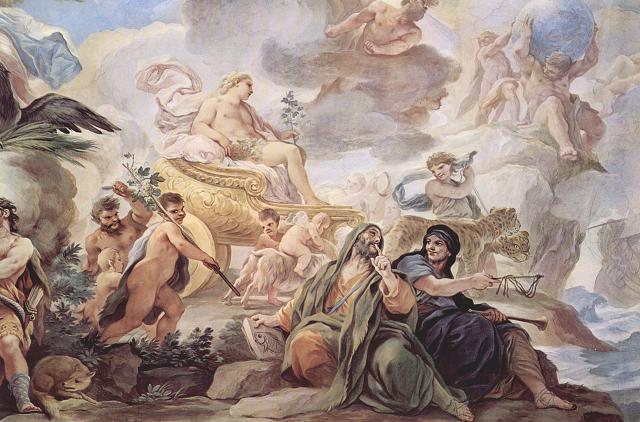
"Baccus mit seinem Gefolge der Faunen und Satyren,"
by Luca Giordano. Notice the fish and remember that
according to Acharya S, Dionysus or Bacchus is
thought of as being Greek, but he is a remake of the Egyptian god
Osiris. Concerning Osiris she writes. He was
"the Fisher"
and was associated with the Fish ("Ichthys"), Lamb and Lion. The Christ
conspiracy by Acharya S.
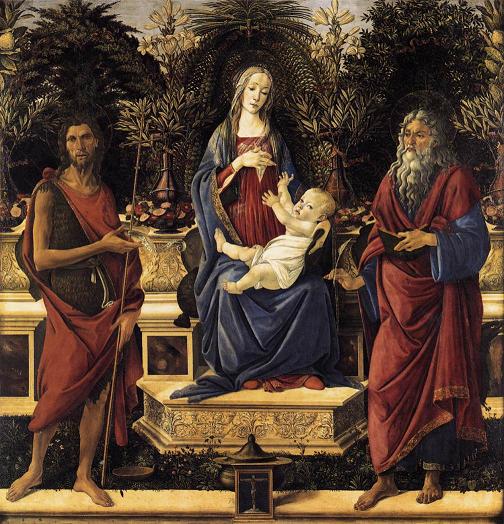
"The Virgin and Child Enthroned" (Bardi
Altarpiece), by Botticelli
Sandro. Notice the chamber pot behind the small picture of the
crucified Jesus.
Book 10, hymn 28.
4. Resolve for me, O
singer, this my riddle: The rivers send their swelling water backward:
The fox steals up to the approaching lion: the jackal drives the
wild-boar from the brushwood.
-Ralph T. H. Griffith (translator), Rig-Veda.
"When the Gods Drank Urine"
by Mike Crowley
http://www.erowid.org/plants/amanitas/amanitas_writings1.shtml
When Buddha was born he jumped around on one leg. This is what his footprint looked like.
Buddhist art indicating the sacramental use of Amanita muscaria. The four pictures above
and the one below are from Ajanta Caves, India.
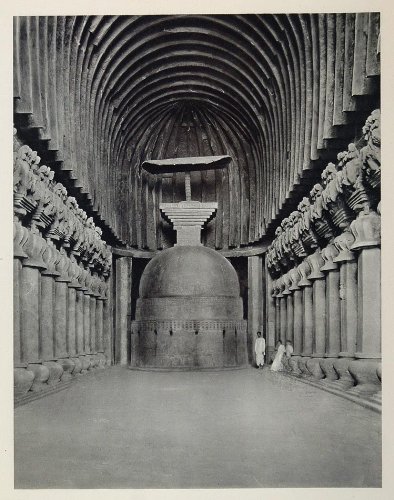
|
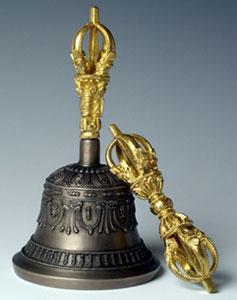 |
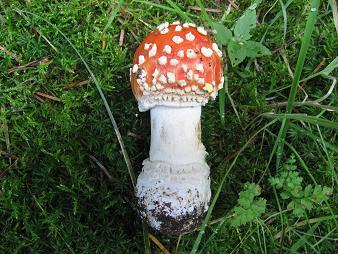
Dorje,
bell, and the Thunderbolt of Enlightenment. |
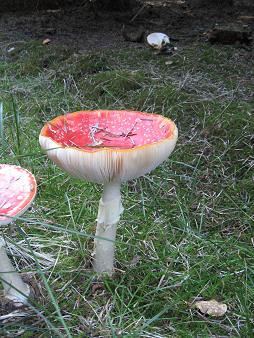 |
There's a famous saying in Buddhism.
"If you ever meet the Buddha on the path, kill him." Also,
there is a legend to the effect, that when the Buddha was sitting under the
Bodhi tree (ficus religiosa), he was so deep in meditation that he was unaware
that it was extremely hot. A group of snails saw him and realising the
importance of his thoughts, crawled up to cover and protect his head with their
bodies. The snails died from exposure to the hot sun and became honoured as
martyrs who had died to protect the Buddha. In some images of the Buddha, his
hair curls do indeed resemble snails to remind people of this story. If Buddha
in the above story is the Amanita muscaria, then the myth makes perfect sense,
since snails are known to sit on the cap of the mushroom, eating from it, as opposed to sitting on a human head.
Amanita muscaria, with the flame of the holy spirit, Cannabis sativa, on top.
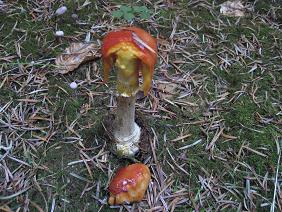
The elongated ears of
the Buddha comes from the fact that when the Amanita muscaria is in the end
of its life circle, it often literally melts away.
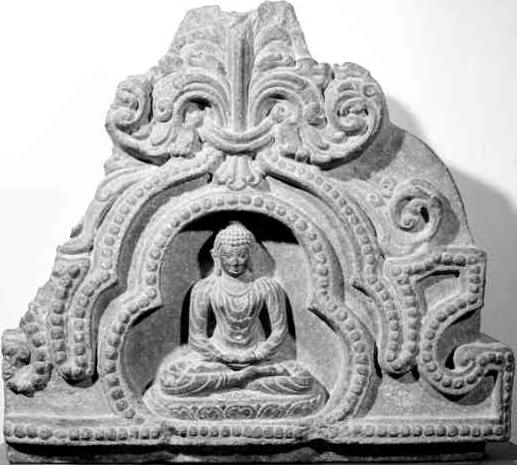
Buddha
meditating inside the
young
Amanita muscaria with what appears to be
the fleur-de-lis on top. Nalanda Site Museum, Bihar, India.
The Tibetans considered Cannabis sacred. A Mahayana Buddhist tradition maintains that during the six steps of asceticism leading to his enlightenment, Buddha lived on one Hemp seed a day. He is often depicted with "Soma leaves" in his begging bowl and the mysterious god-narcotic Soma has occasionally been identified with Hemp.
-Schultes, Hofmann & Ratsch, Plants of the Gods.
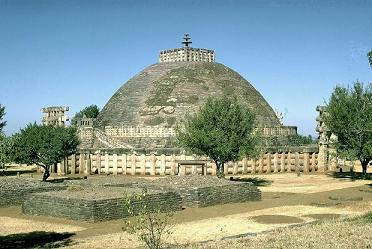
The Great Stupa at
Sanchi, India, established by Ashoka the great (4th–1st century BC).
The Tibetan
word for stupa is Chorten, which means "the basis of offering." It is a symbol
of the enlightened mind, (the awakened mind, universal divinity) and the path to
its realisation. The stupa represents the Buddha's body, his speech and his mind, but most especially his mind and every part shows the path to Enlightenment. Every stupa contains at the very least a life tree and a holy relic.
Chermanangad
is a small village in the Thrissur district of Kerala in India with a
prehistoric burial site, commonly known as Kodakuthy Kallu. The kuda kallu
(umbrella stones) as they are called are almost two meters high and two
meters wide. Four stone slabs forming a square base support a large
stone, convex in shape. They are memorial stones for the dead, probably
rulers, erected in the place where they were cremated. On this location
are also found hat-stones under which burial urns were placed. These umbrella stones and hat-stones of Chiramanangad are
reported to have a history of over four thousand years.
"Kuda-kallu:
umbrella-stones or mushroom-stones?"
by Giorgio Samorini
http://www.samorini.it/doc1/sam/kuda.htm
In some Buddhist countries the
parasol is an object of worship and in India it has acquired a religious
association. Furthermore the umbrella was a symbol of authority among the Egyptians
and Orientals. In Egyptian mythology, specifically in the Heliopolitan
tradition, the Benben or Ben-ben was the mound that arose from the primordial
waters and on which the creator god Atum settled. In the Pyramid Texts, Atum
himself is at times referred to as "mound". The Benben stone, named after the
mound, was a sacred stone in the solar temple of Heliopolis. It was the location
on which the first rays of the sun fell. It is thought to have been the
prototype for later obelisks, and the capstones of the great pyramids were based
on its design. The phoenix (the bennu bird), was venerated at Heliopolis, where
it was said to be living on the Benben.
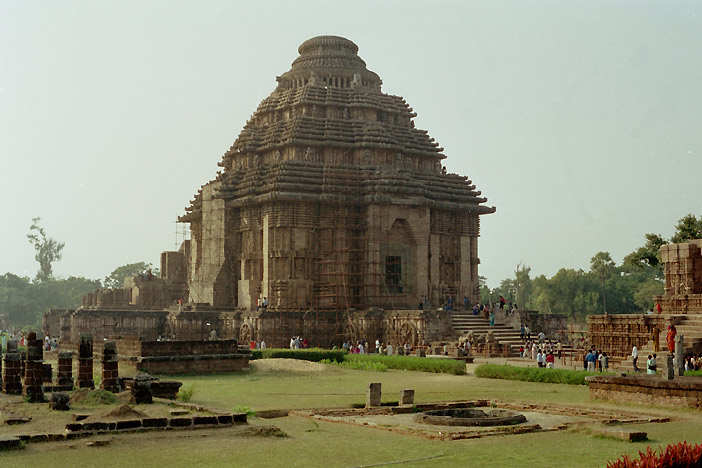
Konark Sun Temple,
India.
The first three pictures below are
examples of Christian iconography. The last of the three is of a monstrance. A
monstrance is the vessel used in the Roman Catholic, Old Catholic, and Anglican
Churches to display the consecrated Eucharistic Host, which is literally
believed to be the body of Christ.
The Amanita muscaria looks like this (pictures above) when it has been lying down for a while. When you harvest the mushrooms and carry them in your basket, upon retuning home, some of the mushrooms will have turned their caps 90 degrees, to enable the release of spoors.
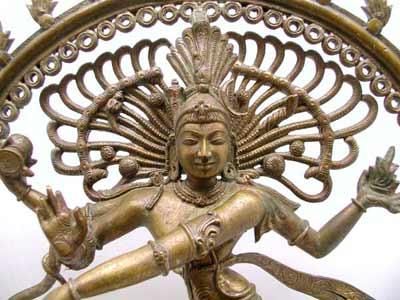
In the ancient Indian religious Sanskrit text
called the Shivambu Kalpa Vidhi, from the Damar Tantra, it talks
about the benefits of pure water, or one's own urine. Urine therapy is referred
to as Shivambu Kalpa, Shivambu literally meaning "Water of Shiva."
In Shivambu Kalpa Vidhi, verse 9, it is even stated that "Shivambu is
a divine nectar!"
In the Indian Ayurvedic tradition, urine therapy is called Shivambu Shastra,
respected for thousands of years as the "Mother of Ayurvedic Medicine" (Shivambu
Shastra: Mother of Ayurvedic Medicine - by Natalia Perera).
In ancient yoga practices, amaroli (amara in Sanskrit means immortal)
refers to the drinking of one's own urine.
It is the moon that is carrying the soma.
Tradition in India maintains that the gods sent man the Hemp plant so that he might attain delight, courage, and have heightened sexual desires. When nectar or Amrita dropped down from heaven, Cannabis sprouted from it. Another story tells how, when the gods, helped by demons, churned the milk ocean to obtain Amrita, one of the resulting nectars was Cannabis. It was consecrated to Shiva and was Indra's favourite drink. After the churning of the ocean, demons attempted to gain control of Amrita, but the gods were able to prevent this seizure, giving Cannabis the name Vijaya ("victory") to commemorate their success. Ever since, this plant of the gods has been held in India to bestow supernatural powers on its users.
- Schultes, Hofmann & Ratsch, Plants of the Gods.
The Mahashivratri is Shiva's Great Night. On this day Lord Shiva was married to Parvati (who had given Shiva the Cannabis plant so that he would not run of with other women). On this day Shiva drank the poison and held it in his throat (turning blue) by binding it with a snake. On this day, after the churning of the ocean,
demons attempted to gain control of Amrita, but the gods were able to prevent this seizure, giving Cannabis the name Vijaya ("victory") to commemorate their success.
And among his myriad epithets, Shiva is known as "Lord of Bhang."
"So holy a plant must play a leading part in temple rites. Shiva on fire with the poison churned from the ocean was cooled by bhang." Note on the religion of Hemp. James M. Campbell. C.I.E., Collector of Land Revenue and Customs and Opium, Bombay.
-Report of the Indian Hemp Drugs Commission, 1893-1894, Bombay.
Rudra in the sky is Sirius, star of
stars, most exalted among them.
Sirius the dog star is twice and even
thrice the star shape of Rudra.
Sirius, the hound of heaven, the star
form of Rudra, the Wild God, is mythically the most eminent of all
stars.
This mighty star is the sidereal
equivalent of the Rg Veda word of power, the raudra brahman. It
is the star symbol of the Wild Hunter and the guardian of order, the
dog.
-Stella Kramrisch, The Presence of Siva.
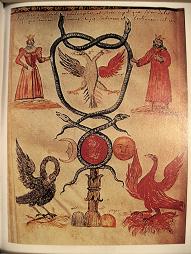
All four pictures above can be found in
Alchemy & Mysticism, by Alexander Roob. Notice the pelican and phoenix on the last picture.

"Marienaltarchen,"
by Koelner Meister, Rheinisches Landes-Museum, Bonn. Notice
the pelican and phoenix.
This Egyptian deity under many names appears as the principle of natural fecundity among nearly all the religions of the ancient world. She was known as the goddess with ten thousand appellations and was metamorphosed by Christianity into the Virgin Mary, for Isis, although she gave birth to all living things--chief among them the Sun--still remained a virgin, according to the legendary accounts.
Plutarch translates the name Isis to mean wisdom.
Plutarch further asserts that the Greeks recognized in Osiris the same person whom they revered under the names of Dionysus and Bacchus.
The ancients gave the name Isis to one of their occult medicines; therefore the description here given relates somewhat to chemistry. Her black drape also signifies that the moon, or the lunar humidity - the sophic universal mercury and the operating substance of Nature in alchemical terminology - has no light of its own, but receives its light, its fire, and its vitalizing force from the sun. Isis was the image or representative of the Great Works of the wise men: the Philosopher's Stone, the Elixir of Life, and the Universal Medicine.
And in the middle of the crown, just on her forehead, there was a smooth orb resembling a mirror, or rather a white refulgent light, which indicated that she was the moon.
The Druids of Britain and Gaul had a deep knowledge concerning the mysteries of Isis and worshiped her under the symbol of the moon.
The moon was chosen for Isis because of its dominion over water. The Druids considered the sun to be the father and the moon the mother of all things. By means of these symbols they worshiped Universal Nature.
The Druids had a Madonna, or Virgin Mother, with a Child in her arms, who was sacred to their Mysteries; and their Sun God was resurrected at the time of the year corresponding to that at which modern Christians celebrate Easter.
Plutarch describes the requisites of a follower of Isis in this manner: "For as 'tis not the length of the beard, or the coarseness of the habit which makes a philosopher, so neither will those frequent shavings, or the mere wearing [of] a linen vestment constitute a votary of Isis; but he alone is a true servant or follower of this Goddess, who after he has heard, and been made acquainted in a proper manner with the history of the actions of these Gods, searches into the hidden truths which is concealed under them, and examines the whole by the dictates of reason and philosophy."
During the Middle Ages the troubadours of Central Europe preserved in song the legends of this Egyptian goddess. They composed sonnets to the most beautiful woman in all the world. Though few ever discovered her identity, she was Sophia, the Virgin of Wisdom, whom all the philosophers of the world have wooed. Isis represents the mystery of motherhood, which the ancients recognized as the most apparent proof of Nature's omniscient wisdom and God's overshadowing power. To the modern seeker she is the epitome of the Great Unknown, and only those who unveil her will be able to solve the mysteries of life, death, generation, and regeneration.
-Manly P. Hall, The Secret Teachings of All Ages.
In light of the Goddesses early connection with the Tree of life, it is not at all surprising to find that the Goddess can also be connected with the star of the holy hemp plant:
There are many legends which tell how the Goddess was born of a star. Sirius (Sept.) was regarded as the sacred star of Isis (Aug-Sep), it is called the "grandmother" by the Bush (wo)men and it is of great and sacred importance to the Dogon people of Mali.
-Monica Sjoo, "New Age And Armageddon."
The Dogon people recognize Sirius as the planet from which their holy cannabis came from. (See chapter 6, Egypt.) A number of scholars have pointed to an earlier Egyptian influence on the Dogon cosmology; and the Queen of Heaven, Isis, connected with this star.(3)
Notes:
3. "Ancient Egypt may have contributed its share of the gorgeous symbolism of the Catholic Church as well as to the pale abstractions of her theology. Certainly in art the figure of Isis suckling the infant Horus is so like that of the Madonna and child that it has sometimes received the adorations of ignorant Christians. And to Isis in her later character, as patroness of mariners the Virgin Mary perhaps owes her beautiful epithet of Stella Maris, "Star of the Sea," under which she is adored by tempest-tossed sailors. The attributes of a marine deity may have been bestowed on Isis by the sea-faring Greeks of Alexandria. They are quite foreign to her original character and to the habit of the Egyptians, who had no love of the sea. On this hypothesis Sirius, the bright star of Isis, which on July mornings rises from the glassy waves of the eastern Mediterranean, a harbinger of halcyon weather to mariners, was the true Stella Maris, "the Star of the Sea."" (J. G. Frazer, "The Golden Bought," 1922.)
-Chris Bennett, Lynn Osburn and Judy Osburn, Green Gold the Tree of Life: Marijuana in Magic & Religion.
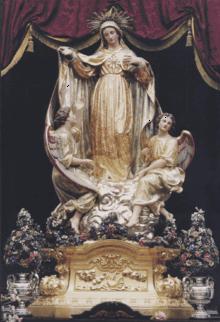
"Our Lady, Star of the
Sea," venerated in the church of Sliema, Malta.
The ancient Egyptians believed that humans held the potential for becoming godlike. They maintained that a sacred plant was a major part of that transhumanization. It is written in the Harris Papyrus 501, dated 311 BCE:
...and a like measure of the divine scrubs to prompt the speech of the star gods.
-Translated by E.A. Wallis Budge, (1910).
The Ancient Egyptian prototype - nothing less than the quest and prescription
for the release of humanity's nascent divinity, in turn enabling the rejoining of a world and an already functional community of highly advanced beings who welcome the newcomers to joyous puissance.
The principle agent of this transformation was "the divine food" which, like what some super royal jelly could do for bees, would stimulate metamorphic neurosecretory organs in the human central nervous system and enable a super biological process to take place to mature a higher body that can transcend at death and is capable of furnishing a sensorium to perceive and function in a world freer than the transient three-dimensional one in which we are currently confined. This was the ageless promise that Ancient Egypt held forth most explicitly. And this is the essence of any religion worthy of the name that is to be more than a mere excuse for the seizure of power and control.
-Charles Muses, "The Sacred Plant Of Ancient Egypt." (12)
Another papyrus, No. 10,477, sheet 30, in the "Egyptian Book Of The Dead", states the speech of the star gods, was prompted by the Divine Shrub, adding:
I am Yesterday and Tomorrow, and have the power to regenerate myself... The hitherto closed door is thrust open and the radiance in my heart hath made it enduring. I can walk in my new immortal body and go to the domain of the starry gods. Now I can speak in accents to which they listen, and my language is that of the star Sirius.
-Charles Muses, "The Sacred Plant Of Ancient Egypt." (13)
What is so interesting about the above statement is that the Egyptian influenced Dogon tribe (14) claims cannabis came from Sirius.
Their "Dagga" cults believed Holy cannabis was brought to earth by the Gods, in particular from the "two Dog Star" system that we call A and B. "Dagga" literally means "cannabis". Interestingly, the surviving Indo-European word for the plant can be read as "canna," "reed," and "bi," "two," as well as "canna" as in canine; and "bis", meaning two (bi)-"Two Dogs."
-Jack Herer, "The Emperor Wears No Clothes."
These linkages more than hint at an ancient astronomical awareness of the "dark companion" star of Sirius discovered in modern times by Alan G. Clark in Mass., on January 31, 1862, following the calculations of his colleague, Truman Safford. It was later (1960) established by van den Bos, working in South Africa, that the very dense "dark companion of Sirius circles her once in exactly fifty (50,09) years, their next approach or periastron occurring in April, 1994.
-Charles Muses, "The Sacred Plant Of Ancient Egypt." (15)
Notes:
12. "Gateways To Inner Space", Christian Ratch, ed. (The theme of cannabis as an evolutionary agent appeared again and again while collecting research for this book, as will be shown.-CB)
13. Ibid.
14. Ibid. Astronomical information was preserved by the Egyptian-influenced Dogon tribe, as the works of ethnologists Germaine Dieterlen and Marcel Griaule has shown.
15. Ibid. Muses credited much of the research he used to "The Lion Path,"
Musaios, 1985. However, Muses mistakenly chose Khat, which is compared to coffee
in its effects, for his identity of the Egyptian's sacred shrub.
-Chris Bennett, Lynn Osburn and Judy Osburn, Green Gold the Tree of Life: Marijuana in Magic & Religion.
In "Flesh Of The Gods" Peter T. Furst mention that some of the earliest Sanskrit names for Cannabis sativa is cana and sana.
According to the University of Notre Dame Dog in Latin is canicula, Rabbit
in Latin is cuniculus and Sirius in Latin is canicula.
The dog features as a guardian of the underworld
in Egyptian, Hindu and Greek mythology, and the dog is "man's best friend," and
the creature humans have had the longest standing symbiotic relationship with.
Among the plants this is true for Cannabis.
Thoth Hermes Trismegistus, the founder of Egyptian learning, the Wise Man of the ancient world, gave to the priests and philosophers of antiquity the secrets which have been preserved to this day in myth and legend. These allegories and emblematic figures conceal the secret formula for spiritual, mental, moral, and physical regeneration commonly known as the Mystic Chemistry of the Soul (alchemy). These sublime truths were communicated to the initiates of the Mystery Schools, but were concealed from the profane. The latter, unable to understand the abstract philosophical tenets, worshiped the concrete sculptured idols which were emblematic of these secret truths. The wisdom and secrecy of Egypt are epitomized in the Sphinx, which has preserved its secret from the seekers of a hundred generations. The mysteries of Hermeticism, the great spiritual truths hidden from the world by the ignorance of the world, and the keys of the secret doctrines of the ancient philosophers, are all symbolized by the Virgin Isis. Veiled from head to foot, she reveals her wisdom only to the tried and initiated few who have earned the right to enter her sacred presence, tear from the veiled figure of Nature its shroud of obscurity, and stand face to face with the Divine Reality.
-Manly P. Hall, The Secret Teachings of All Ages.
In old Egypt, Thoth was sometimes depicted with the face of a dog-headed baboon and the body of a man or, as a full dog-headed baboon. His feminine counterpart was Maat.
As with the Egyptian's, Cynocephali is present in Christian world-views
too. St. Christopher is in the Eastern Orthodox Church portrayed on certain icons as having the head of a dog.
As the myth goes, during the reign of the Emperor Decius, a man named Reprebus (or Reprobus)
"the Condemned" was captured in combat against tribes to the west of Egypt and was assigned to the numerous Marmaritarum or "Unit of the Marmaritae". He was of enormous size and terrifying demeanour, being a cannibal (cannibal as in Cannabis) with, like all the Marmaritae, the head of a dog instead of a man. Traditional Orthodox iconography depicts him as literally dog-headed. Regardless, Reprebus accepted baptism and began to preach the faith.
Eventually, the governor of Antioch (or in some versions, the Emperor himself) decreed that Reprebus was to be executed for his faith. He miraculously survived many attempts at execution, but in the end permitting himself to be martyred after converting multitudes. His body was then taken back to Alexandria by Peter of Attalia.
Among Roman Catholics, the most popular St. Christopher legend is preserved in Jacobus de Voragine's 13th century "Golden Legend." The story states that Christopher was a sort of Canaanite (the "Canines" of the New Testament) giant or ogre, who was said to have lived during the first half of the 3rd century. He was twelve cubits (about 18 feet or 5.5 m) tall and had a most fearsome countenance. His name originally was Offero or Reprobus,
"the Condemned." His pride was such that he vowed that he would serve only a master who was more fearsome than himself. After research, he determined that the Devil was a likely candidate. He therefore pledged himself to the Devil's service, only to abandon the Devil when he learned that the Devil was in turn afraid of the cross of Jesus. Offero/Reprobus then vowed to serve Jesus instead, and became a Christian. He sought out a Christian hermit to inquire as to how he could better serve Jesus. The hermit directed him to a dangerous ford in a swift river, and suggested that the giant's great size and strength made him a good candidate to assist people in crossing. Offero/Reprobus began ferrying people across the river on his broad back.
One day, a small child approached the river and asked to be carried across. The giant began to comply, only to learn that the small boy was far heavier than any other passenger he had taken. The child revealed that he was in fact Jesus Christ, and that his unusual weight was due to the fact that he bore the sins of the world. The boy then baptised the giant in the river, and he acquired his new name Christopher, Greek for "Christ-carrier" (christo-phoros).
The child told Christopher to plant his staff in the ground. The staff miraculously bloomed into a fruit-bearing tree. This miracle converted many. Enraged at these conversions, a local king had Christopher imprisoned, where after cruel tortures he was beheaded as a martyr.
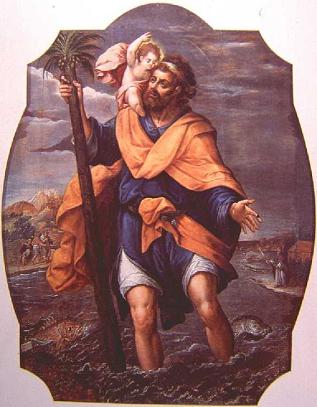
"St. Christopher with the Christ Child," by Simon Pereyns.
Interestingly, the Cynocephalic races can be juxtaposed with Amazons, barbarians, cannibals, and Cannabis smoking.
China has seen itself as the unmoving center and the surrounding barbarians of its northern and western borders as a volatile threat. Cannabis, as the chosen drug of many of these neighbouring peoples, would have been an unsavoury choice for many Han Chinese, who didn't wish to indulge in 'barbarian habits'.
In the fifth century BC the Greek historian Herodotus wrote of the use of cannabis by the Scythian people of the Black Sea region:
"On a framework of tree sticks, meeting at the top, they stretch pieces of woollen cloth. Inside this tent they put a dish with hot stones on it. Then they take some hemp seed, creep into the tent, and throw the seed on the hot stones. At once it begins to smoke, giving off a vapour unsurpassed by any vapour bath one could find in Greece. The Scythians enjoy it so much they howl with pleasure."
-Richard Rudgley, The Encyclopedia of Psychoactive Substances.
While the area has been inhabited by dozens of distinct peoples, these have generally been grouped under various all-purpose names that have changed over the ages; Scythian, Parthian, Hun, Turk, and Mongol are the terms most commonly employed by all three great traditions. We may infer, then, that it has been the central Asian nomads who have been the prime candidates, among the Europeans, Indians, and Chinese, for identification with their Dog-Men. We have also noted that in all three interpretive traditions, these
"cynanthropized" central Asian peoples have quite often been juxtaposed with an Amazonian race of women.
From Virgil's day at least, the Amazons were identified with the women warriors
of "Scythia." As we shall see, these women came to be closely associated with the Cynocephali in later European, as well as Chinese and central Asian traditions.
-David Gordon White, Myth of the Dog-Man.
This brings us back, with a jolt, to the giant,
cynocephali, lamp-bearing St. Christopher with whom we opened this chapter.
Christopher's name has been glossed, since the time of his earliest Western hagiographies, as the bearer of Christ (Greek Christo-phoros). There exists, however, an alternative reading of his name: Christ-Apherou,
"the way-opener of the Christ," a fusion of names and functions of the same order as Hermanubis!
Christopher is not the sole medieval Christian saint to be closely associated with the dog and the dog-star. Others include Dominic, James, Cucufat, and Guignefort. The first of these, the founder of the Dominican (Latin domini-canes) order, was born, according to legend, after his mother had dreamt that she was carrying a little dog with a torch in its mouth in her womb. Claude Gaignebet, in his brilliant study of the esoteric in Rabelais, A plus hault sens,
indicates that the torch in the dog's mouth was, for medieval commentators, a representation of the star Sirius in the mouth of the great dog, Canis major.
-David Gordon White, Myth of the Dog-Man.
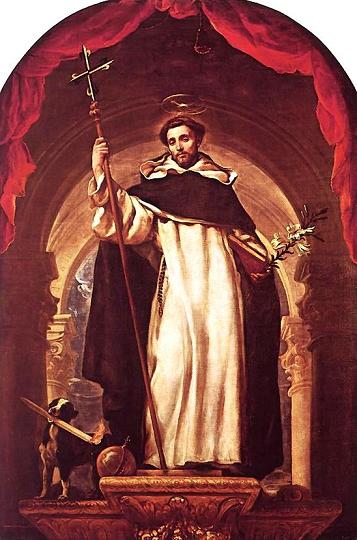
"St Dominic of Guzman," by Claudio Coello.
Dogs are also present in pagan world-views. St. Guignefort, although never canonized, has enjoyed a cult as a healer of childhood diseases in southern France (Dombes) and other parts of Europe until c.1950. As related by Bernard Hamilton in his book, Religion in the Medieval West.
"Thus, shortly before 1261, the Dominican inquisitor, Stephen of Bourbon, discovered that women in the Dombes, a region in southeast France, venerated St. Guinefort as a child-healer. Stephen was much edified by this until he was told that this saint was not, as he had supposed, a holy man, but a greyhound. A legend was associated with this hound, which is common to most Indo-European peoples: He had defended his master's child against a wild beast (in Guinefort's case, a huge snake), but had been suspected by his master of killing the child and had been wrongly stabbed to death by him."
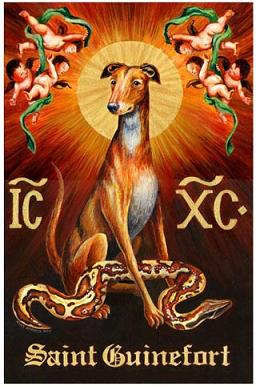
"St. Guinefort," by Kent Roberts.
Stephen of Bourbon's reaction was to immediately disinter and bum the poor dog saint's bones. An expurgated version of this story still survives in the Walt Disney movie, "Lady and the Tramp."
St. Michael, like St. George and Indra, is the slayer of dragons. The first picture above shows Louis XI, King of France and the members of the St Michael Order established by the King in 1469 at Amboise. In the background on the wall, hangs a painting representing the battle of St Michael, in the foreground two dogs are symbolizing the force used against the dragon. The coat-of-arms of the king can be seen between two angels. The second picture is from the Castle of Pierrefonds and shows St. Michael killing the dragon. Notice the two dogs and the coat-of-arms.
Contemplate the meaning of the pictures below.
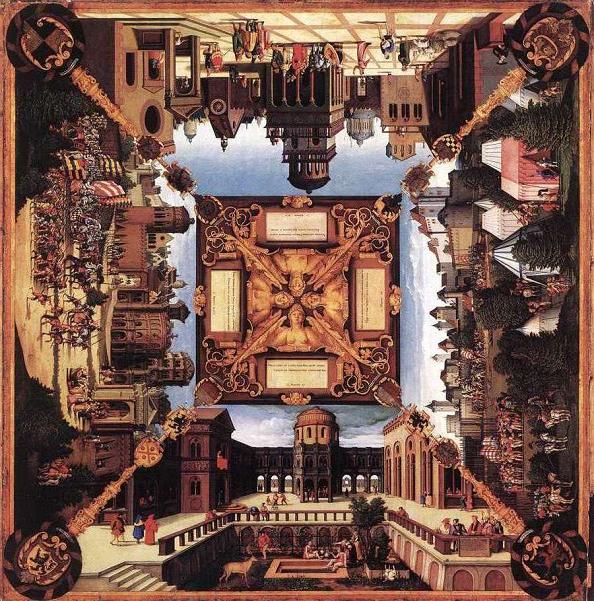
"Scenes from the Life of David," by Hans Sebald Beham.
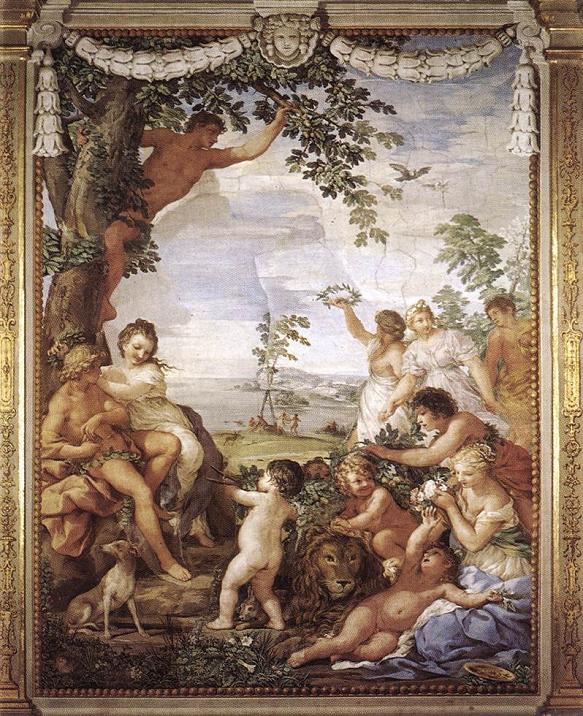
"The Golden Age," by Pietro da Cortona.
|
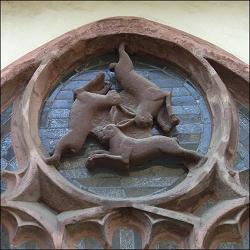
Paderborn cathedral. |
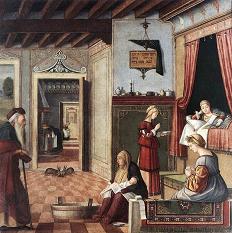
"Birth of the Virgin," by Vittore Carpaccio. |
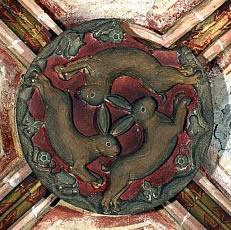
Medieval roof boss, Wissembourg. |
The Three Hares.
http://www.threehares.net/
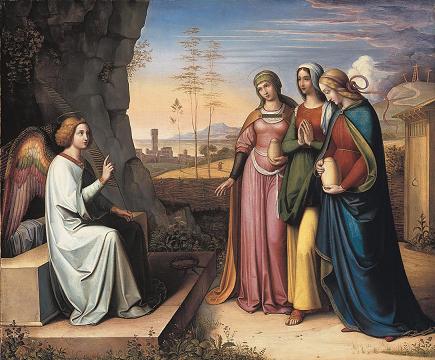
"The Three Maries at
the tomb," by Peter von Cornelius.
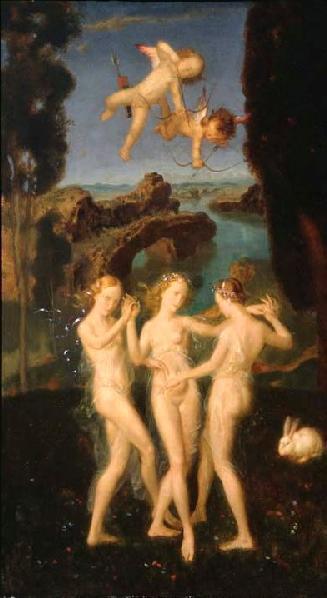
"The Three Graces" (ca. 1920), by Theodor Baierl.
|
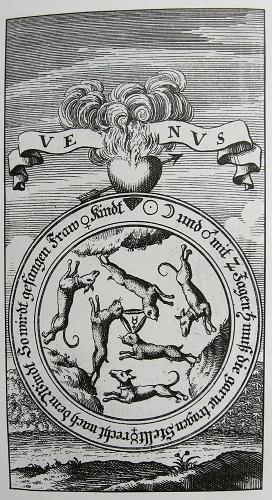
Basil Valentine, Chymical writings, Hamburg, 1717. |
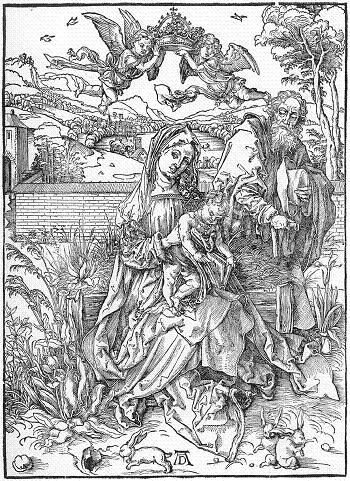
"Holy Family with Three Hares," by Albrecht Durer. |
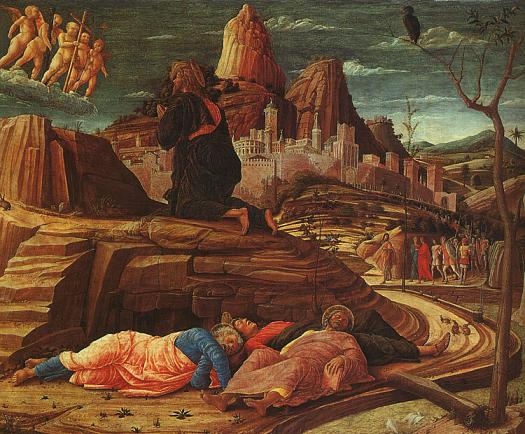
"Agony in the Garden," by Andrea Mantegna.
|

Mission of Conca, Queretaro, Mexico.
|
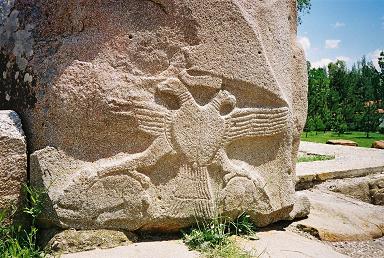
Hittite temple carving of
two headed eagle with two rabbits in its claws, Turkey.
|
A Russian porcelain figurine from the 1960's, and two Easter Bunnys.

"Allegory of Divine Wisdom,"
by Andrea
Sacchi.
.
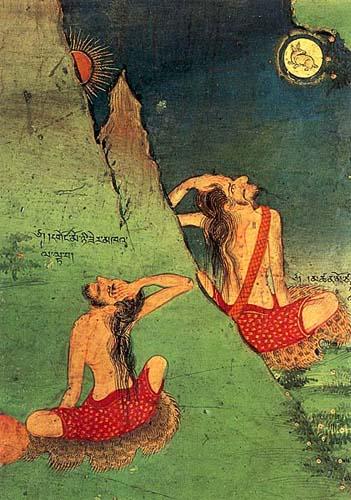
Rishis,
(illumined sages) of ancient India. The Lukhang murals.
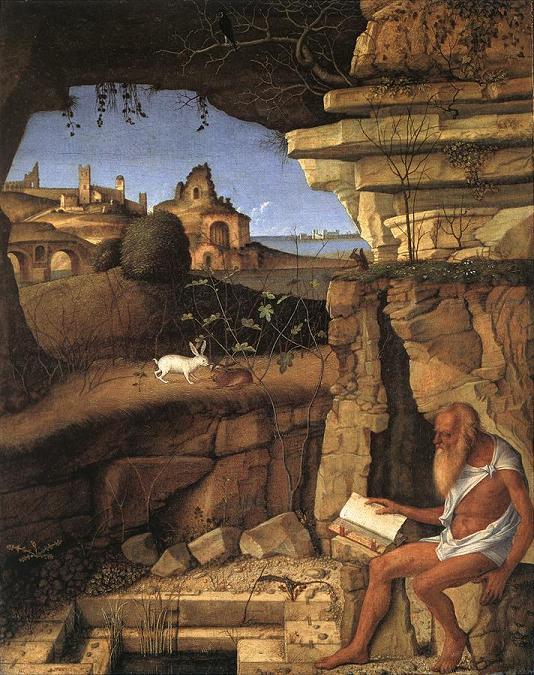
"St. Jerome Reading in the Countryside," by Giovanni Bellini.
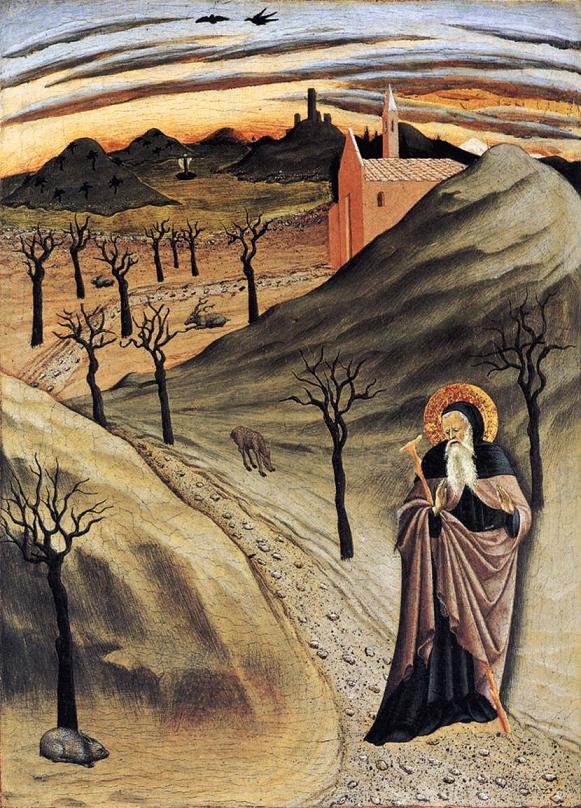
"Saint Anthony Abbot tempted by a heap of gold," ca. 1435, by Master of the Osservanza. The ground at the lower left, now empty, originally showed a pot of gold, a symbol of seductive worldly goods that the stalwart saint resists. The detail was scraped away during the painting's early history.
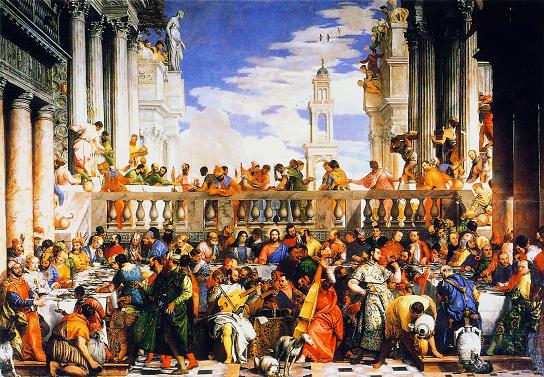
"The Marriage at Cana," by Paolo
Veronese. The holy marriage that's happening within the human body, transforming water into
wine, the marriage where Jesus is married to Mary, as Christ to Sophia.
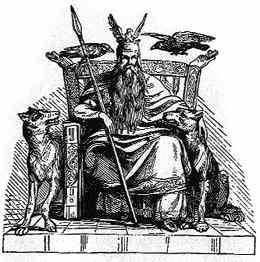
Odin.
One of the most intriguing aspects of
ethnomycology and ethnobotany is how widespread the myths connected to Amanita
muscaria and Cannabis sativa are and how much similarities they contain, whether
they are from Europe, America or Asia. If anything, this indicates the
fundamental role the mushroom and the hemp plant has played in human culture, one that
goes back to prehistoric times.
Besides humans, two other animals, the deer and the raven, are known to relish
the
Amanita muscaria. The raven's love for the mushroom was noted in
antiquity where in ancient Egypt the Amanita muscaria was called "raven's
bread."
Fly agaric has been known
since antiquity. The Egyptians called it
"raven's bread," a name which
it has retained in Central and Eastern Europe to the present day. It was
said that Saint Anthony ate this raven's bread before the ancient pagan
gods appeared to him as demons. According to Graves (1961), the
followers of Dionysos consumed fly agaric during the Dionysian festivals
and mysteries, for it
"bestows enormous physical power, erotic potency,
delusional visions, and the gift of prophecy." One author has even
argued that Christianity began as a fly agaric cult (Allegro 1970).
There is also some evidence that the pre-historic
"Beaker People" of
Stonehenge, and later the British Celts, used fly agaric in a cultic
context.
Among the ancient Germans, the fly agaric was associated with
Wotan/Odin, the god of ecstasy and the discoverer of the magical runes.
According to legend, fly agarics appeared where the foam from Wotan's
horse fell onto the earth. The name raven's bread refers to Wotan's two
all-knowing, all-seeing ravens.
-Christian Ratsch, The Dictionary of Sacred and Magical Plants.
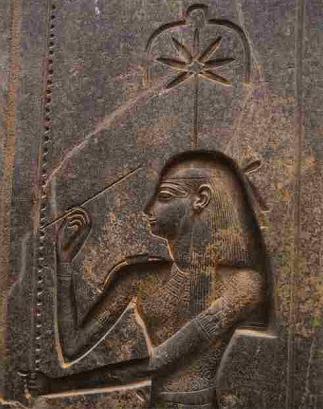
Seshat with her
emblem on a temple wall in Luxor, 1250 BCE. Seshat (also spelled
Sesheta, "sesheta" meaning hidden things, mysteries, secrets) was the
ancient Egyptian goddess of wisdom, knowledge, and writing. Further more
Seshat was the opener of the door to heaven as expressed in coffin text
spell 10. Notice on the above picture the star in the center of the
emblem. Ever wondered "Why is a raven like a writing desk?" Quote
from Alice's Adventures in Wonderland written by Charles Lutwidge
Dodgson under the pseudonym Lewis Carroll.
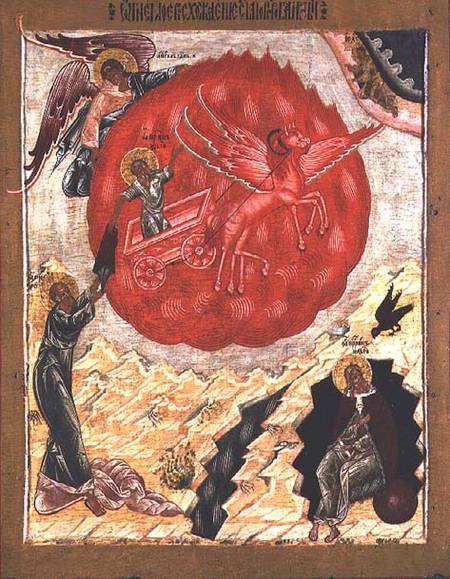
Russian icon of the
Prophet Elijah in the wilderness and his Fiery Ascent into Heaven. Notice the
raven bringing Elijah bread send from God. (c.1600).
Folklore from all over the northern
hemisphere implies the raven with Amanita muscaria. For instance in Japan "beni
tengu take" translates as "red long nosed goblin mushroom," meaning the Amanita
muscaria.
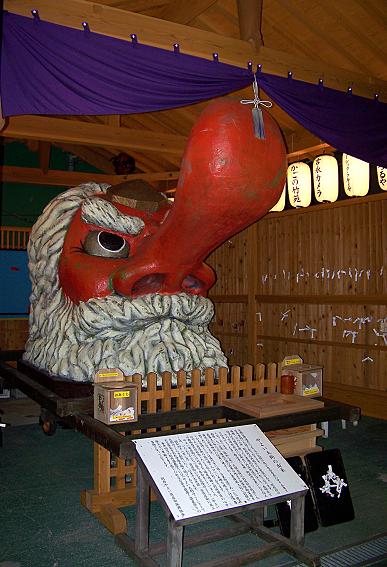
Tengu shrine in Beppu,
Japan. The term tengu means "heavenly dog."
The origin of the word tengu is Chinese, where it is written with the same
characters though pronounced tiangou, "celestial hound." A particular tengu is
the "karasu tengu" the "raven tengu." The karasu tengu is sometimes associated
with the Indian Garuda, the eagle-god of the Vedas.
A man named Krokos, named
for his "Saffron" hue, was said to have been the first to dwell on the
other side of the lake as husband to the Eleusinian Saisara, the
"Grinning Bitch," a name that was an epithet for the terrible queen
amongst the dead, before the Mystery had pacified her and changed her
name. Appropriately, only the priesthood had the prerogative of fishing
in those waters, for it was they, the inheritors of the office, who
regulated the transfer from life to death, a passage which the
Eleusinian faith viewed as a metaphysical union between lovers across a
division of water.
-Carl A. P. Ruck, Sacred Mushrooms of the Goddess.
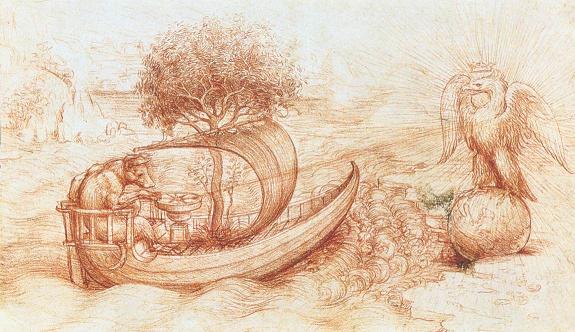
"Allegory with
wolf and eagle," by Leonardo da Vinci.
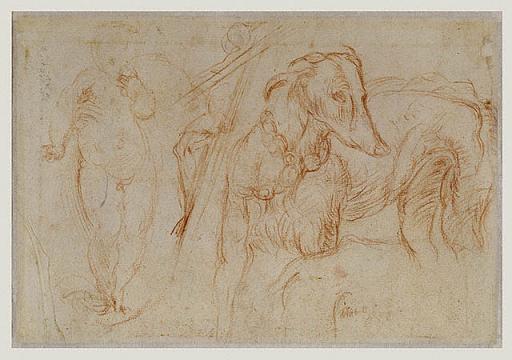
"Studies of the Christ Child, a Crucifix, and a Dog,"
by Parmigianino.
The dog, because of its faithfulness, denotes the relationship which should exist between disciple and master or between the initiate and his God. The shepherd dog was a type of the priestcraft. The dog's ability to sense and follow unseen persons for miles symbolized the transcendental power by which the philosopher follows the thread of truth through the labyrinth of earthly error. The dog is also the symbol of Mercury. The Dog Star, Sirius or Sothis, was sacred to the Egyptians because it presaged the annual inundations of the Nile.
.......is the mercury of the philosophers, essential to material existence.
In alchemy there are three symbolic substances: mercury, sulphur, and salt.
Sulphur because of its fiery nature was also associated with the sun.
The black and white ibis was sacred to the moon; but all forms were revered because they destroyed crocodile eggs, the crocodile being a symbol of the detested Typhon.
-Manly P. Hall, The Secret Teachings of All Ages.
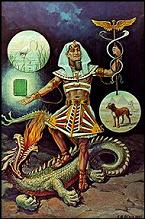
HERMES STANDING UPON THE BACK OF TYPHON.
Hermes, as the personification of Universal Wisdom, is here depicted with his foot upon the back of Typhon, the vanquished dragon of ignorance and perversion. To the Egyptian initiates Typhon, the devourer of souls, signified the lower world which swallows up the spiritual nature of the individual who, being imperfect, is forced to descent from the higher spheres and be reborn into the physical universe. To be swallowed by typhon therefore signifies the process of rebirth, from which man can only release himself by vanquishing his mortal Adversary.
In one hand Hermes carries the Caduceus, a winged rod with two fighting serpents entwined about it; in the other, the immortal Emerald, upon whose surface was inscribed in raised letters the sum of philosophy. The figure wears the ancient Egyptian Masonic apron according to the pattern discovered by Belzoni, the eminent Egyptologist. The two small circles contain the forms and symbols most closely associated with Hermes. In the upper circle is the ibis, whose curious characteristics have caused it to be particularly associated with the medical art. In the initiation ceremonies the Egyptian priests wore masks in form of the ibis head to signify that they represented the attributes of Thoth, or Hermes. The lower circle contains the dog, an animal always associated with Hermes because of its intelligence and devotion. Upon the forehead of Hermes appears the uraeus, the secret symbol of the constellation of Scorpio, which represent the regeneration of the same power that in the form of a dragon lies helpless under his foot. The scarab over the heart of Hermes represent the presence of the spiritual and regenerative light within his own soul; the collar typifies by its circles the orbit of the heavenly bodies. The three points of the tail of Typhon which end in arrows indicate the three destructive expressions of universal energy - mental, moral, and physical perversion. The entire diagram signifies mastery through the regeneration of the body, the illumination of the mind, and the transmutation of the emotion.
-Manly P. Hall, The Secret Teachings of All Ages.
The jackal is the canine scourge of the desert, whence the Egyptian Anubis, who in the Hellenistic age became domesticated into the cynocephalic Hermanubis or Mercury.
Plutarch and other Hellenistic authors identify Anubis with the star Sirius, and furthermore conflate him with the "canine" Greek god Hermes.
Second-century Alexandrian coins depict Hermes-Thoth together with cynocephalic apes and the caduceus, and another Ophite source, an "Abraxis" gemstone, depicts the cynocephalic Hermanubis holding a sceptre in each hand and standing between a half moon and a star; on the other side is the archon Michael.
-David Gordon White, Myth of the Dog-Man.
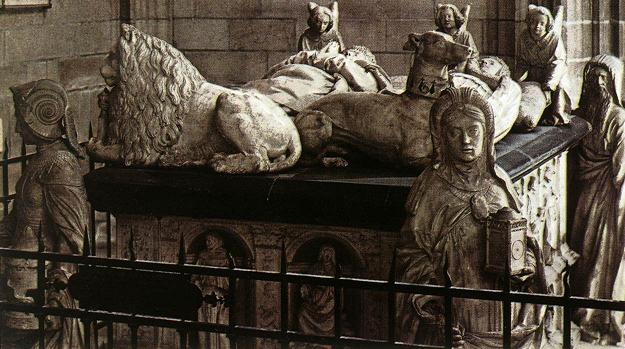
Tomb of Francis II of Brittany and his Wife Marguerite de Foix.
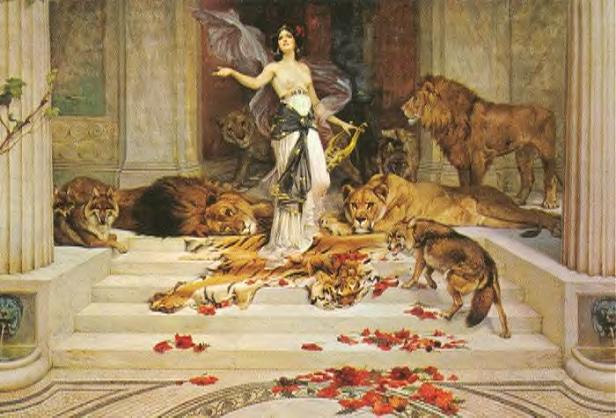
"Circe,"
by Wright Barker. Notice that the word church (kirke) is derived from Circe.
........neatly illustrates
the real meaning of
Kirkê,
"the Circle," or "Circular."
-Robert Braun, The Myth of
Kirkê.
The two pillars on the picture above,
are also known as Jachin and Boaz (2 Chronicles 3:17). These two pillars respectively connote the expressions of Divine Energy, the sun and the moon, sulphur and mercury, good and
evil, light and darkness. Between them is the door leading into the House of God, and standing thus at the gates of Sanctuary they are a reminder that Jehovah is both an androgynous and an anthropomorphic deity
(God created man in his own image, as male and female (Genesis
1:27)). These two pillars which are found in alchemy, art, mysticism and religion, originate from Adam
(Amanita muscaria) and Eve (Cannabis sativa), sometimes both represented by a lion. These pillars are also called Jesus (the second Adam) and Virgin Mary (the second Eve). Both these pillars can be found on the picture below.
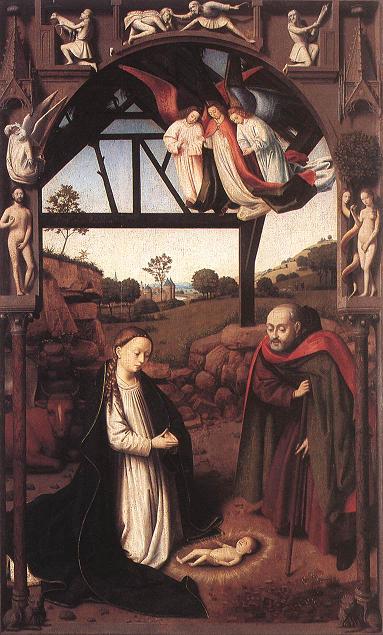
"Nativity," by Petrus Christus.
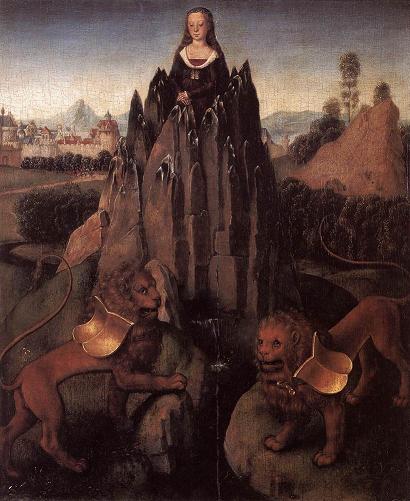
"Allegory with a Virgin," by Hans Memling.
Jesus the Rock
(1 Peter 2:4-8) and Virgin Mary, as the Fountain of Life.
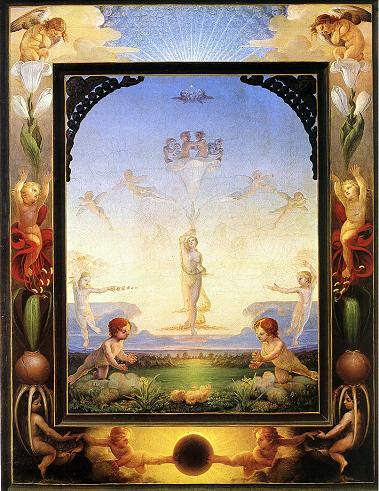
"Der kleine Morgen," by Philipp Otto Runge.
Lily and the dawn symbolize the rise of the age of the Holy Spirit.
-Alexander Roob, Alchemy and Mysticism.
If deeply immersed in the subject of religion and entheogens, the following part should prove the most interesting. In "Ploughing the clouds. The search for Irish Soma" Peter Lamborn Wilson tells the story of how Indra, with the help of the Maruts, slays the dragon (which in fact is a drought dragon). Indra can not slay it alone.
Before the Maruts were born, Indra tried to kill
them, but later they became his allies and helped him to slay Vrtra. An
interesting variant (1.85.9-11) describes how the Maruts help a sage named
Gotama by splitting open a mountain and releasing a fountain of water - a
replication of Indra's freeing the Waters from Vrtra's mountain. "Blowing on the reed-pipe, the Maruts performed joyous deeds in the ecstasy of drinking Soma." In RV 1.165, Indra and the Maruts engage in an uneasy dialogue. The Maruts boast of their dandyism (they "adorned themselves like women" (1.85.1)), and of their power in yoking both horses and gazelles (or deer) to their storm chariots. "Indra, you have always acknowledged our independent spirit." Indra answers, "Where was that independent spirit of yours, Maruts, when you left me all alone in the fight with the dragon?" The Maruts save face with a few more boasts, but then capitulate and begin to sing Indra's praises. Indra now forgives them: "Thus they shine forth facing me, the blameless band who take to themselves fame and the drink of ecstasy."
In the Brahmanas (IV,3,3,6-11) we find an elaboration of this uneasy relation between Indra and his merry Maruts, and the explanation of their reconciliation. The point of the passage is to explain why the Maruts receive a share of the Soma sacrifice, but only in the name of Indra:
Then as to why he draws the Marutvatiya cups (the cups for the Maruts). Now this, the midday pressing feast, is Indra's special (nishkevalya) feast: thereby he strove to smite Vrtra, thereby he strove to vanquish him. But the Maruts, having on that account withdrawn, were standing on an asvattha tree (Ficus Religiosa). Now Indra is the nobility, and the Maruts are the people, and through the people the noble becomes strong: therefore the two Ritu cups (they say) may be of asvattha wood; but in reality they are of karsmarya wood.
The ficus religiosa is Siva's (or Rudra's) tree. I do not understand the point about asvattha and karsmarya wood, but perhaps they symbolize the nobility and the people, or vice versa.
Indra called on them, saying, "Do ye join me that with you as my force I may smite Vrtra!" They said, "What will be our (reward) then?" He drew those two Marutvatiya cups for them.
"Marutvat" is an epithet of Indra as leader of the Maruts.
They said, "Having put aside this one (cup) for our vigour, we will join thee." Having accordingly put it aside for their vigour, they joined him. But Indra sought to obtain it, thinking, "They have come to me after putting aside their vigour."
It is not quite clear what's happening here, although it seems the Maruts are holding out for a greater share of Soma.
He said. "Do ye join me with vigour!" - "Then draw a third cup for us," they said. He drew a third cup for them, with, "Thou art taken with a support, - thee for the vigour of the Maruts!" They then joined him with vigour, - and he conquered with them, and smote Vrtra with them; - for Indra is the nobility, and the Maruts are the people, and through the people the noble becomes strong. Hence he now bestows that strength on nobility, and therefore he draws the Marutvatiya cups.
Let him draw them for Indra Marutvat (accompanied by the Maruts), and not for the Maruts likewise. For were he also to draw cups for the Maruts, he would make the people refractory to the nobility. He thus assigns to the Maruts a share therein after Indra, whereby he makes the people subservient and obedient to the nobility: therefore let him draw the cups for Indra Marutvat, and not for the Maruts likewise.
But he was afraid of their desertion, - "Lest they should desert me, lest they should take to some other (party)," so thinking, he by that (share in the libation) made them unwilling to desert him. This is why he should draw the grahas for Indra Marutvat.
-Peter Lamborn Wilson, Ploughing the clouds. The search for Irish Soma.
The Rg Vedic Maruts are Rudra and
Indra's companions, and they are associated in both the Rg Veda and the Atharva Veda with the seven vital breaths that howl like a whirlwind when leaving the body.
-David L. Spess, Soma : The Divine Hallucinogen.
Closely associated with Indra in his capacity as god of the thunderstorm, the Maruts are also linked to Rudra (1.85 ; cf. 2.33 and 1.114). It is precisely the overlapping of their functions with those of Indra that underlies a series of hymns debating their several rights to the sacrificial offering (1.165, 1.170, 1.171); ultimately, Indra is affirmed to be supreme.
-Wendy Doniger O'Flaherty, The Rig Veda.
The wild hunter of the Vedic forest was Rudra, the "howler" who, like Indra, was the lord of the Maruts, with whom the Vratyas identified themselves.
Apart from being identified with the Maruts, the Vratyas are also called dogs in the Vedic sources. . .
Most importantly Indra is, in the Vedic period, the master (when he is not her son) of the divine bitch Sarama,
the mother of Yama's two hellhounds, the Sarameyau.
-David Gordon White, Myth of the Dog-Man.
The Maruts are wind-gods portrayed always as a group, as a band of warriors who serve Indra.
-Wendy Doniger O'Flaherty, The Rig Veda.
Sarama, the divine bitch and companion to Indra, is also associated with the wind.
-David Gordon White, Myth of the Dog-Man.
Rig Veda 1.85
10. They forced up the fountain with their
power; they split open even the mountain on its solid base. Blowing their
reed-pipe, the Maruts who give fine gifts performed joyous deeds in the ecstasy
of drinking Soma.
11. They forced up the fountain in a stream that shot to the side; they poured
out the spring for the thirsty Gotama. Shining brilliantly, they came to him
with aid. They fulfilled the desire of the sage in their own ways.
-Wendy Doniger O'Flaherty, The Rig Veda.
Like Moses with his rod, Indra with the help of the Maruts frees the life-giving waters from the mountain. In a similar story (Rig Veda, 3.31), Indra with the help of Sarama (the bitch of Indra) finds and frees the cows in the cave, symbolic of the releasing of the waters, pent-up by the demons of drought.
(All of Rig Veda 1.85, as cited by Wendy Doniger O'Flaherty, is of
interest for the subject at hand).
In the text below, the Soma sacrifice needs something to be free from danger and injury. Logic dictates that it is Cannabis sativa. Brahmanas 18 - 21.
18. When the head of the sacrifice was struck off its sap, running, entered the waters; those gandharva Soma-wardens watched it.
19. The gods then said, "Those gandharvas, surely, are a great danger to us here, how can we carry off the sap of the sacrifice to a place free from danger and injury?"
20. They said, "Well, the gandharvas are fond of women; let us go together with the wives! The gandharvas, surely, will hanker after the wives, and we shall carry off that sap of the sacrifice to a place free from danger and injury."
21. They went with the wives; the gandharvas did indeed hanker after the wives, and they (the gods) carried off the sap of the sacrifice to a place free from danger and injury.
-Peter Lamborn Wilson, Ploughing the clouds. The search for Irish Soma.
In passing it may be worth mentioning that the Tibetan word for Cannabis and its drug products is So.Ma.Ra.Dza. This appears to be a direct borrowing from the Sanskrit soma-raja (Eng.:
"King soma," "Royal soma"). The term soma-raja is glossed as "king soma,
the moon" in Monier-William's Sanskrit dictionary although the Rig Veda, in its hymns of praise to the drug, refers to it frequently as "King soma" (8.48.8, 8.79.8 etc.)
-Mike Crowley, When the Gods Drank Urine.
Still quoting the Rig Veda, book 10, hymn 85.
3. One thinks he has drunk Soma when they press the plant. But the Soma that the Brahmins know - no one ever eats that. (2)
4. Hidden by those charged with veiling you, protected by those who live on high, O Soma, you stand listening to the pressing-stones. No earthling eats you.
5. When they drink you who are a god, then you are filled up again. Vayu is the guardian of Soma; the moon is the one that shapes the years.
Notes:
(2). Verses 3-5 play upon the different Somas: the plant that is pressed, the god that the Brahmins know, the god protected in heaven, the plant between the pressing-stones, the juice that they drink, the moon that is drained of Soma and filled again, waxing and waning.
-Wendy Doniger O'Flaherty, The Rig Veda.
The Soma plant, Amanita muscaria, is standing listening, while bhang, the known part of the Soma sacrifice, is being prepared. To make bhang the stalk of Cannabis sativa is being hit between stones to get the juice out, whereas the juice from Amanita muscaris is squeezed out just like a sponge is squeezed. Quoting from the Rig Veda.
Book 9, hymn 11.
4. Sing a praise-song to Soma brown
of hue, of independent might. The Red, who reaches up to heaven.
5. Purify Soma when effused with stones which hands move rapidly, and pour the
sweet milk in the meath.
Book 9, hymn 9.
1. The Sage of Heaven whose heart is wise, when laid between both hands and pressed, Sends us delightful powers of life.
-Ralph T. H. Griffith (translator), Rig-Veda.
It is interesting that in a number of related Indo-European languages, bangha, the Iranian word for hemp, simultaneously refers to mushroom intoxication, and the hemp plant itself. To day in India, certain concoctions of Cannabis are known as bhang, and there are those who still insist that bhang is the Soma of the Vedic hymns, a contention with which R. Gordon Wasson especially has taken sharp issue.
It is true, however, that according to one
tradition in India the resin of Cannabis, under the name Vijaya,
was the favourite drink of the god Indra and that he gave it to the people so
that they might attain elevated states of consciousness, delight in worldly joy,
and freedom from fear. Hence it is customary for Hindus to throw idols into the
river and rejoice with friends by embracing and drinking bhang* on the
last day of the Durga pooja.
* Bhang is a decoction of water, milk,
Cannabis resin, cucumber and melon seeds, sugar, and black pepper.
-William A. Emboden, Jr.
-Peter T. Furst (editor), Flesh of the Gods.
The Rig Veda, book 9, is entirely dedicated to Soma. In this book Indu (the moon) is pressed out between stones and cleansed, running through the fleece, blending with Indra (the sun) on its way, flowing like a wave, to and through the human body. It is the favourite drink of Indra and gives him the ability to slay the dragon Vrtra, that is, purifying Amanita muscaria with Cannabis sativa.
Book 9, hymn 109.
11. The pressers purify this juice of thine, the Soma, for delight, and lofty fame.
12. They deck the Gold-hued Infant, newlyborn, even Soma, Indu, in the sieve for Gods.
13. Fair Indu hath flowed on for rapturous joy, Sage for good fortune in the waters' lap.
14. He bears the beauteous name of Indra, that wherewith he overcame all demon foes.
15. All Deities are wont to drink of him, pressed by the men and blend with milk and curds.
16. He hath flowed forth with thousand streams effused, flowed through the filter and the sheep's long wool.
17. With endless genial flow the Strong hath run, purified by the waters, blend with milk.
18. Pressed out with stones, directed by the men, go forth, O Soma, into Indra's throat.
19. The mighty Soma with a thousand streams is poured to Indra through the cleansing sieve.
20. Indu they balm with pleasant milky juice for Indra, for the Steer, for his delight.
21. Lightly, for sheen, they cleanse thee for the Gods, gold-coloured, wearing water as thy robe.
22. Indu to Indra streams, yea, downward streams, Strong, flowing to the floods, and mingling -there.
Book 9, hymn 113.
1. Let Vrtra-slaying Indra drink Soma by Saryanavan's side,
Storing up vigour in his heart, prepared to do heroic deeds. Flow, Indu, flow for Indra's sake.
Book 9, hymn 106.
1. To Indra, to the Mighty Steer, may these gold-coloured juices go,
Drops rapidly produced, that find the light of heaven.
2. Effused, this juice victorious flows for Indra, for his maintenance.
Soma bethinks him of the Conqueror, as he knows.
3. May Indra in his raptures gain from him the grasp that gathers spoil,
And, winning waters, wield the steerstrong thunderbolt.
4. Flow vigilant for Indra, thou Soma, yea, Indu, run thou on:
Bring hither splendid strength that finds the light of heaven.
Book 9, hymn 72.
5. O Indra, urged by arms of men and poured in streams, Soma flows on for thee after his Godlike kind.
Plans thou fulfillest, gatherest thoughts for sacrifice: in the bowls sits the Gold-hued like a roosting bird.
6. Sages well-skilled in work, intelligent, drain out the stalk that roars, the Sage, the Everlasting One.
The milk, the hymns unite them with him in the place of sacrifice, his seat who is produced anew.
7. Earth's central point, sustainer of the mighty heavens, distilled into the streams, into the waters' wave,
As Indra's thunderbolt, Steer with farspreading wealth, Soma is flowing on to make the heart rejoice.
-Ralph T. H. Griffith (translator), Rig-Veda.
Soma consists of two elements, Amanita muscaria and Cannabis sativa, sometime called the sun and the moon, heaven and earth, Indra and Indu, husband and wife.
Book 9, hymn 74.
2. He who is the pillar of the sky, the well-adorned support, the full stalk that encircles all around, he is the one who by tradition sacrifices to these two great world-halves. The poet holds together the conjoined pair, and the refreshing foods.
-Wendy Doniger O'Flaherty, The Rig Veda.
Book 9, hymn 18.
4. He who containeth in his hands all treasures much to be desired:
All-bounteous art thou in carouse.
5. Who milketh out this mighty Pair, the Earth and Heaven, like mother kine
All-bounteous art thou in carouse.
Book 9, hymn 66.
1. For holy lore of every sort, flow onward thou whom all men love.
A Friend to be besought by friends.
2. O'er all thou rulest with these Two which, Soma Pavamana, stand,
Turned, as thy stations, hitherward.
Book 9, hymn 68.
3. The gladdening drink that measured out the meeting Twins fills full with milk the Eternal Ever-waxing Pair.
Bringing to light the Two great Regions limitless, moving above them he gained sheen that never fades.
-Ralph T. H. Griffith (translator), Rig-Veda.
As has been shown, the Indo-European
myths abound in symbolism pertaining to the combined use of Amanita muscaria and
Cannabis sativa. Many of the Aryan fairytales bring the same story.
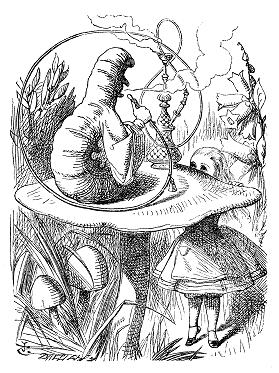
Illustration by John
Tenniel. From Alice's Adventure in wonderland.
Here is the start and the end of an old Russian one.
This is a story from the mysterious Ural Mountains. It comes from a time when the spirits of forests and mountains still moved among humans, watching them, searching for those who could be taught their secrets before such ancient wisdom was lost forever. One such spirit was especially revered for her magic and great beauty. Some people knew her as an ancient mountain goddess; others called her the Mistress of the Copper Mountain, or the Malachite Lady, a name taken from the lovely green stone so often found in areas rich in copper...........
............Turning back to Katya, she reached into her flowing sleeves and pulled out a malachite box. "I entrust it to you, Katya. I've already given Danila the secret of the Stone Flower, but to you, I give of my own essence." Katya opened the box and gasped. It was filled with pebbles and jewels in all the colours of the rainbow. She picked up a plain stone of polished granite and saw the goddess blur into a spirit of grey mists and fog with a laughter as rich as summer thunder. Then a piece of amber, and the mists swirled downward and turned into a small woman in golden robes embroidered with pine needles. A ruby, and the goddess grew tall, dressed in snapping flames. Lapis Luzuli, and she turned into a cosmic mother whose robes were the night sky scattered with stars. She smiled at Katya. "Back in your world, you'll no longer see me as you just have, but the power remains coiled in each stone, responsive to a heart wise enough to understand."
Then she vanished.
-Pavel Bazhov, Hostess of the Copper Mountain.
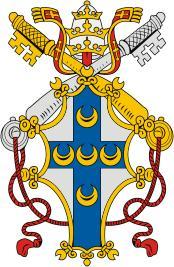
Pius II (Pope), Coat of arms.
Jesus said, "The Pharisees and the scribes have taken the keys of knowledge (gnosis) and hidden them. They themselves have not entered, nor have they allowed to enter those who wish to. You, however, be as wise as serpents and as innocent as doves."
-The Gospel of Thomas.
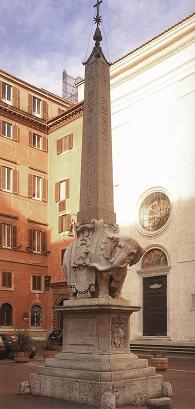
"Pulcino della Minerva," Rome, Italy.
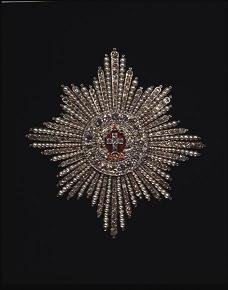
The Star of the Order of the Elephant, brilliants and pearls on gold and enamel. Possibly made c. 1770 by J.F. Fistaine. This beautiful star tells the story of the Aryan Soma. Amanita muscaria with the flame of the holy spirit, Cannabis sativa, and in the very centre, the
Sun Cross.
1. Thy streams that never fail or waste flow forth like showers of rain from heaven,
To bring a thousand stores of strength.
2. He flows beholding on his way all wellbeloved sacred lore,
Green-tinted, brandishing his arms.
3. He, when the people deck him like a docile king of elephants.
Sits as a falcon in the wood.
4. So bring thou hitherward to us, Indu, while thou art purified,
All treasures both of heaven and earth.
-Ralph T. H. Griffith (translator), Rig-Veda,
book 9, hymn 57.
In Hinduism, the elephant-headed god Ganesha, son of Shiva and Parvati, refers to the "lord of the hosts," and is one of the most well-known and venerated representations of God (Brahman). Ganesha in fact, is the symbol of he who has discovered the Divinity within himself. Ganesha is the first sound, OM, in which all hymns were born. Furthermore, Indra, King of the Gods, is often depicted riding the white-skinned elephant, Airavata. This Divine Elephant is thought of as the progenitor of all earthly elephants and is understood as the embodiment of the huge clouds pregnant with the monsoon rains. In fact, in the Bhagavad Gita, God says: Amongst the demigods
"I am Indra" (10.22) and "amongst the finest of elephants I am Airavata"
(10.27). And last but not least, the Buddha's birth was heralded in a
dream by a white elephant.
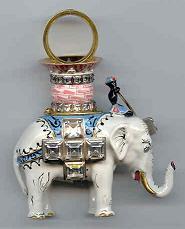
The Order of the Elephant. The finest Danish distinction.
The organ facade in Vor Frelsers Kirke, Copenhagen, full of mystical symbols. Below two elephants, above two clock faces with illustrations of the sun and the moon, and in the middle a bust of King Christian V, and the star.
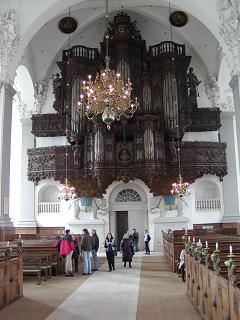
The big elephant and its mate represent Adam and Eve. -The Aberdeen Bestiary. The fleur-de-lis
is on the cover of the elephants, and keep in mind that Adam and Eve covered their nakedness with fig leaves.
Genesis 3:7
And the eyes of them both
were opened, and they knew that they were naked; and they sewed
fig leaves
together, and made themselves aprons.
-The Bible.
It was a Christian tradition that the Virgin Mary earned her living by spinning.
-Timothy Freke & Peter Gandy,
Jesus and the lost Goddess.
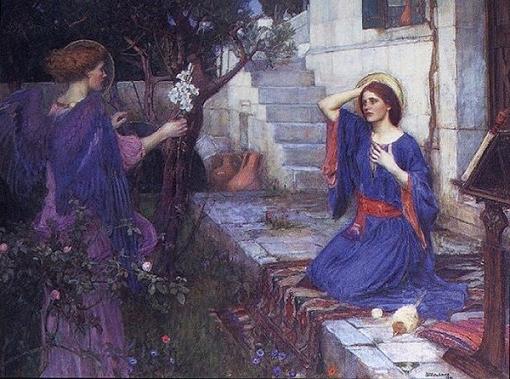
"The Annunciation," by John William Waterhouse.
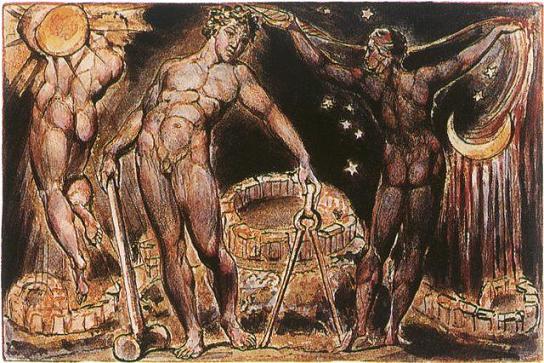
"Jerusalem," by William Blake.
The use of fiber from Cannabis, the
"True Hemp," has declined sharply over the last two centuries, but before the
Industrial revolution, hemp was a popular fiber because of its strengths and
quick growths. And since the earliest times, this great plant ally has provided
people with cordage, cloth, paper, medicine, oil, food, and inspiration. It is a
plant with a thousand applications.
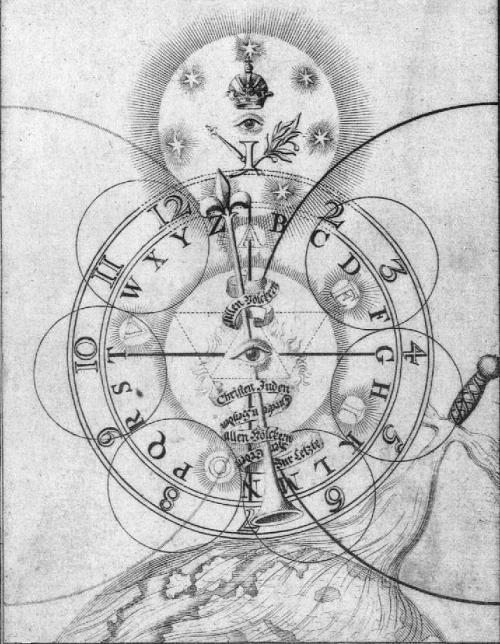
From Alle Theosophische Schrifften, by
Jacob Boehme (1575 - 1624). Of special interest is the sword made of
fibres, and the female
Cannabis sativa bud with two male sex organs, a hermaphrodite,
stylized as an olive branch with two olives.
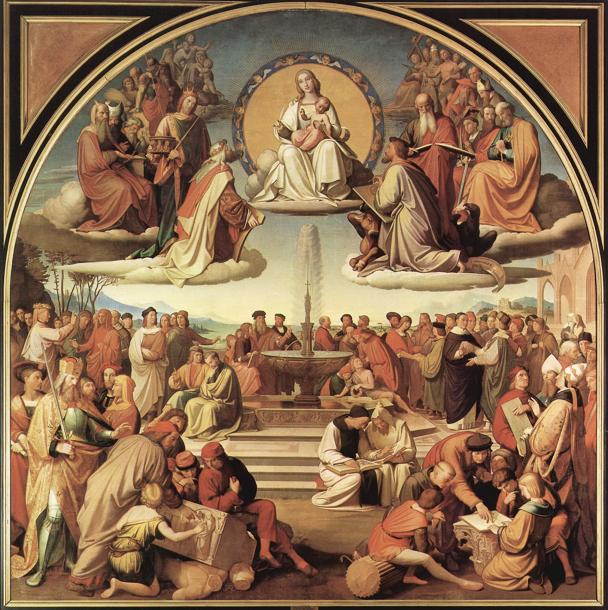
"The Triumph of Religion in the Arts," by Friedrich
Overbeck (1789 - 1869).
Friedrich
Overbeck was a Romantic painter and the central figure of the Nazarene
movement. In 1809, he together with five students at the Vienna Academy,
formed an artistic cooperative called the Brotherhood of St. Luke or Lukasbund, following a common name for medieval guilds of painters. In
1810, Friedrich Overbeck and three of them moved to Rome, where they
occupied the abandoned monastery of San Isidoro and lived a semi-monastic
existence, as a way of re-creating the nature of the medieval artist's
workshop. Religious subjects dominated their output. The name Nazarene
came from a term of derision used against them for their affectation of
a biblical manner of clothing and hair style and was adopted by the group
who aimed to revive honesty and spirituality in Christian art. Notice on the above
picture, the head of Jesus, and in the bottom left corner,
the
sword and the green plant,
possibly an olive branch. The painting was commissioned by the Stadel
Institute in Frankfurt, where Philipp Veit had just become Director, and took
Overbeck nearly a decade to complete (1833 - 1840).

"The Introduction
of the Arts into Germany through Christianity."
"The Allegoric
figure Italia."
"The Allegoric figure Germania."
Fresco (1832 -1836), by Philipp Veit
(1793 - 1877), created for the
Stadel Institute on similar lines as Friedrich Overbeck's "The Triumph of
Religion in the Arts." Notice the wellspring at the base of the felled
sacred oak tree and the sword lying on the word.
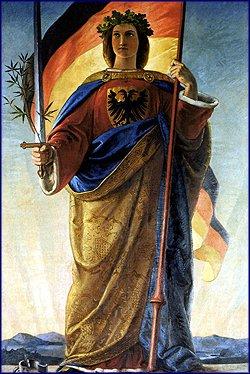
"Germania," by Philipp Veit, painted in March during
the Revolutions of 1848. It was used as an allegoric decoration in the
National Assembly in Frankfurt's Paulskirche,
where it concealed the organ. It was meant as a symbol of a united
democratic Germany and remained a national personification until the end of
World War I.
Philipp
Veit was headmaster of the art
school and Director of the art collections at the Stadel Institute from 1830 to 1843. Veit was a Romantic painter and part of
the Nazarene movement in Rome. The fundamental element of the Nazarene
project was their belief that only the rise of a new religiosity, a
re-Christianization, could lead to an artistic as well as political
renewal. On the four pictures above, as in the Christian
scriptures (Ephesians 6:17), the sword is a metaphor for the Word of
God. On the picture "The Allegoric figure Germania," Germania is
sitting in front of three trees (oak, beech or is it birch, and fir), all of which are
host trees for Amanita muscaria and Amanita panterina. On her head,
Germania is wearing a crown of oak leaves and her inner garment is
brownish with a white rim on the sleeves, both of which symbolizes the
Amanita pantherina. On the picture "Germania," Germania is holding the
sword together with a branch of Cannabis sativa in her right hand, thus
showing the connection between Cannabis and the Word of God. On her
head, Germania is wearing a crown of oak leaves, and her inner garment
is red with a white rim on the sleeves, both of which symbolizes the
Amanita muscaria. And the double eagle, the symbol of the Soma,
is present on the last two pictures mentioned.
This brings us to the theme of twins in
mythology, derived from the Amanita muscaria and the Amanita pantherina, and the two
natures of the sun.
There is one remarkable feature that
links Minoan/Mycenaean and central European/Nordic Bronze Age religion,
which has often been ignored or overlooked. That is the twin gods and
goddesses. They march hand in hand with a penetrating twin symbolism or
duality in the whole religious structure and in the accompanying
material culture of both societies, and may even have structured the
political leadership, as we shall see demonstrated later.
Since this duality of the twin gods
appears as a structuring principle both in the Aegean and in northern
Europe during the early mid-second millennium BC we should look more
closely at its possible manifestation in Indo-European religion.
Common to all societies is the
recognition of origin, a beginning, which refers to a cosmological point
of origin, such as the birth of Christ or Mohammed. This underscores a
perception of cosmological continuity, a shared heritage, which may be
broken only by exceptional circumstances of major historical disruptions
and social transformations. In early state societies genealogical lists
of kings and ancestors would constitute a time frame that linked mortals
and gods together, supported by myth, such as the story of Gilgamesh, an
early king of Uruk from the mid-third millennium BC. His adventures (with
his "twin" brother Enkidu) evolved into a heroic and mythological
prototype about the relation between humans and gods, the meaning of
life and how to become heroic and wise. It was translated and preserved
for more than 2000 years throughout the Near East, as part of a common
cultural heritage. It thus transcended its original cultural context and
became part of a larger cosmological context that was shared by the
societies of the Near East and the east Mediterranean during the Bronze
Age and the Early Iron Age, who in turn incorporated part of it into
their local myths and tales. It thereby exemplifies how shared
traditions and local cultures co-existed during the Bronze Age, being
part of what we have called the Bronze Age world system.
A concrete example of that was the
shared religious and political institution of the Sun Maiden and her
Divine brothers, which would be incorporated and renamed time and time
again during the Bronze Age. It appeared in the written texts from India
to the Baltic and Greece over a period of more than 1000 years, changing
only the names, but not the basic structure of the myth and its
institution. This persistence in the written record can be verified by
independent archaeological means, as we shall demonstrate.
The
beginning of a new cosmological time in the North was marked by a major
social transformation around 1500 BC. Within one or two generations
there emerged a new Nordic tradition in metalwork, a new chiefly culture
that reshaped landscape and settlements, and a building programme of
monumental barrows for the local chiefly elites (Kristiansen 1998).
Within a brief period of 200 years it resulted in the construction of
tens of thousands of barrows, which even to day dominate the landscape
in many regions in southern Scandinavia. The adoption of the spiral
motif was a conscious choice to signal that the ancestors of the Nordic
culture originated in Minoan and Mycenaean culture, whose institutions
they had selectively adopted and recontextualised during the preceding
generations. By 1500 BC, in an explosion of creativity, the new social
order was materialised into a new cultural order that persisted for
nearly 1000 years in unbroken tradition, yet incorporating new rituals
and symbols along the way. Central among these was the institution of
the Sun Maiden and her twin brothers, linked to and supporting the
institution of twin rulers.
In a special study of the "Divine Twins" Donald Ward (1968) has defined their roles and attributes in
Proto-Indo-European religion in some detail. The Indo-Iranian tradition,
especially the Rig-Veda, constitutes the most detailed and important
source on the Divine Twins, but the Greco-Roman and Baltic traditions
also entail strong evidence. It is also clear that they are going back
to the same source, as they share so many similar traits that any random
or separate development can be eliminated. What interest us here,
however, are the roles and attributes of the Divine Twins and their
sister the sun-goddess/maiden, as they can be demonstrated
archaeologically. The Divine Twins are called the Asvins in the Rig-Veda
and the Diskouroi in the Greek traditions, in both cases sons of the
sky-god.
Here there is also an old Vedic name
for the father of the Divine Twins. His name *Tw-atr, meaning two-star,
goes back to Proto-Indo-European language and Tocharian, and attests an
old origin in the Caucasus for this myth. (Colarusso 2002: 240ff.).
The
recent discovery of a bronze disc of the universe with moon, sun and
stars in silver from Nebra near Halle, accompanied by twin swords and
axes, is an illuminating example of the central symbols of the Divine
Twins from the seventeenth-sixteenth centuries BC. It further
demonstrates their relationship with the course of the sun, moon and
stars.
-Kristian Kristiansen, Thomas B. Larsson, The Rise of Bronze Age
Society.
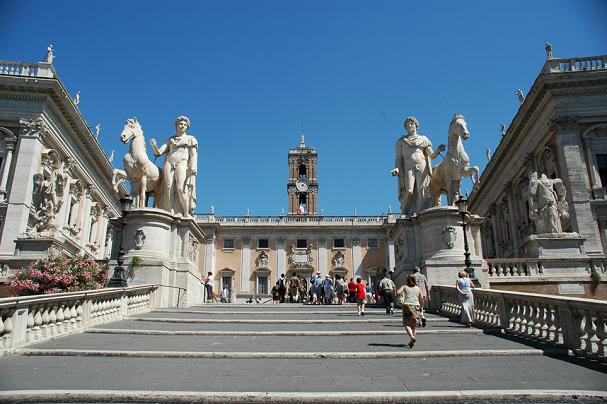
The Dioskouroi on Capitoline Hill in Rome. One is mortal and
the other immortal.
That the Dioscuri, when they have
appeared at important functions in Greek or Roman history, wore scarlet
chlamydes can be deduced from the traditional account of their heroical
deeds, which frequently make mention of their dress and involve us in
the belief that the colour is significant: no doubt if the coins or
other monuments, on which they are represented riding victoriously
towards or from some great enterprise, could talk to us in colour as
well as in form, they would say the same thing, for it is the same
chlamys in metal or stone that is described as red in the prose of the
historians: and just as we know that their horses, wherever represented,
are, for the most part, white, so we know that their robes, flying in
the wind, are red.
With regard to the Dioscuri
themselves, the association of red colour with them, is not a mere Roman
peculiarity: it must be an Aryan idea, for we find that the Veda
says that red is the proper colour of the Asvins (the Indian
horsemen, who correspond to the Dioscuri).
-J. Rendel Harris, Boanerges.
Now the star, whether single or double, is the sign of the
twin-brethren.
-J. Rendel Harris, The Dioscuri in the Christian Legends.
The worship of the divine twins is a
universal phenomenon, and the religious concepts, the functions, and the
mythological themes associated with such pairs reveal a remarkable
similarity throughout the world. This universality of the phenomenon
makes it difficult to isolate a specific Dioscuric tradition.
Nevertheless, in considering the various twin divinities that occur
among Indo-European-speaking peoples, a clearly identifiable tradition
can be isolated; for, although many of the traits and functions shared
by the Indo-European pairs are universal, there are many more that are
exclusively Indo-European. Moreover, even with regard to the universal
traits, the various pairs of Divine Twins within the Indo-European
tradition reveal an agreement too striking to be explained in terms of a
universal religious phenomenon. Thus the Divine Twins, sons of the
Sky-God, brothers of the Sun Maiden, were well-defined deities of the
Proto-Indo-European pantheon and were carried by the various migrating
peoples to the new homelands where the religious concept changed
remarkably little through the centuries in the new environments.
The Christian church,
moreover, paradoxically contributed to the survival of Dioscuric
beliefs. In the hope of accelerating the eradication of surviving
Dioscuric cults, the Church introduced various pairs of saints into
Germany. Since these pairs of saints had already inherited their roles
from the Mediterranean Divine Twins, who performed many of the same
functions as the Germanic twins, they were well suited for the task
assigned them by the Church. Among the German peasants the cult of the
twin saints survived right up to modern times.
The number of such pairs, some of
whom is specifically called twins, is, in itself, striking. For example,
there are Florus and Laurus, Kastoulous and Polyeuctes (i.e., Kastor and
Polydeukes), Polyeuctes and Nearchus, Cosmas and Damian, Sebastian and
Rochus, Johannes and Philippus, Protasius and Gervasius, to mention but
a few. In some instances such pairs are associated with a third member,
frequently a sister thus forming a Dioscuric triad; for example, Pol,
Marc, and their sister Sicofolle; or Cantius, Cantianus, and Cantianella;
or Sissinius, Sinninodorus, and Melitene.
These examples, which could be
multiplied, represent an impressive body of evidence showing detailed
agreement between the Graeco-Roman Dioscuric tradition and the Christian
tradition of twin saints. Thus it can be asserted with relative certainty
that, at least in this instance, the pagan tradition forms the very core
of the Christian tradition. One can be assured not only of a continuity
of the Dioscuric tradition during the period of conversion to
Christianity, but also of a continuity of the entire Indo-European
tradition of the Divine Twins from the ancient period of original unity
right up to modern times.
-Donald Ward,
The Divine Twins.
Our next instance of the connection
of the Heavenly Twins………..shall be taken from the early Christian
literature. It has been shown that in certain quarters, there was a
belief that the Apostle Thomas, whose name means twin, was the
twin-brother of Jesus.
This belief was especially strongly
held in the old Syrian church of Edessa, which city was the centre of a
heathen cult of the Sun and the Heavenly Twins, the two latter being
probably identified with the Morning and Evening Stars. The reasons for
this surprising statement are largely drawn from the Acts of Thomas,
the mythical founder of the Edessan Church : and these Acts, which are
of Syrian origin, make Thomas play the part of the double of Jesus, in
all kinds of peculiar situations, and they make Jesus and Thomas do many
things which can at once be explained if they were looked on as
Dioscures ; moreover on several occasions, Thomas is definitely
addressed as the Twin of the Messiah. For the proofs and elaboration of
this theme, I must refer to my two tracts, the Dioscuri in Christian
Legend, and the Cult of the Heavenly Twins : but we must not
suppose that the belief is limited to a single Church, planted in a
centre where Twin-worship was rife as a part of a solar cult. The Roman
Breviary itself is in evidence for the belief, and contains sentences
for St Thomas’ day which, in their uncorrected form, tell us plainly
that Thomas is the twin-brother of Jesus. These sentences in the
Breviary can be traced back to St Isidore of Seville, and it is quite
possible that they may be ultimately due to the westerly migration of
the Acts of Thomas. Even if this should turn out to be the case,
it appears as if a long time had elapsed before the statement in
question were recognised as heretical. And this naturally leads to the
belief that the gulf in theological thought between the far East and the
near West was not so deep as might, at first sight, be imagined.
-J. Rendel Harris, Boanerges.
It is therefore a fact of Gospel
scholarship that "Judas called Thomas" is the twin brother of Jesus, and
in some older Bibles he is called "Judas the twin who is also Thomas",
and "Didymus the Twin." Within these narratives lies a profound truth
revealing the substance of historical information that the church has
strived for centuries to conceal.
Another canonical text adds to the
cover-up. It is a supportable fact that the Epistle of Jude carried in
today's versions of the New Testament is called the Epistle of Judas in
the FIRST English-language Vulgate of 1563. This comparable evidence
reveals that sometime after the 16th Century the church
changed the title of that Epistle from Judas to Jude, thus subtly
removing direct reference to Jesus' twin brother as the possible author
of that document. In today's Bibles, the Epistle of Jude begins like
this:
Jude, the servant of Jesus
Christ, and the brother of James …
The same passage in the FIRST Vulgate
reads:
Judas, the double of Jesus
Christ, and the brother of James, Joses and Simon…
-Tony Bushby, The Twin
Deception.
The following is from a letter written by
Arch-Druid Bri Leith from Rome in 90 AD to Brân Adamnán, Abbot of Mona, cited in
The Twin Deception, a book about Jesus and Didymus Judas
Thomas (Twin Judas Twin). The comment added is by Tony Bushby.
When new regions are conquered, their
gods, or duplicates of them, are sent to this temple, that the people
from those nations, visiting the metropolis, might have their accustomed
images before which to bow. Sometimes they pull down one idol and set up
another, or merely change its name. The sweet little niche of Vesta is
now possessed by the Sun, and Marcellian and Marcus replaced Romulus and
Remus (Comment 7). And as these gods are in the Place of the Skull, so
it is in other temples that stand in Roma.
Comment 7: The fact that busts of
Mary's twins replaced Romulus and Remus reveals that, because they were
the bonded "sons of God" (through Tiberius to the deified Augustus),
they had been individually deified after their death and honoured in the
Pantheon. That conclusion is maintained today in the records of
Catholicism with Marcellian and Marcus noted as being twin Saints of
"noble birth." A First Century Roman Emperor deified the twins, not a
Christian pope, for the construct of Christianity had not yet begun.
-Tony Bushby, The Twin
Deception.
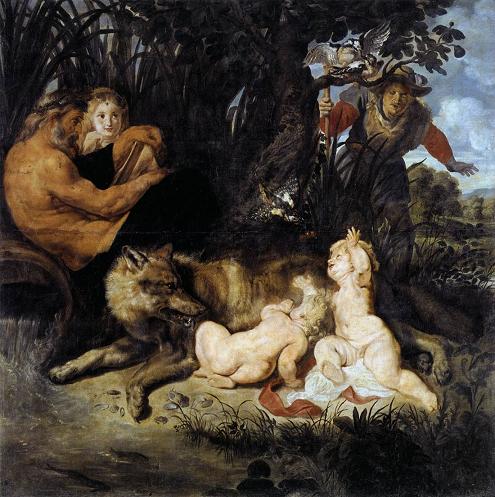
"Romulus
and Remus," by Peter Paul Rubens. Romulus and Remus the founders
of Rome, suckled by a she-wolf beneath a sycamore fig tree.
Notice the
woodpecker bringing food to the boys. It antedates Zeus and the
eagle as the thunder-god, and was the original thunderbird of the
Aryans according to J. Rendel Harris.
Parallel evidence from
texts of a dual, divine leadership in Rome, Scandinavia and India was
demonstrated as early as 1948 by Dumezil in his book Mitra-Varuna
(1988). The evidence presented here was not at his disposal at that
time. Whether the Divine Twins and the dual leadership represent one and
the same or two different instititutions deserves a separate study.
-Kristian Kristiansen, Thomas B. Larsson, The Rise of Bronze Age
Society.
One neglected yet very
significant area of research on the Rg Veda concerns the identity and
role played by the twin Asvins in both early and later soma ceremonies.
The Asvins role in the soma ceremony is fundamental and is connected to
the preparation of a special soma drink that was considered the "divine
soma mead" and "elixir of immortality."
There is ample proof
that it was the legendary Asvins soma drink, prepared during the Rg
Vedic soma ceremony, that was the origin of all the "elixir theories"
later found in many forms of alchemy throughout the world.
The significance of the
Asvins soma drink is even more important when we realize that they are
the divine physicians of the gods. As medical deities, they are
themselves forever young and are forever renewed and rejuvenated by
their soma drink. They are described in the hymns as continually
drinking their soma mixture aboard their chariot yet never becoming
intoxicated; their madhu soma drink induced ecstatic states and brought
about healing, rejuvenation, longevity, and entheogenic experiences
rather than intoxication. Eternal youth is another attribute of the
Asvins special drink, and they bring the aged back to youthfulness with
their drink in special magical rituals. They even aid the gods when they
become unable to help or cure themselves of unusual illnesses or other
strange misfortunes.
The Asvins who are
repeatedly said to be wonderworkers, bring medicines to the priests with
their honey-whipped mixtures. Through them and their soma drink miracles
take place. The Asvins enable the priests to cross over to immortality
and their special mixtures prolong life and are also associated with
various paranormal abilities and direct travel to other worlds.
The soma madhu of the
Asvins is also said to bestow mental alertness. It invigorates its
drinkers and gives bliss and ecstasy. One hymn says, "When Asvins worthy
of our praise, seated in the Farther's house, you bring wisdom and
ecstasy." Even the Asvins are said to be in a state of exalted ecstasy
from drinking their own soma madhu. The Asvins are said to create
devotional ecstasy in the hearts of the priests, who attain joyous entheogenic ecstasy when drinking the madhu.
The Asvins chariot is
called the Madhuvarna (nectar-bearer). The chariot is the drink itself,
comprised of the parts of the flowers and the soma sap nectar from their
nectar chambers. Because of this, the chariot alone is said to bring
ecstasy. As one hymn says, "For ecstasy I call the ecstatic bestowing
chariot, at morning, the inseparable Asvins with their chariot, I call
like Sobhari our father." The chariot, loaded with madhu, arrives
"rapid
as thought, strong and speeding to grant ecstasy." The ecstasy,
exaltation, and bliss are all attributes of a divine hallucinogen or entheogen.
The Asvins have close
ties with the Greek Dioscuri, twins who are said to have been aliens to
Attica and probably came from India, or are at least of Indo-European
descent. The Athenians adopted the twins and then included them into the
greater mysteries. They are usually depicted with star-shaped flowers on
their heads, just like the Asvins. On a striking Attic vase of the fifth
century B.C.E. that portrays the mysteries, the figures of the Dioscuri
can be seen. It is thought that their association with Eleusis may have
arisen from some actual part that their statues played in the mystic
ritual. Since entheogenic plants were used in the Eleusinian Mysteries,
the Dioscuri probably played the same role there as the Asvins do in the
more ancient soma ceremony, that is, as a representation of psychoactive
plants that form a special drink that is mixed with other beverages or
consumed alone for various healing and entheogenic effects.
The gods live and
maintain their immortality by drinking this visionary nectar,
amrta
(ambrosia or mead). "I have partaken wisely of the [madhu]
sweet food,
that stirs good thoughts, best banisher of trouble, the food round which
all deities and mortals, calling it nectar-mead, collect together."
In the Rg Veda, Tvastr,
the artisan of the gods and creator of all forms, is said to drink the
special soma mead. His drink is connected to paranormal methods of
direct creation.
The terms madhu
and soma are both mentioned as the drink to which the Asvins are
invited, and the two are synonymous throughout the Rg Veda: "These are
soma for you to drink madhu." Soma is specifically said to be a madhu
drink, and the Asvins, their color, their chariot, and their horses are
all called madhu. Thus, the entire madhu soma drink comes from the
Asvins.
This was seen as an
alchemical union of the dual principles of day and night, personified as
the sun and moon. This union of sun and moon created the drink that
induced the experience of light as Anthropos within the priests.
The Asvins union of the
sun and moon plants in the Rg Veda soma ceremony is not only the oldest
written form of the creation of the original elixir of immortality, it
is also the oldest documented alchemical ritual for producing the
"elixir of life." This knowledge is very ancient and is found in the
oldest part of the Rg Veda associated with the soma ceremony, as well as
in the art of the Indus Valley cultures. It is the probable origin of
the union of the sun and moon motif found in European alchemical
traditions.
-David L. Spess,
Soma: The Divine Hallucinogen.
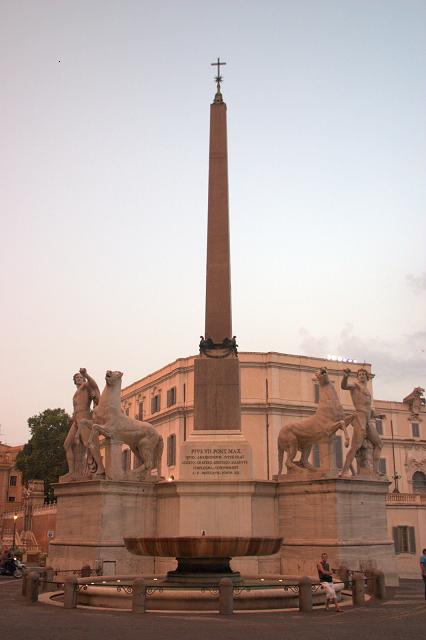
"Fontana dei
Dioscuri" in Rome.
Obelisks were a prominent part of
the architecture of the ancient Egyptians, who placed them in pairs at the
entrance of temples. The obelisk symbolized the sun God Ra,
or Re as some know him, and during the brief religious reformation of
Akhenaten, was said to be a petrified ray of the
Aten, the sundisk. It was also thought that the God
existed within the structure.
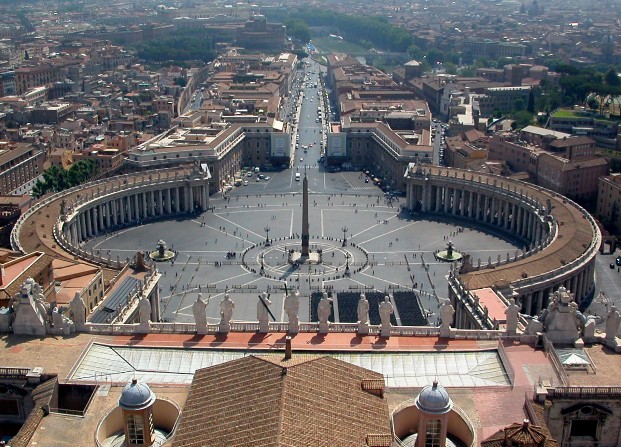
A giant sundial with two mushroom fountains at the
Vatican. The view is due east.
|
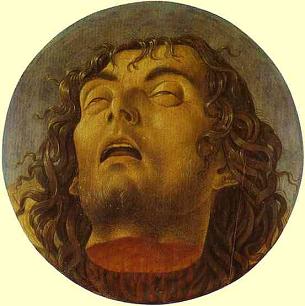
"Head of St.
John the Baptist," by Giovanni Bellini.
The birth of St. John is celebrated on summer
solstice. |
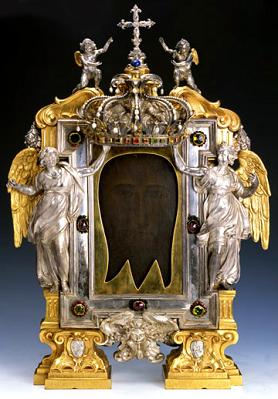
"The Mandylion of
Edessa." The head of Jesus the Christ.
The birth of Jesus is celebrated on winter solstice. |
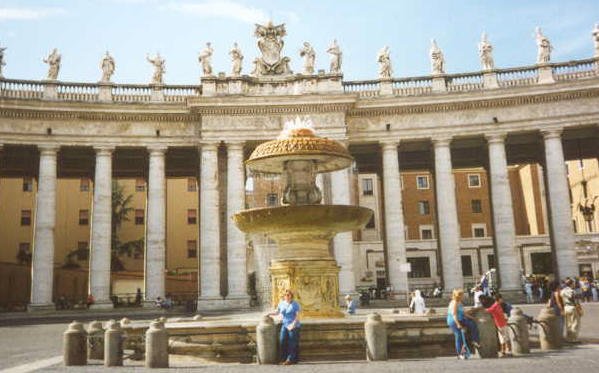
One of the two mushroom fountains.
Maypoles are manifestations of the
same thing as the obelisk. Usually on May 1. people arranged as male-female, and holding onto
multi-colored lanyards connected to the top of the maypole, dance around it.
This dancing around a maypole is still practiced all over the world. These
celebrations descend from fertility rites practiced in spring at the equinox. On
a very small Danish island called Avernakø, situated south of Fyn, lies two
small
villages. In both a pole is raised at Pentecost, in Munke it is called a
"majstang" (maypole), and in Avernak By it is called a "majtræ" (maytree). In
Germany the maypole is always called a "maibaum" (maytree). This tree/pole symbolises
Yggdrasil, Irminsul and the axis mundi.
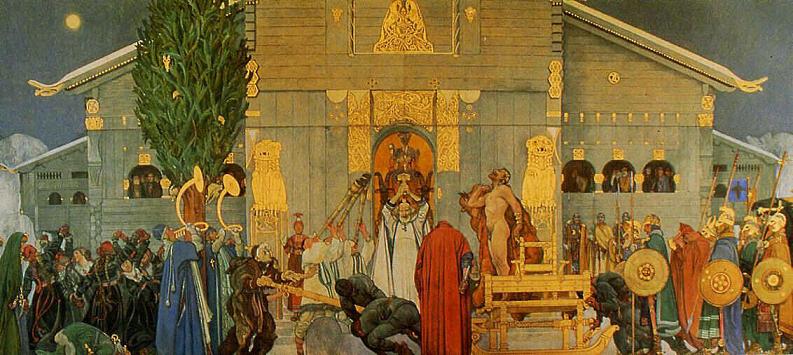
"Vintersolhvervsblót"
("Wintersolsticeblot" at Uppsala temple, Sweden), by Carl Larsson (1915).
In Finland too, especially on the
Åland Islands where ethnic Swedes predominate, the maypole custom is strong.
Atop the maypoles stands the "faktargubbe," a little man carved out of wood who
wears a cap and uniform. He spins and waves his arms in the wind, or as in other
cases four ships are arranged in a cross sailing around the pole, all
reminiscent of the stars turning around the poles.
|
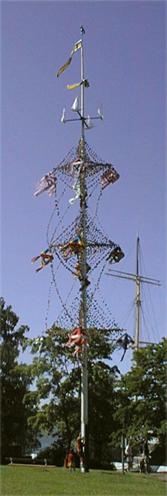 |
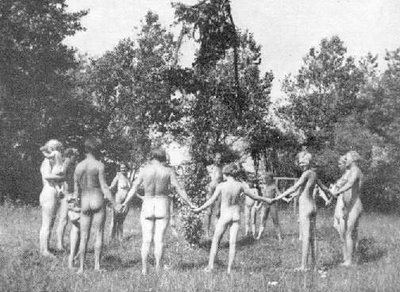
An old picture of a "blot" around the may pole.
|
 |
|
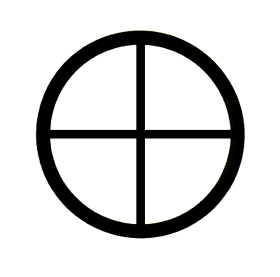 |
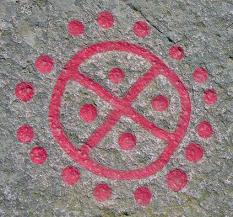
Rock carving
from Madsebakke, Allinge, Bornholm, Denmark. |
 |
The circle with a cross and the circle with a
point are some of the first non-pictorial graphs to appear when humankind was on
the threshold of the Bronze Age. They are common on rock carvings from all over
the world. These symbols derive from the fact that when you take a staff, stick
it vertically in the ground, and then draw a circle around it, you have an
instrument with which the two equinoxes, and summer and winter solstice (and times
slow pace through the year) can be found. The equinoxes are found by marking the
shadow cast by the staff on the circle at sunrise and sunset. The day of the
year, when a line drawn between these two points goes through the staff, that
day is the equinox. This line will run east/west. Summer solstice is on the day
when the midday shadow of the staff is at its shortest, and winter solstice is
on the day when the midday shadow of the staff is at its maximum. This line runs
north/south. Thus the three nails used to crucify Jesus (morning, midday and
evening shadow) and thus the sun cross and the staff of the prophets.
Interestingly, a staff can also be used to find the circumference of the earth as
demonstrated by Eratosthenes around 240 BC, (https://youtu.be/Mw30CgaXiQw).
|
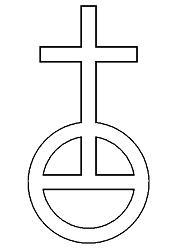
Globus cruciger.
|
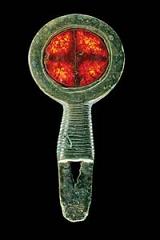
Miniature standard with amber inlay that shows a cross
shape when held against the light. Nordic Bronze Age, National Museum of
Denmark.
|
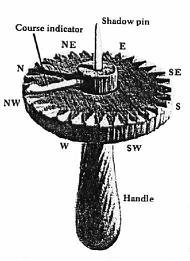
The sun compass. |
During excavations in the Viking "Eastern Settlement" in
Greenland between 1946 and 1948, C. L. Vebæk discovered a section of a small
wooden disk dating from about 1000 AD. The disk, a sun compass, which is a very
elegant instrument because of its simplicity in use, provides the means for
determining true north and thus the heading of a ship to within a few degrees,
provided it is held horizontal.
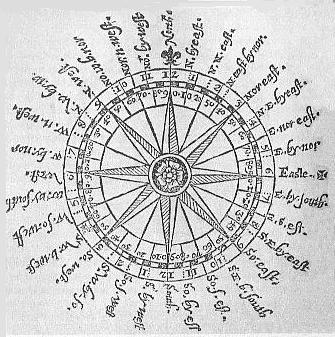
The Sun Cross, as a
compass, with rose, lily and star.
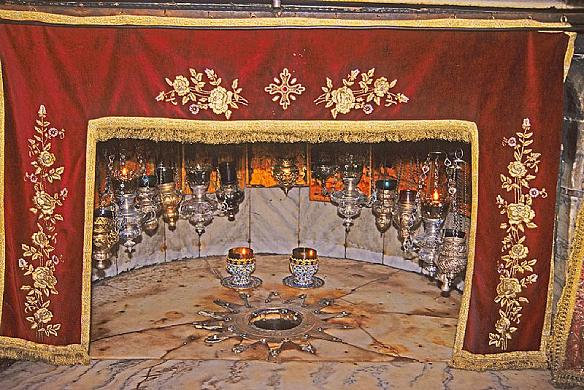
The place where Jesus
was born.
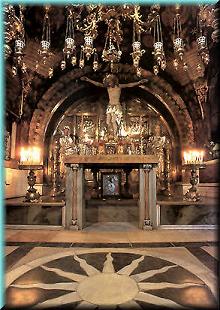
The place where Jesus
was crucified.
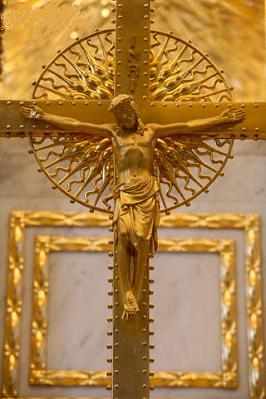
Crucifix at Am Steinhof
Church.
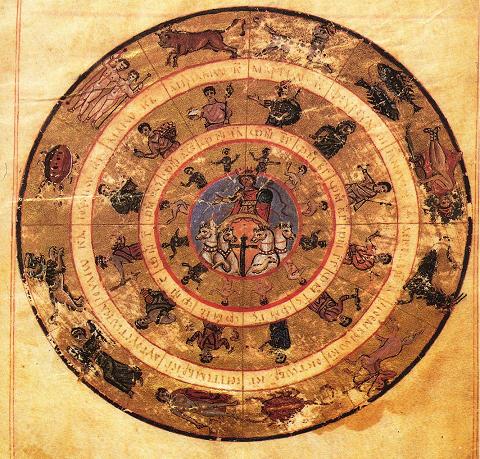
Zodiac and
months from Tetrabiblos of Ptolemaios. Manuscript from the 8th century
AD. Geographia of Ptolemy; Rome, Biblioteca Apostolica Vaticana. Helios
in the centre, identified as the Christ by the cross, twelve naked
female figures represent the hours, twelve clothed apostles represent
the twelve months, and surrounding are the twelve zodiac signs.
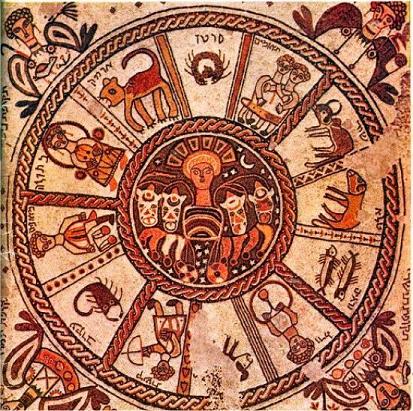
Mosaic floor showing the sun god Helios
surrounded by the zodiac. From Beit Alpha Synagogue, 6th
century AD.
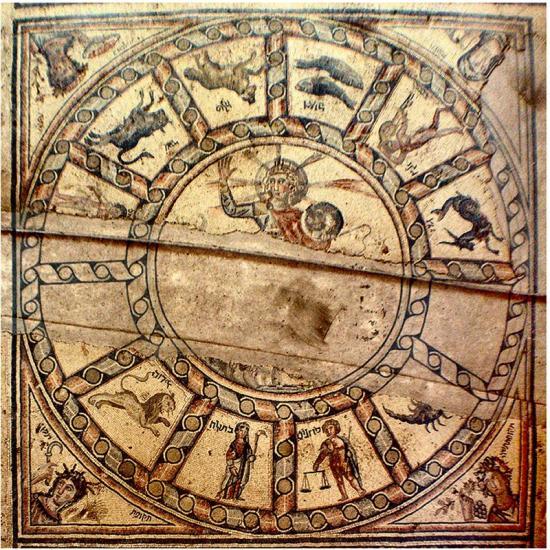
Zodiac mosaic at the Severus Synagogue. In the
center of the large Zodiac is the sun god Helios, riding a celestial
chariot and accompanied by sun, moon and stars.
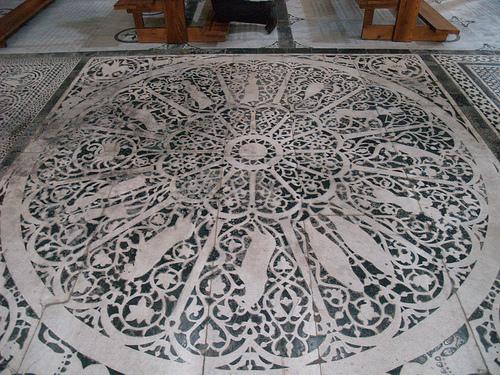
Zodiac from the church of San Miniato in Florence.
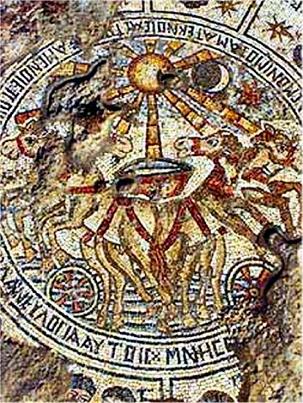
The
Greek sun god Helios (represented as a radiant sun disk) riding
in his quadriga, or four-horse sun chariot. The mosaic floor of
the ancient synagogue was rediscovered in 1993. There is a large
Zodiac around Helios with the names of the months written in Hebrew. From Sepphoris synagogue.
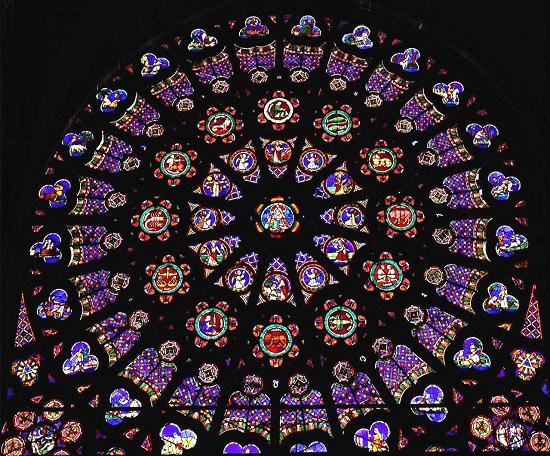
Rose window on north
end of transpet arm, St. Denis Cathedral, St. Denis, France, showing God the
Creator, surrounded by the Days of Creation, the Order of the Heavens
represented by the Zodiac and the Order of Earth as represented by the
Labours of the Months. In the corners are the Fall of Mankind.
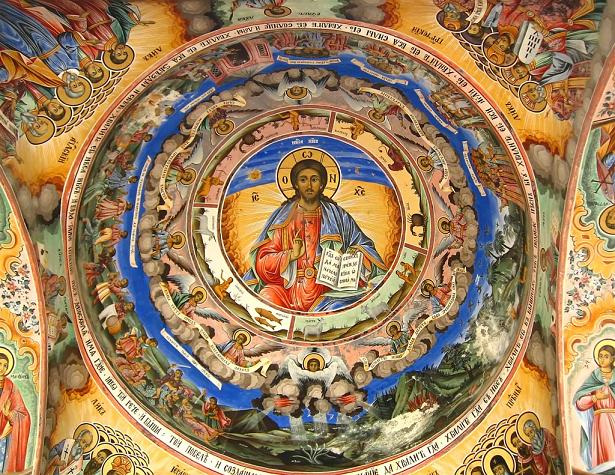
Fresco Paintings from Rila
Monastery.
That which today is called the
Christian religion existed among the Ancients, and has never ceased to
exist from the origin of the human race, until the time when Christ
himself came, and men began to call Christian the true religion which
already existed beforehand.
-St. Augustine.
-Mateus Soares de Azevedo
(editor), Ye Shall Know the
Truth.
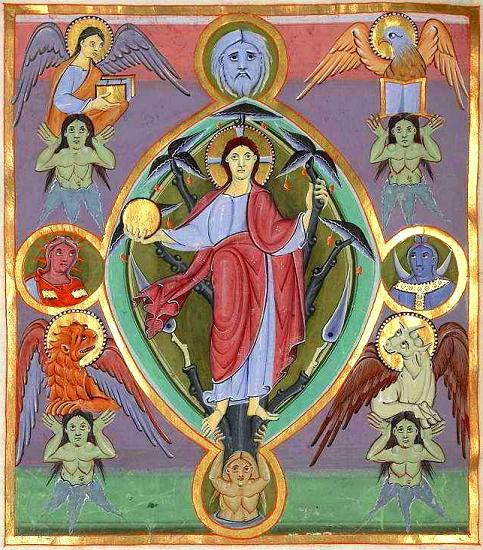
Manuscript illumination from the 10th century,
Reichenau Monastery, Germany; now at the Bayerische Staatsbibliothek,
Clm. 4454.
In Christian iconography the four evangelists is
frequently represented by a human being, a lion, an ox and an eagle, normally,
but not invariably, all shown with wings like angels. These animals originate
from the four "living creatures" that draw the throne-chariot of God, the
Merkabah, in the vision in the Book of Ezekiel and also reflected in the Book of
Revelation, though neither sources links the creatures to the Evangelists.
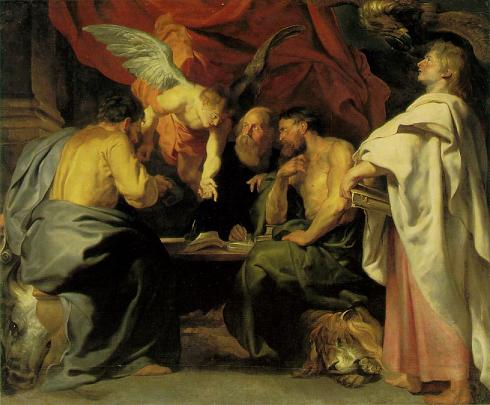
"The Four
Evangelists," by Peter Paul Rubens.
In astrology the sign of Scorpio is sometimes
represented by an eagle or a phoenix, though this depiction is rather esoteric.
Consequently we have the four evangelists represented by four signs of the
zodiac. And just as there was twelve disciples/apostles of Jesus Christ there
are twelve signs in the zodiac.
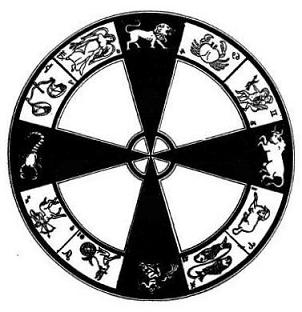
The four creatures associated with the four
evangelists often appear together in the form of a tetramorph, an arrangement of
the creatures which is divided into quarters by a cross, though the order in
which the animals are shown are not always consistent with the zodiac.
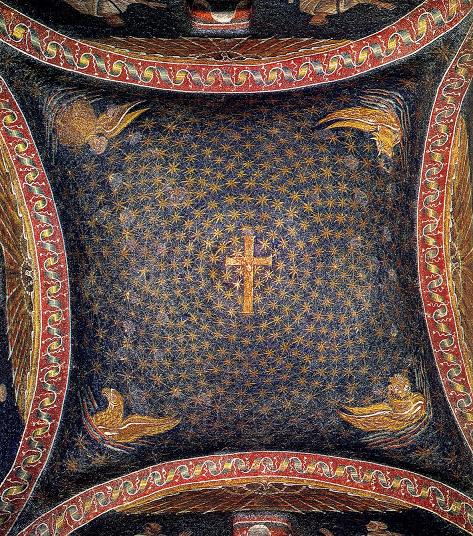
Ravenna,
Galla Placidia, Mosaic Cross in the Sky with symbols of the four
evangelists (ca. 425-430 AD).
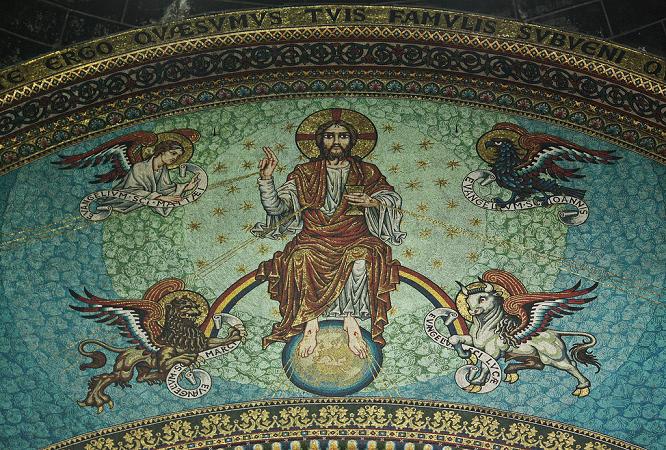
From
Westminster Cathedral, London.
Revelation 13:18.
Here is wisdom. Let him
that hath understanding count the number of the beast: for it is the
number of a man; and his number is Six hundred threescore and six.
-The Bible.
The myth of the number 666 is
closely related to the worship of the pagan Sun-God, practised in ancient
Babylon.
Indeed, the pagans believed that “the
stars controlled the affairs of the human race; hence the science of
astrology claims to interpret the will of the star gods.”
In the Babylonian astrological system, the sun god was the ruler and
main god of the Zodiac, and all gods were considered derivatives of the
sun. The Zodiac is a narrow band about 18 degrees widths making a
complete circuit of the sky around the earth. This was symbolized by a
serpent with his tail in his mouth forming a circle, representing the
endless time or eternal life. Astrology taught that the fate of mankind
was ever decided by the positions of the stars. Now the Chief gods of
the Zodiac were the 7 planets who moved through the 36 rooms of the
Zodiac at varying speeds. The Zodiacal band itself was divided into 12
houses, one for each month of the year, and each house was divided into
3 rooms, making 36 rooms in all, one for each 10 degrees of the Zodiacal
circle. Here we find the origin of our present system of time keeping.
Thus the Zodiac was a heavenly clock. The remainder of the sky outside
of the Zodiacal band was also divided into 36 constellations, 15 on the
south side and 21 on the north side. A god of each constellation was
appointed to rule over one of the 36 rooms of the Zodiac. Every star in
the sky was considered as a god and the abode of the departed spirits.
The star was included in a constellation, over who was appointed a god
who ruled over the Zodiacal room. Each Zodiacal house god rules over a
month of the year, and the 7 planetary gods regulated the affairs of
mankind by their relative position in the various rooms of the Zodiac.
Over them all ruled the sun-god (the all-seeing eye), who was considered
the central fire from which each had sprung.
This pagan system was even adopted by the apostate Israelites for they
worshipped Remphan, the Babylonian Saturnis: “yea, ye took up the
tabernacle of Moloch, and the star of your god Remphan, figures which ye
made to worship them: and I will carry you away beyond Babylon.” (Acts
7:43). This surprisingly complicated system was created so that the
priests of sun worship could predict future events by the way of the
stars travel across the sky. They invented magic charts to preform this
divination. The charts were divided into 36 numbered divisions. There
were 6 column in all directions with the numbers 1 to 36 placed inside
the entire chart. Any direction you add the columns, they add to 111.
There are 6 squares in each column, 6x111. If you add all the numbers
from 1 to 36, they will also add to 666, the sign of the Beast. The
amount of time it takes for Earth to pass through the influence of each
of the 12 signs of the Zodiac is 26.000 years; each Great sign has about
2.100 years. According to the astrologers we are leaving the Age of
Pisces (0 - 2000 AD) and are entering or have entered the Age of
Aquarius, a new age.
-Dan Gold, The World’s Story.

Furthermore, earth has an axial
tilt of 23,4 degrees. Earth rotates once a day about its axis of rotation; this
axis of rotation and the earths orbital plane makes an angle measuring 66,6
degrees. The axis itself rotates (wobbles) slowly, completing a rotation in
approximately 26,000 years. This tilt of the earth’s rotating axis, similar to a
wobbling top, accounts for seasons and the phenomenon known as the precession of
the equinoxes.

In their brilliant and far-reaching
study Hamlets Mill, Professors de Santillana and von Dechend present a
formidable array of mythical and iconographic evidence to demonstrate the
existence of a curious phenomenon. For some inexplicable reason, and at some
unknown date, it seems that certain archaic myths from all over the world were
co-opted (no other word will really do) to serve as vehicles for a body of
complex technical data concerning the precession of the equinoxes. The
importance of this astonishing thesis, as one leading authority on ancient
measurement has pointed out, is that it has fired the first salvo in what may
prove to be “a Copernican revolution in current conceptions of the development
of human culture.”
-Graham Hancock, Fingerprints of the Gods: The Evidence of Earth's Lost
Civilization.
The term zodiac derives from Latin
zodiacus, which in its turn comes from the Greek zodiakos kuklos,
meaning "circle of animals," derived from zodion, the diminutive of
zoon
"animal." And thus we have come full circle. Remember Manly P. Hall’s words
which should make perfect sense now.
According to
Christian mysticism, when the Lost Word is found it is
discovered in a stable, surrounded by beasts and marked by a
star.
-Manly P. Hall,
The Secret Teachings of All Ages.
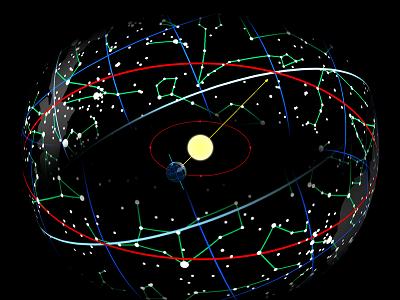
Vernal equinox.
And here the trail ends. As the
observant reader will have noticed, it has been believed, that by ingesting Amanita muscaria and Cannabis
sativa, man becomes the Fountain of Living Waters and God becomes man.
John 4:13-14.
Jesus answered and said unto her,
Whosoever drinketh of this water shall thirst again: But whosoever
drinketh of the water that I shall give him shall never thirst; but the
water that I shall give him shall be in him a well of water springing up
into everlasting life.
-The
Bible.
Therefore Cannabis sativa and all the
prisoners of the drug war must be set free for the betterment of humankind.
Universal Declaration of
Human Rights
Article 18.
Everyone has the right to freedom of
thought, conscience and religion; this right includes freedom to change
his religion or belief, and freedom, either alone or in community with
others and in public or private, to manifest his religion or belief in
teaching, practice, worship and observance.

Appendix a
Appendix b
Appendix c
Bibliography
Allegro, John Marco : The Sacred Mushroom and the Cross.
Allegro, John Marco : The Dead Sea Scrolls
and the Christian myth.
Andrews, Keith : The Nazarenes.
Arthur, James : Mushrooms and Mankind: The Impact of Mushrooms on Human Consciousness and Religion.
Bache, Christopher M. : Dark Night, Early Darn.
Badiner, Allan Hunt & Alex Grey (editors) : Zig Zag Zen: Buddhism and Psychedelics.
Bedrosian, Robert : Soma among the
Armenians.
Benet, Sula : Early Diffusion and Folk Uses
of Hemp.
Bennett, Chris, Neil Mcqueen : Sex, Drugs,
Violence and the Bible.
Bennett, Chris, Lynn Osburn & Judy Osburn : Green Gold the Tree of Life: Marijuana in Magic & Religion.
Boehme, Jacob : The Way to Christ.
Bushby, Tony : The Twin Deception.
Crowley, Mike : The Secret Drugs of Buddhism.
Crowley, Mike : When the gods drank urine.
Cruttenden, Walter : Lost Star of Myth and Time.
DeKorne, Jim : Psychedelic Shamanism: The Cultivation, Preparation and Shamanic Use of Psychotropic Plants.
de Santillana, Giorgio & Hertha von Dechend :
Hamlet's Mill.
Devereux, Poul : The Long Trip : The Prehistory of Psychedelia.
Forte, Robert (editor) : Entheogens and the Future of Religion.
Frank, Mitchell Benjamin : German Romantic
Painting Redefined: Nazarene tradition and the narratives of Romanticism.
Freke, Timothy & Peter Gandy : Jesus and the lost Goddess.
Golas, Thaddeus : The Lazy Mans Guide To Enlightenment.
Griffith, Ralph T. H. : Hinduism: The Rig Veda. (Book 9)
Grof, Stanislaw : Book of the Dead: Manuals for Living and Dying.
Grof, Stanislaw : The Cosmic Game: Explorations of the Frontiers of Human Consciousness.
Grof, Stanislaw : Psychology of the Future: Lessons from Modern Consciousness Research.
Haarder, Andreas : Sangen om Bjovulf.
Hajicek-Dobberstein, S. :
Soma siddhas and alchemical enlightenment: psychedelic mushrooms in Buddhist
tradition,
Journal of Ethnopharmacology 48 (1995) 99-118, Elsevier, The Hague.
Hall, Manly P. : The Secret Teachings of All Ages.
Harding, Patrick : Christmas Unwrapped.
Harris, J. Rendel : Boanerges.
Harris, J. Rendel : The Cult Of The Heavenly
Twins.
Harris, J. Rendel : The Dioscuri in the
Christian Legends.
Heaney, Seamus : Beowulf.
Heinricksen, Clark : Magic Mushrooms in Religion and Alchemy.
Herer, Jack : The Emperor Wears No Clothes: The Authoritative Historical Record of Cannabis and the Conspiracy Against Marijuana.
Hofmann, Albert : Insight Outlook.
Hofmann, Albert : LSD. My problem child
Hogberg, Ole : Flugsvampen och Manniskan.
Irvin, Jan & Andrew Rutajit : Astrotheology and Shamanism: Unveiling the Law of Duality in Christianity and other Religions.
Kruger, Henrik : Smukke Serge og heroinen.
Nixons, mafiaens og agenternes kamp om det hvide guld.
Kubby, Steve : The Politics of Consciousness : A Practical Guide to Personal Freedom.
Larsen, Alex Frank : De spraengte sind. Hemmelige forsoeg med LSD.
Leary, Timothy : Your Brain Is God.
List, Edgar A. : Is Frau Holda the Virgin Mary?
Livergood, Norman D. : The Perennial Tradition: The Secret Legacy--The Single Stream of Initiatory Teaching Flowing Through All the Great Schools of Mysticism.
Lumbye, Joergen : Brug og misbrug. Vi er alle paa stoffer.
Marks, John : The Search for the Manchurian Candidate: The CIA and Mind Control.
Matthews, Leslie G. : SS.
Cosmas and Damian - Patron Saints of Medicine and Pharmacy, Their Cult in
England.
McKenna, Terence : Food of the Gods.
Merillat, Herbert Christian : The Gnostic Apostle Thomas.
Merkur, Dan : The mystery of Manna : The Psychedelic Sacrament of the Bible.
Merkur, Dan : ThePsychedelic Sacrament : Manna, Meditation and the Mystical Experience.
Metzner, Ralph (editor) : Teonanacatl : Sacred Mushroom of Visions.
Morgan, Adrian : Toads and Toadstools: The Natural History, Folklore, and Cultural Oddities of a Strange Association.
Mukherjee, Sj. Braja Lal : The Soma Plant.
Narby, Jeremy : The Cosmic Serpent : DNA and the Origin of Knowledge.
O'Flaherty, Wendy Doniger (translator) : The Rig Veda.
Pinchbeck, Daniel : Breaking Open the Head : A Psychedelic Journey into the Heart of Contemporary Shamanism.
Puharich, Andrija : Sacred Mushroom Key to the Door of Eternity.
Renterghem, Tony van : When Santa Was a Shaman: The Ancient Origins of Santa Claus & the Christmas Tree.
Riedlinger, Thomas J. (editor) : The Sacred Mushroom Seeker : Tributes to R. Gordon Wasson.
Roberts, Thomas B. (editor) : Psychoactive Sacramentals: Essays on Entheogens and Religion.
Roob, Alexander : Alchemy & Mysticism : The Hermetic Museum.
Ruck, Carl A. P. : Sacred Mushrooms of the Goddess.
Ratsch, Christian, Surendra Bahadur Shahi and Claudia Muller-Ebeling : Shamanism and Tantra in the Himalayas.
S, Acharya : Suns of God: Krishna, Buddha and Christ Unveiled.
S, Acharya : The Christ Conspiracy.
Samorini, Giorgio : Animals and Psychedelics : The Natural World and the Instinct to Alter Consciousness.
Samorini, Giorgio :
Kuda-kallu: umbrella-stones or mushroom-stones?
(Integration, vol. 6, pp. 33-40, 1995)
Smith, Huston : Cleansing the Doors of Perception : The Religious Significance of Entheogenic Plants and Chemical.
Spess, David L. : Soma : The Divine Hallucinogen.
Strassman, Rick : DMT : The Spirit Molecule.
Teeter, Donald E. : The Sacred Secret.
Teeter, Donald E. : Amanita Muscaria; Herb of
Immortality.
Venus, & Hawk : Soma Shamans.
Walker, Ethan : The Mystic Christ.
Ward, Donald : The Divine Twins. An
Indo-European Myth in Germanic Tradition.
Wasson, R. Gordon : Soma: Divine Mushroom of Immortality.
Wasson, R. Gordon, Carl A. P. Ruck, Albert Hofmann : The Road To Eleusis: Unveiling the Secret of the Mysteries.
Wasson, R. Gordon, Stella Kramrisch, Carl Ruch, Jonathan Ott : Persephone's Quest : Entheogens and the Origins of Religion.
Watts, Allan : The Book : On the Taboo Against Knowing Who You Are.
White, David Gordon : Myth of the Dog-Man.
Wilhelm, Richard, (translator) : The Secret of the Golden Flower: A Chinese Book of Life.
Wilson, Peter Lamborn : Ploughing the Clouds : The Search for Irish Soma.
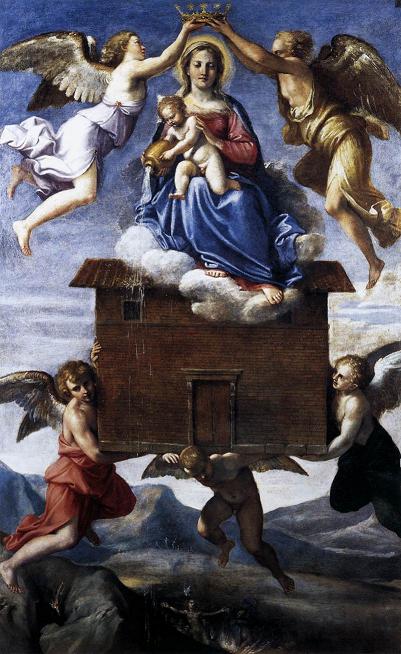
"Translation
of the Holy House," by Annibale Carracci.
May God Bless You
Contact

|













